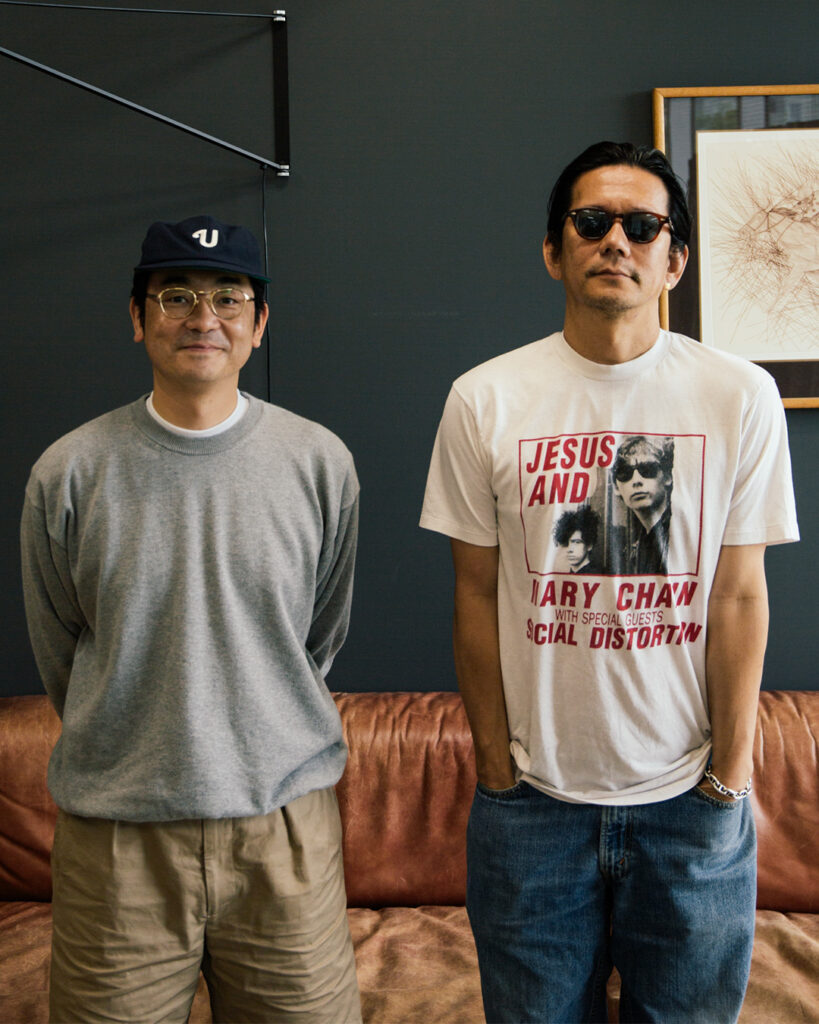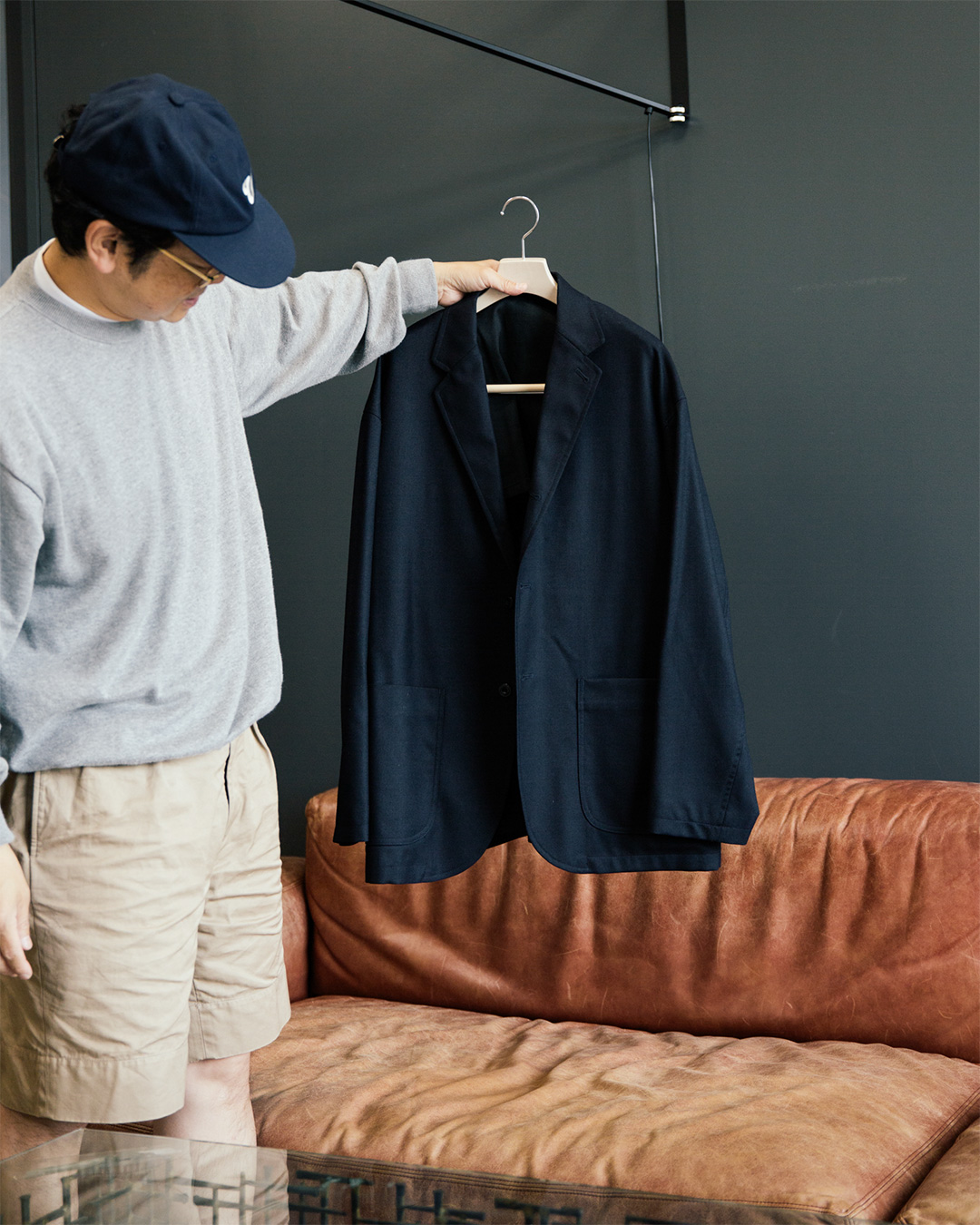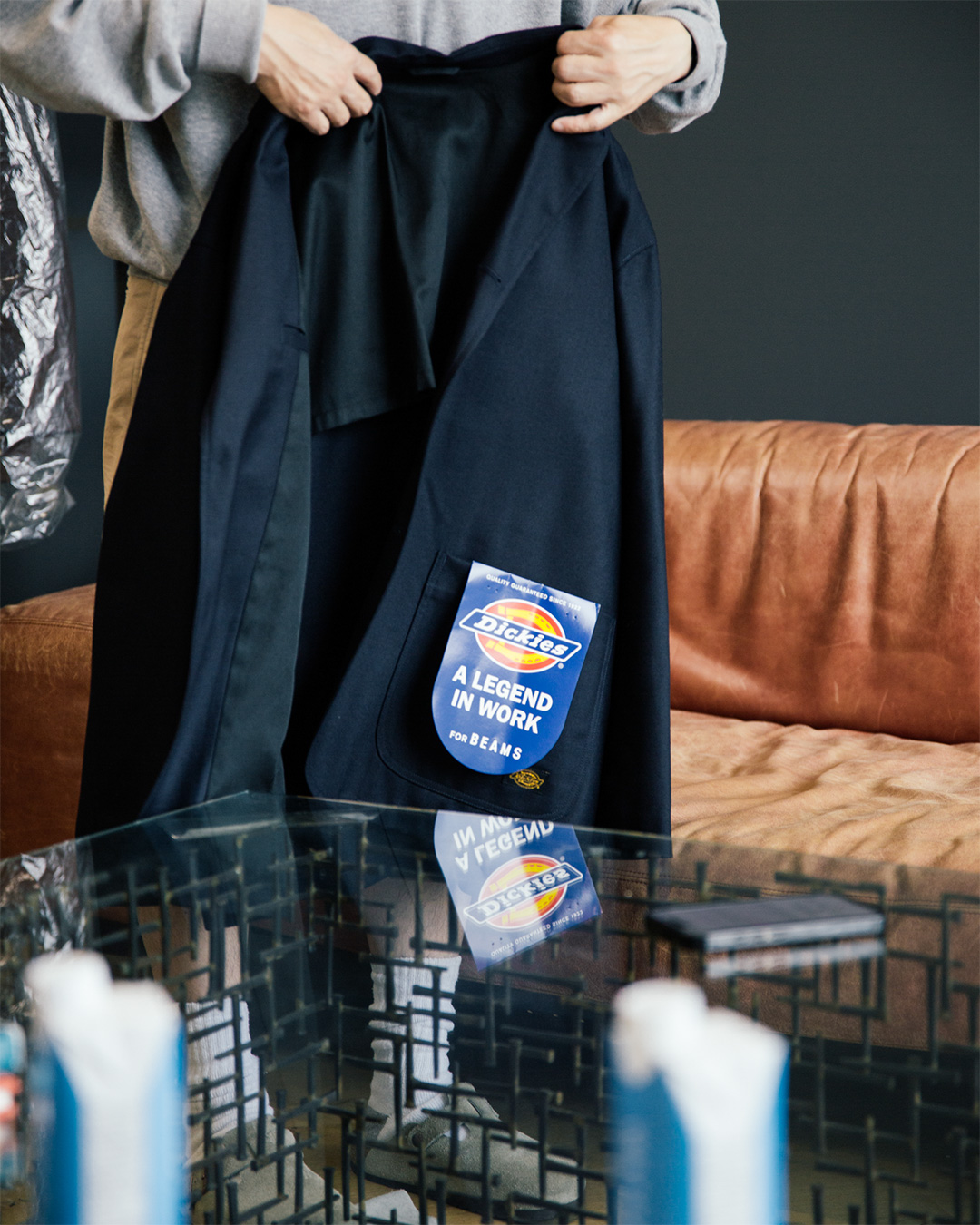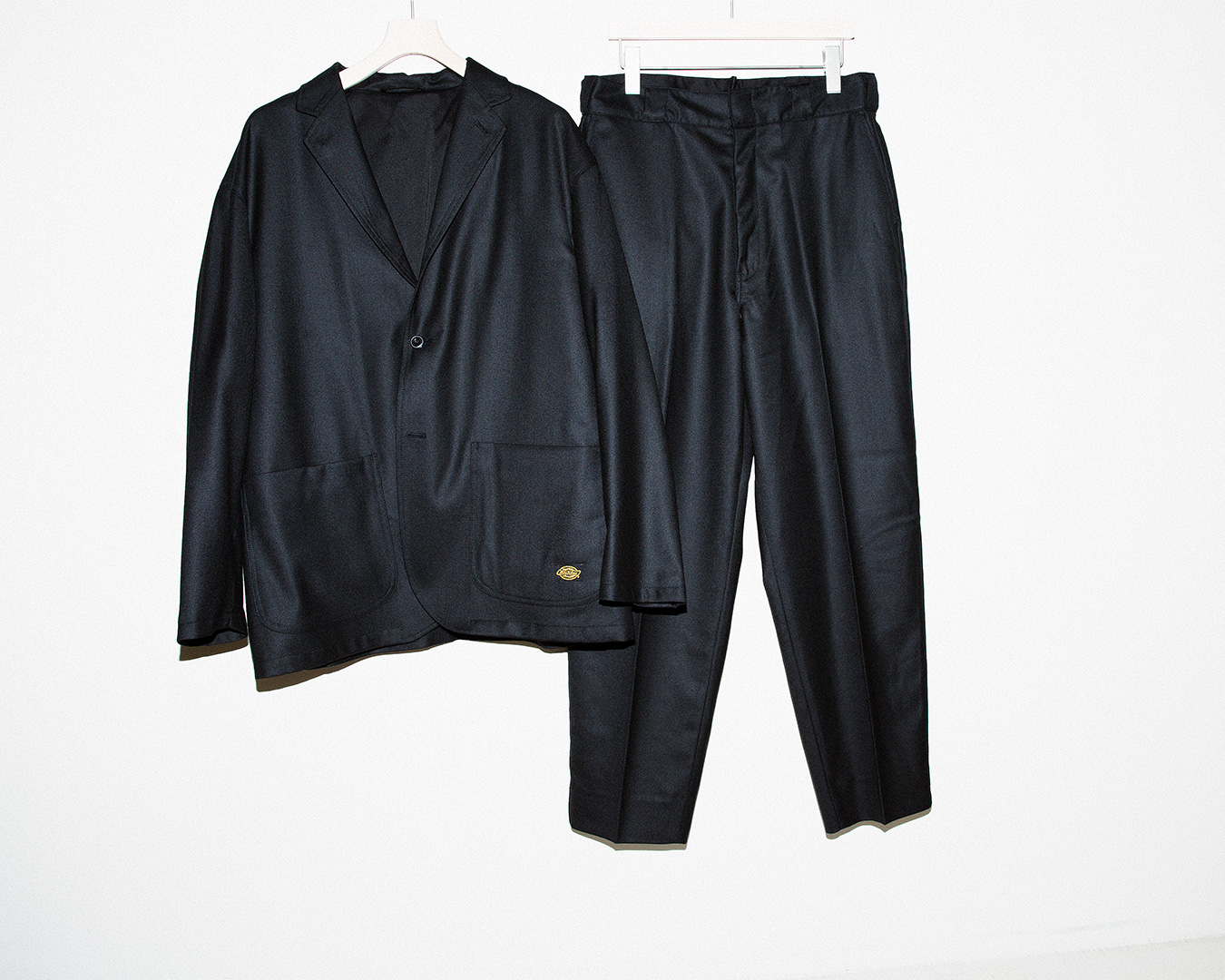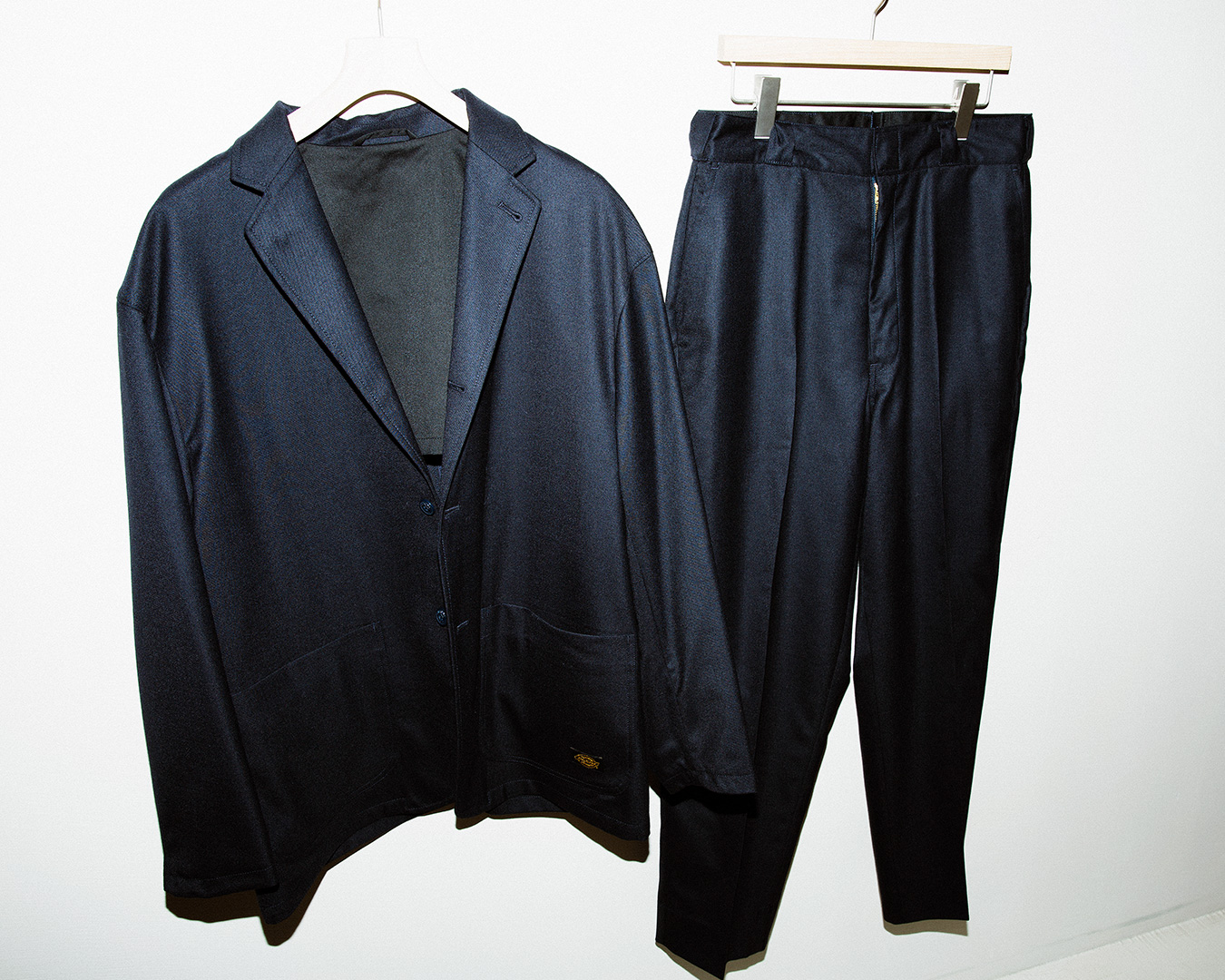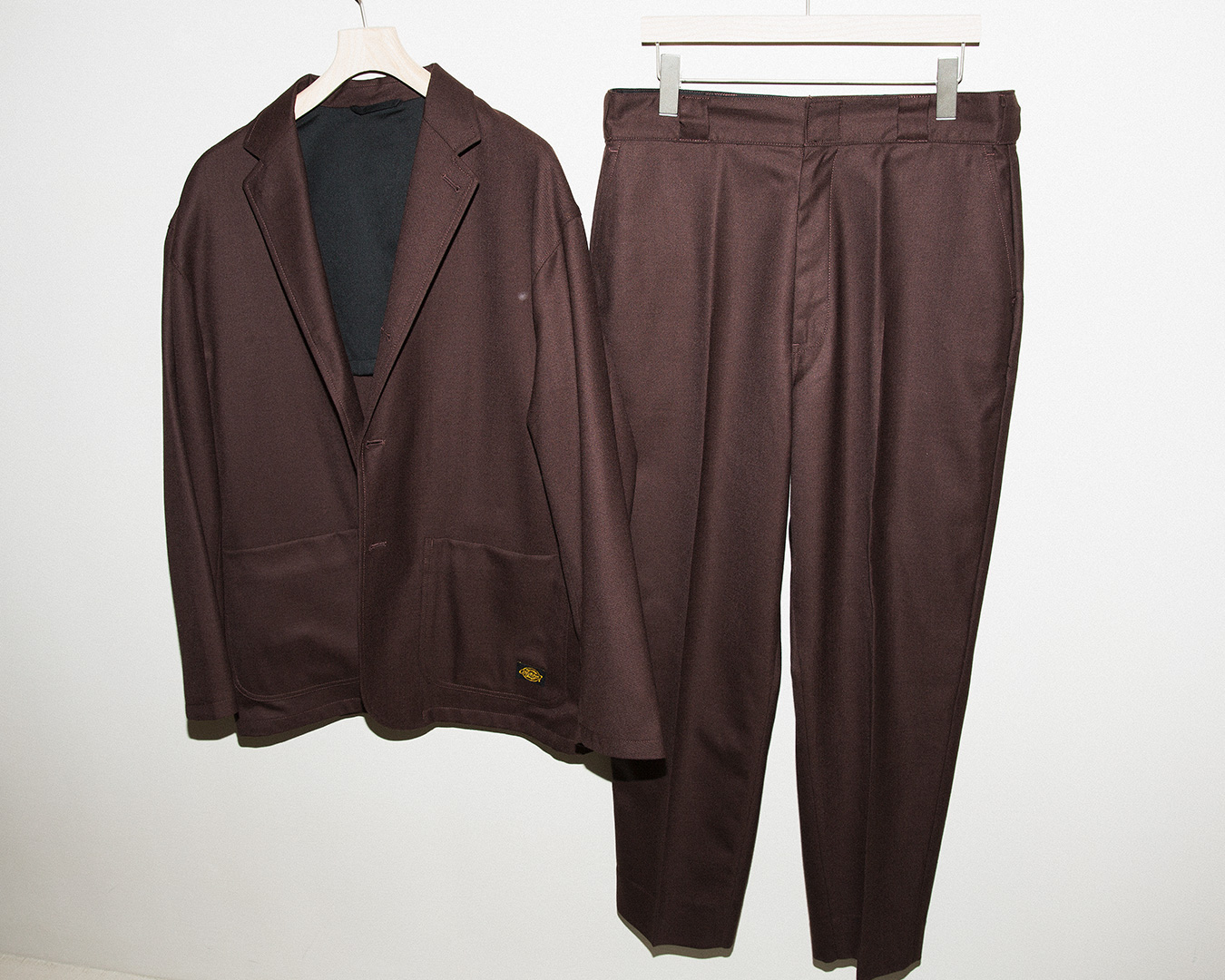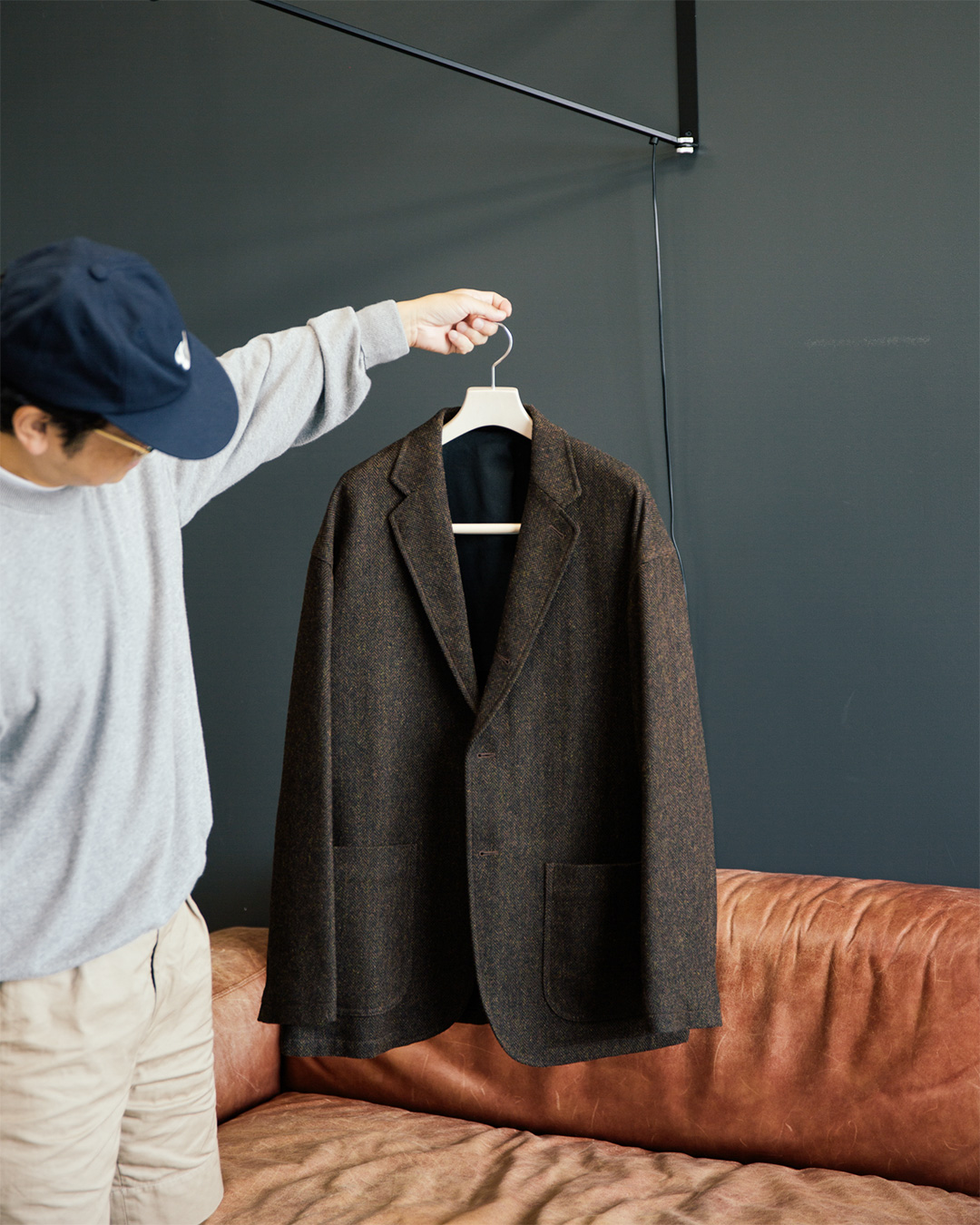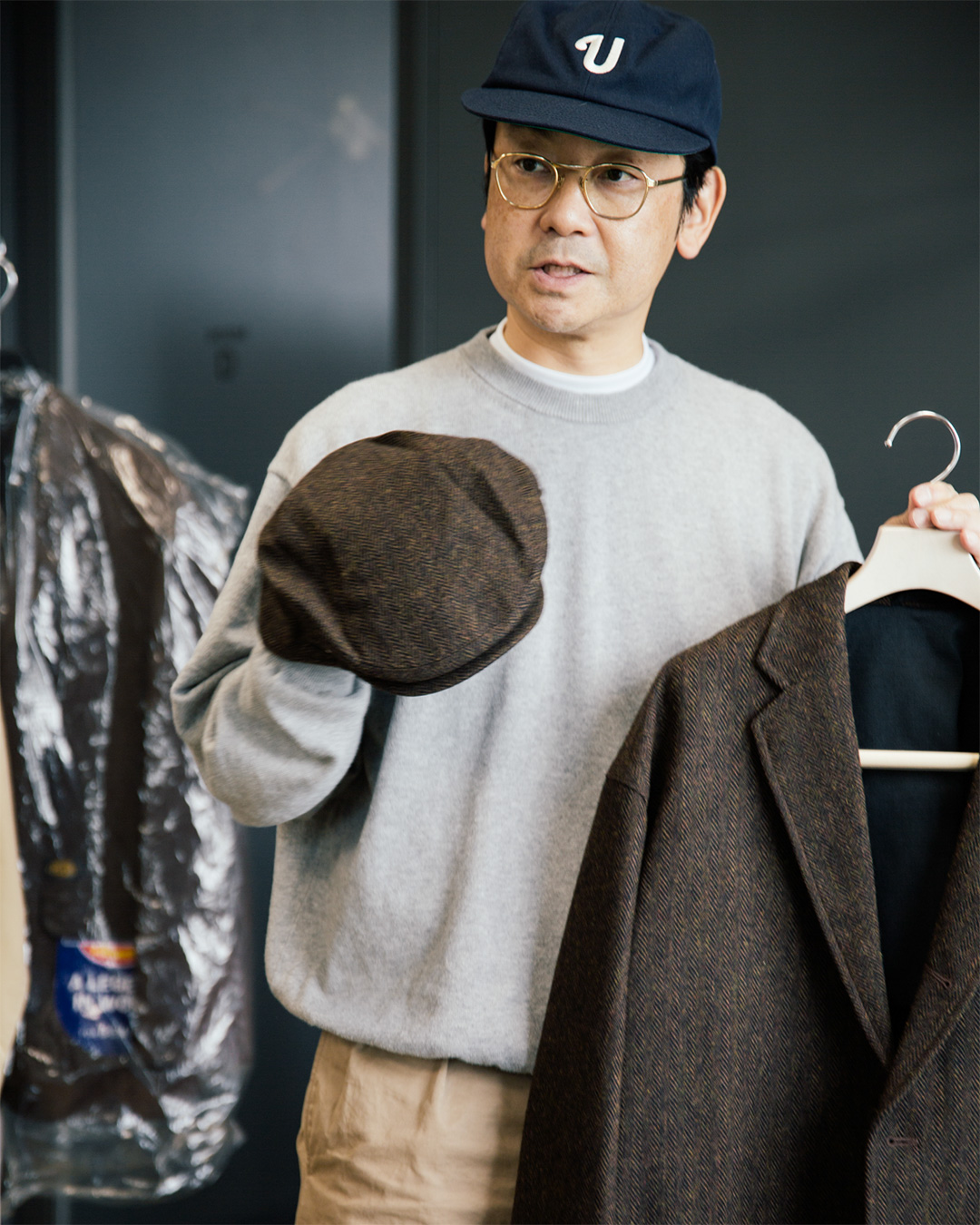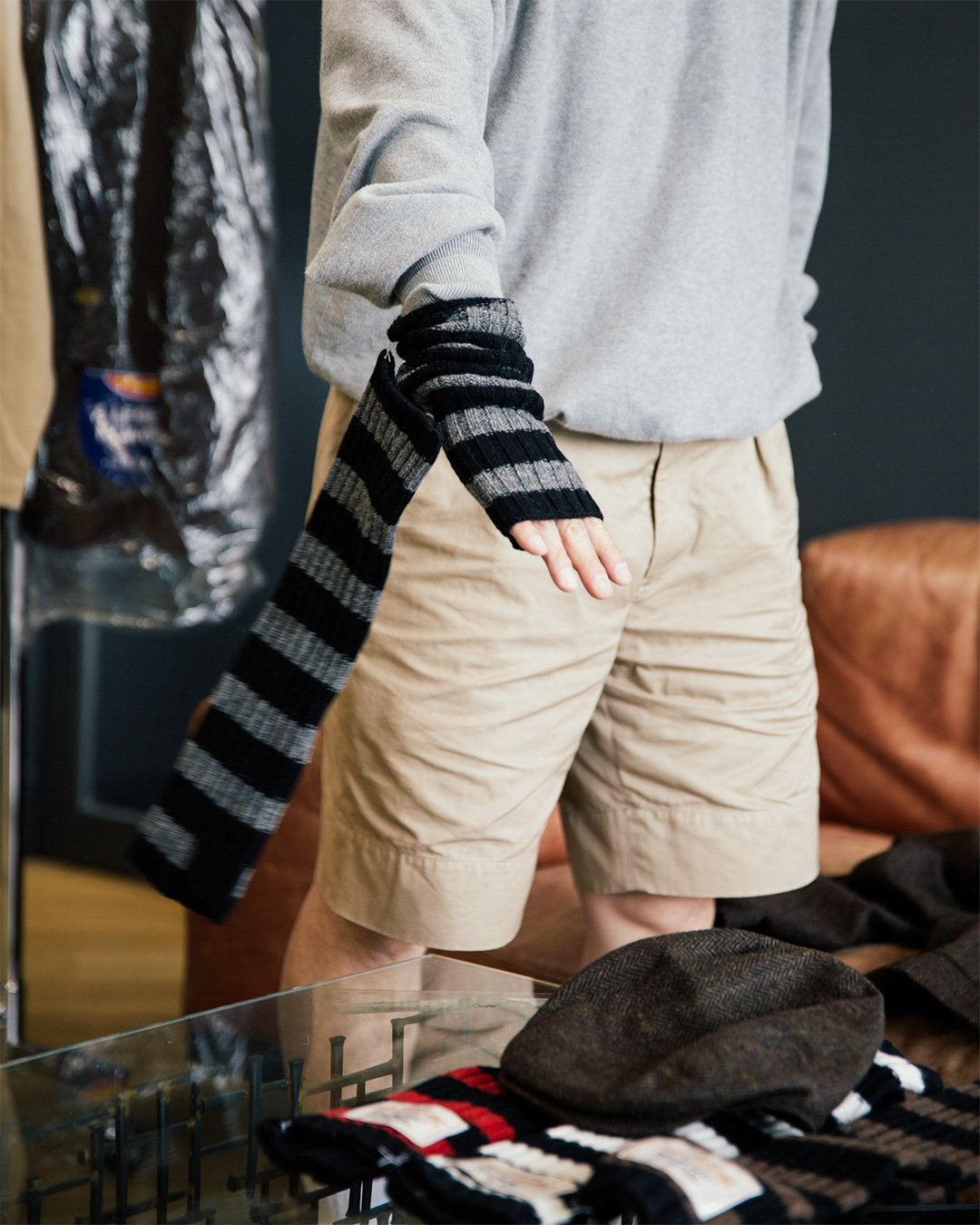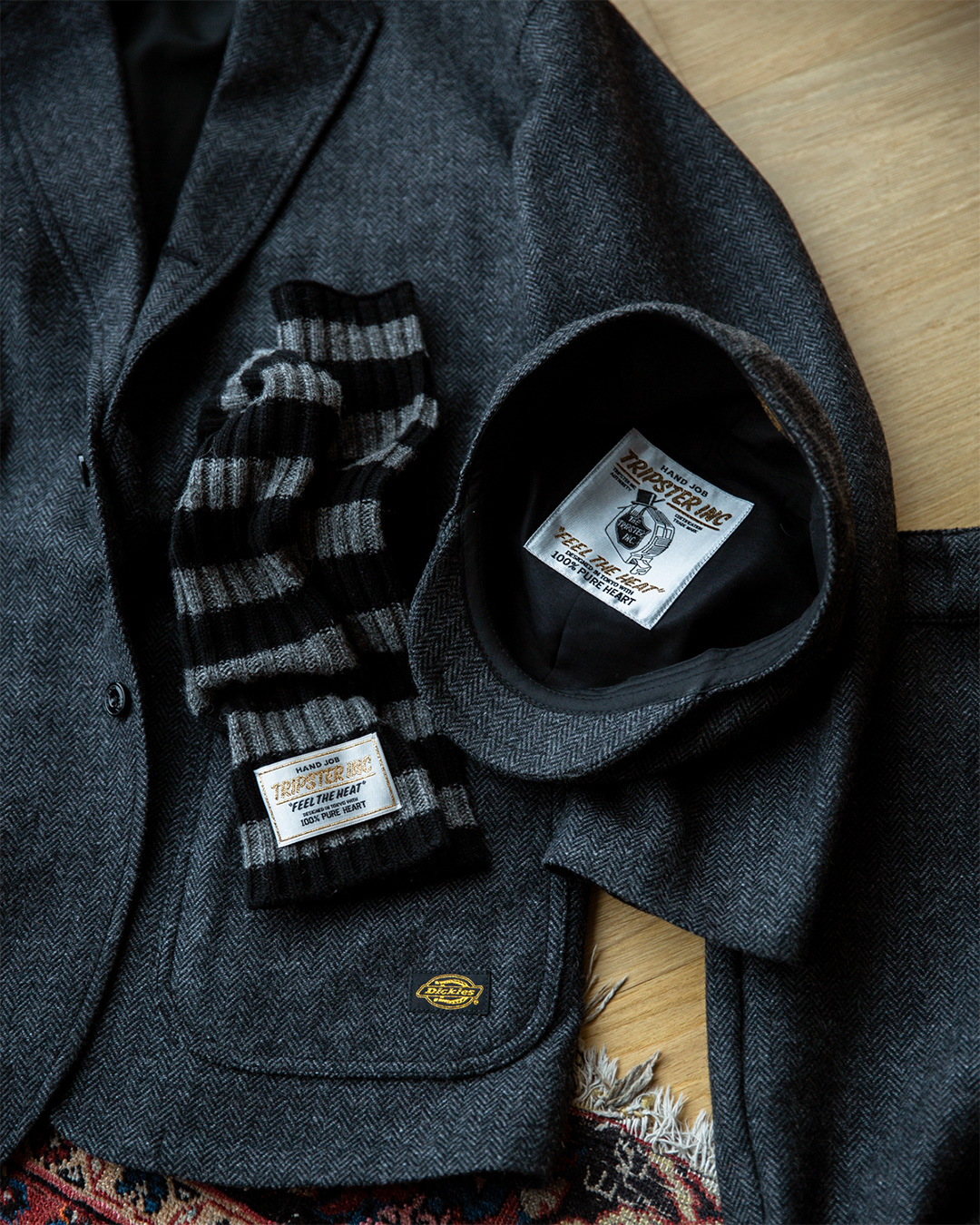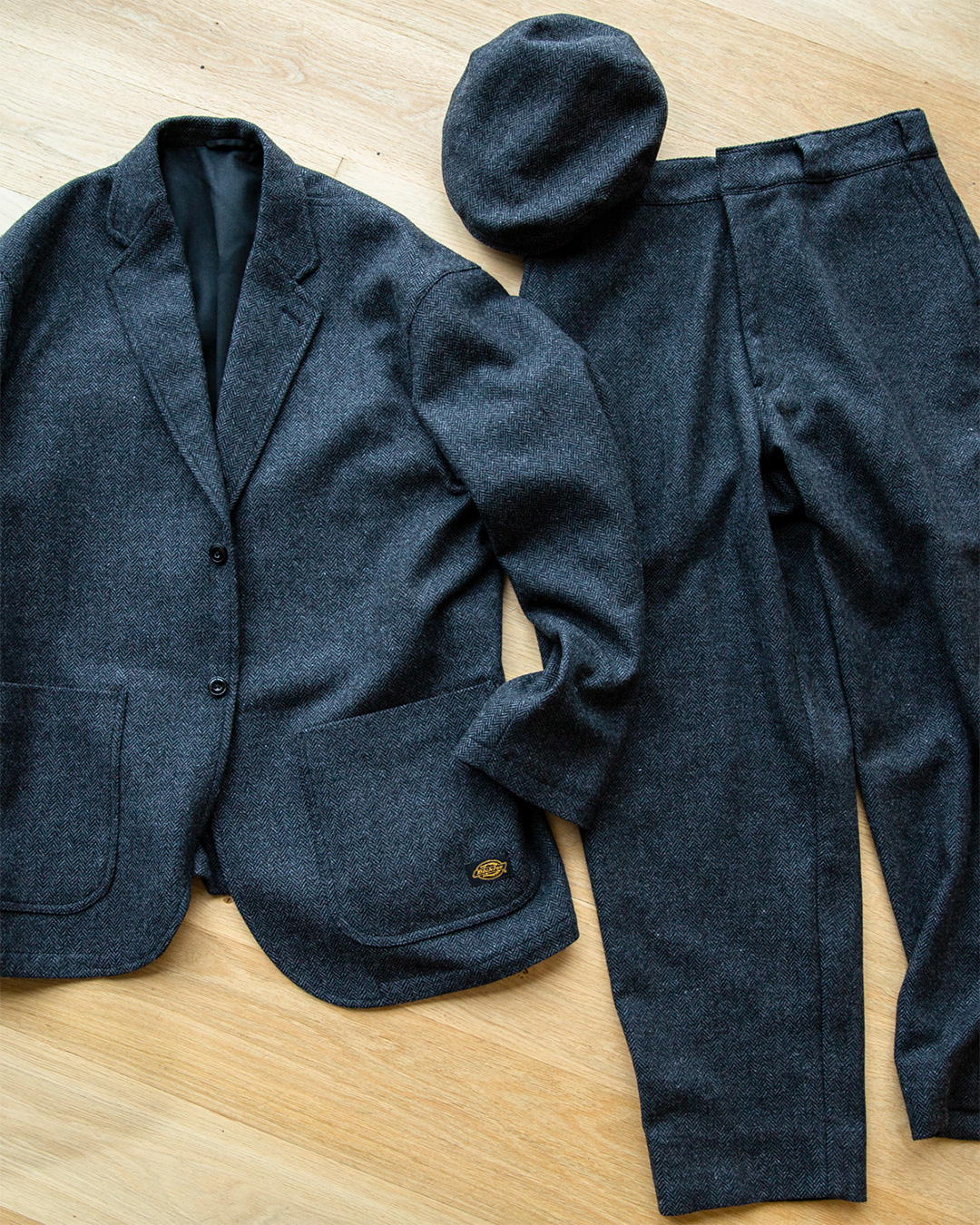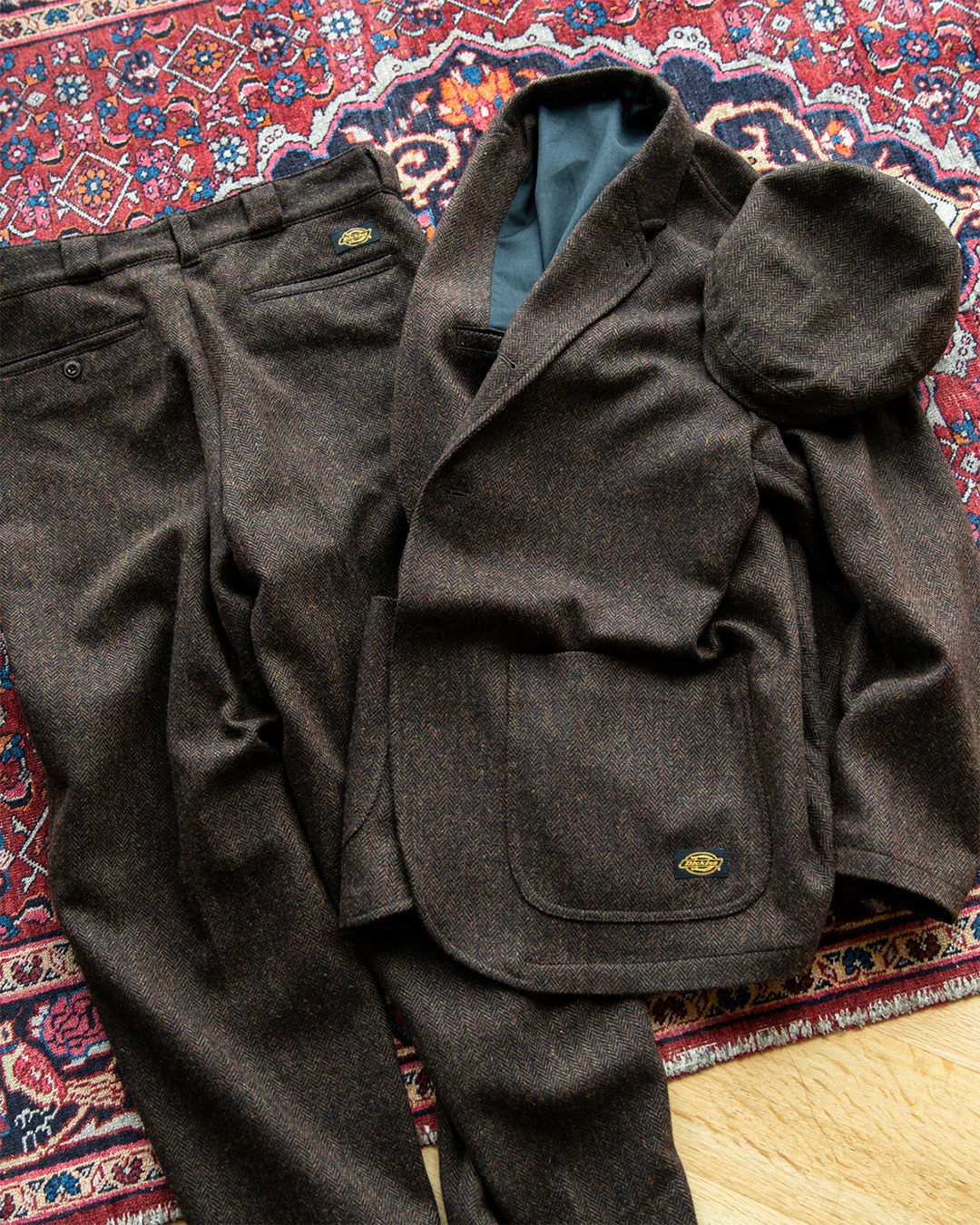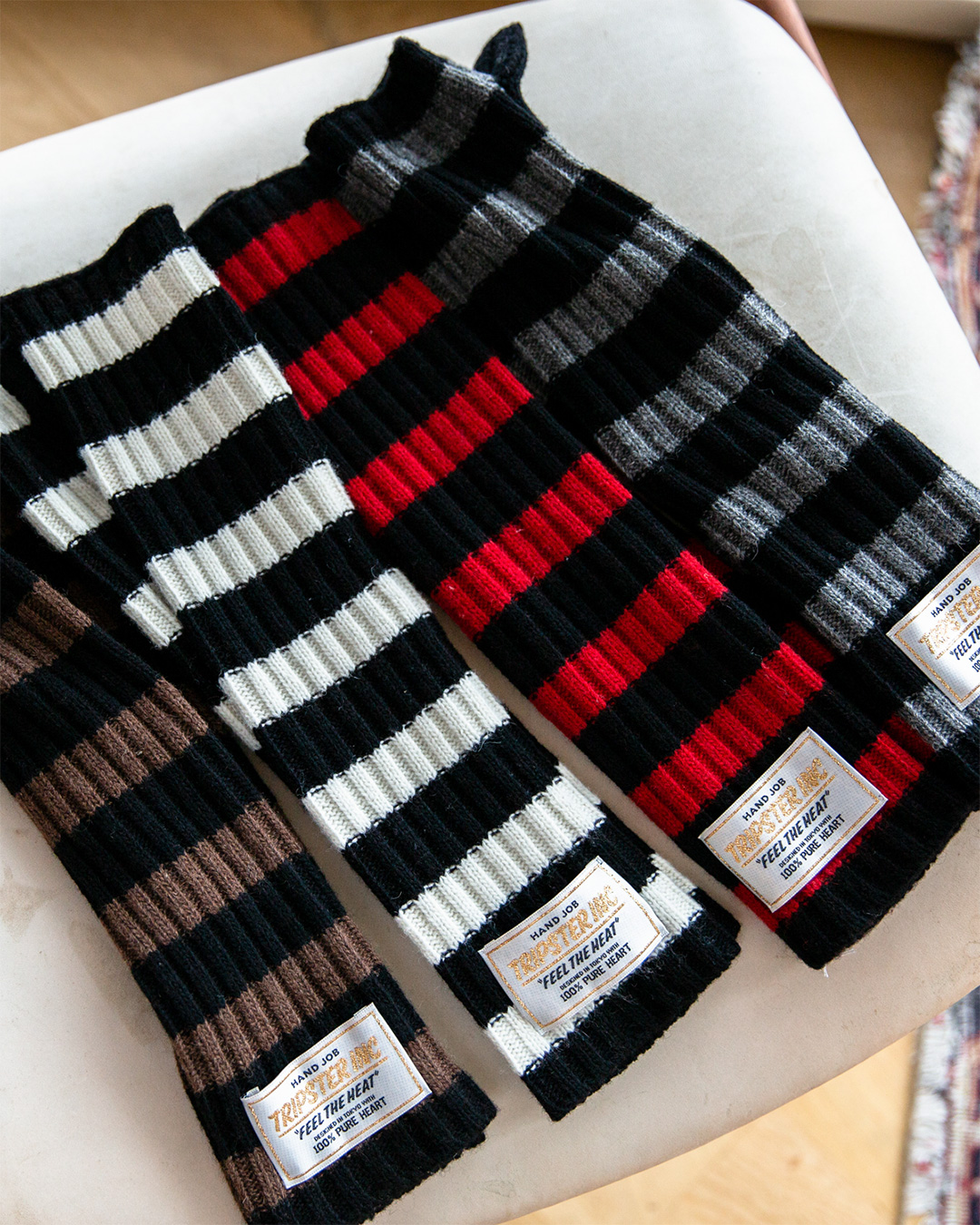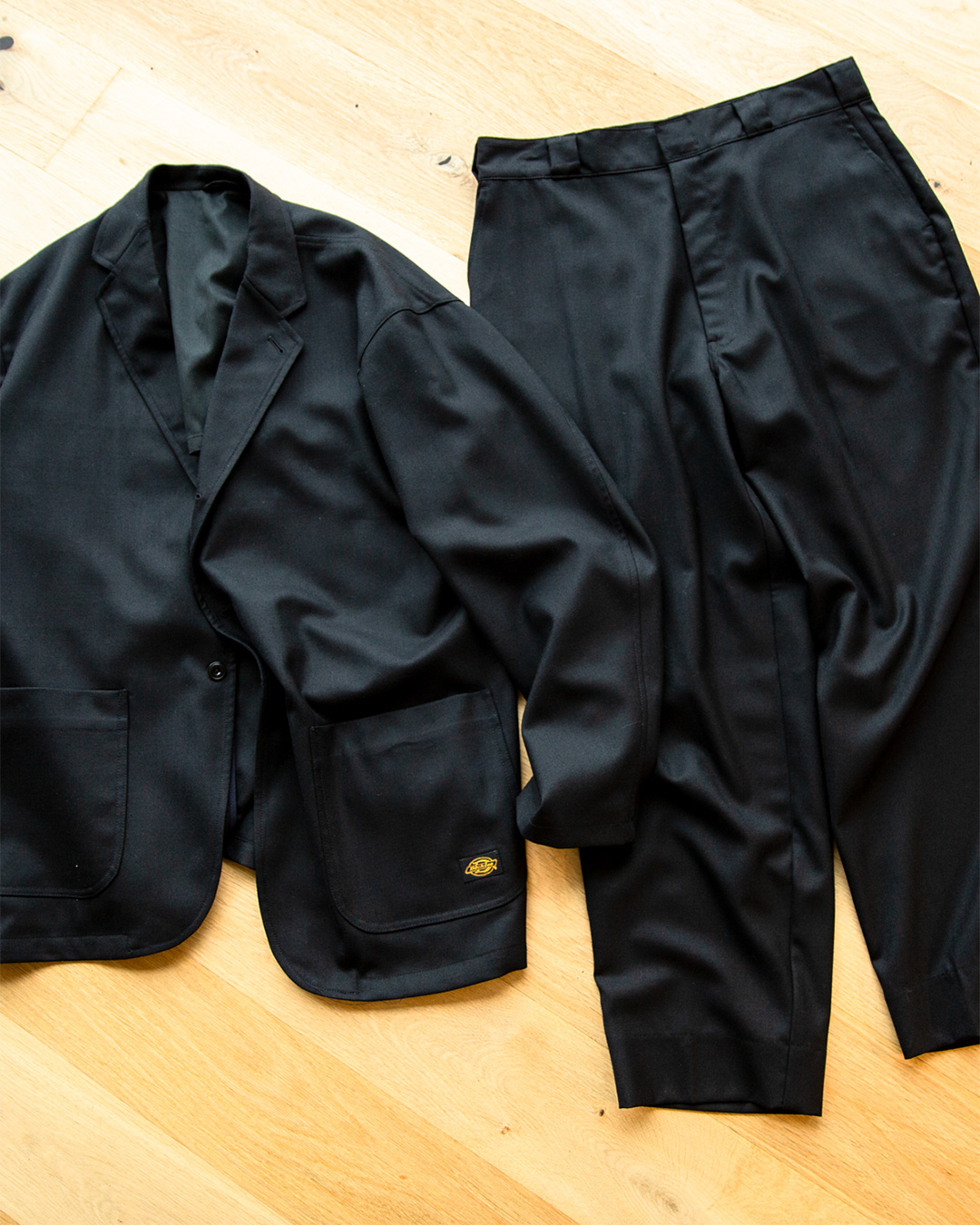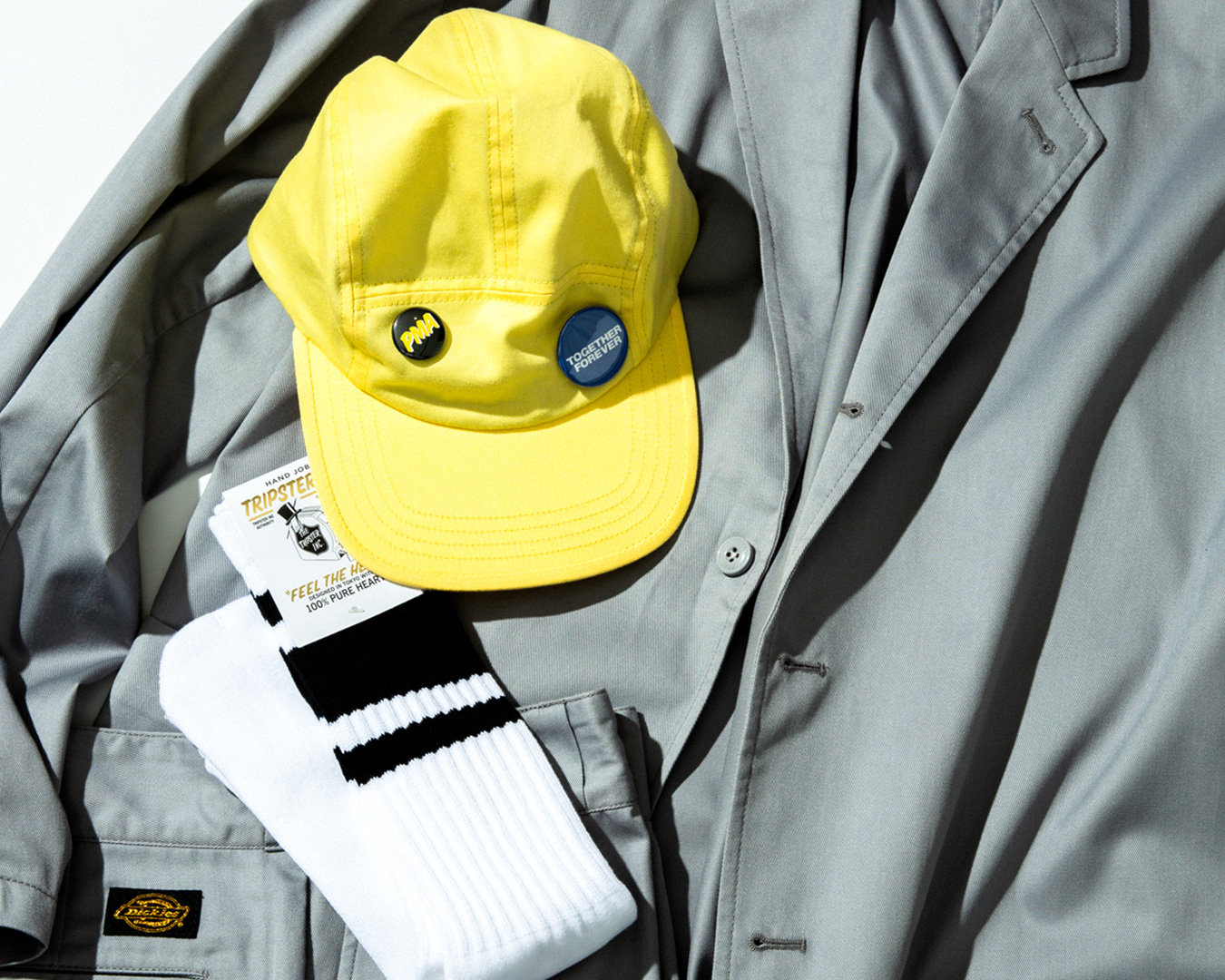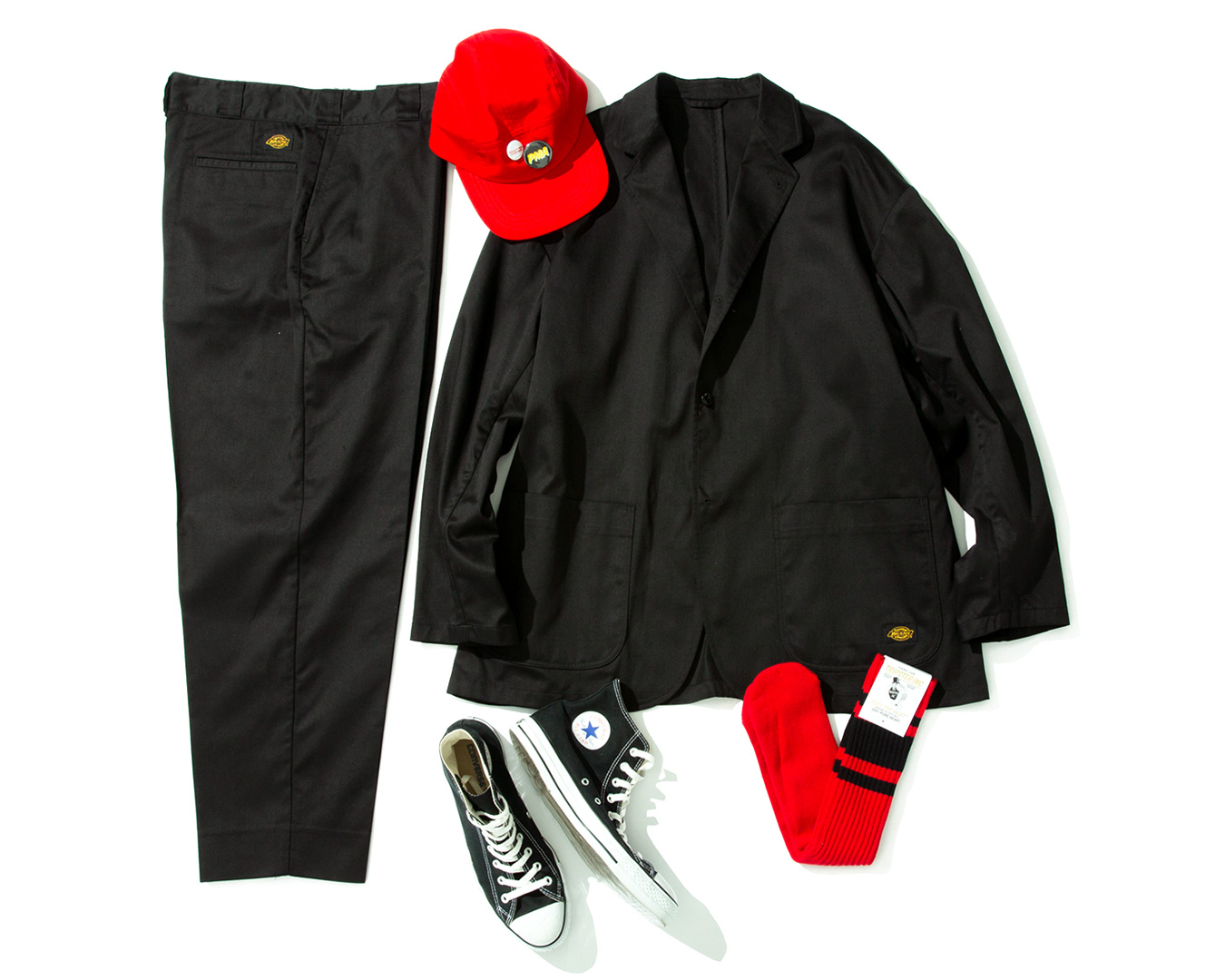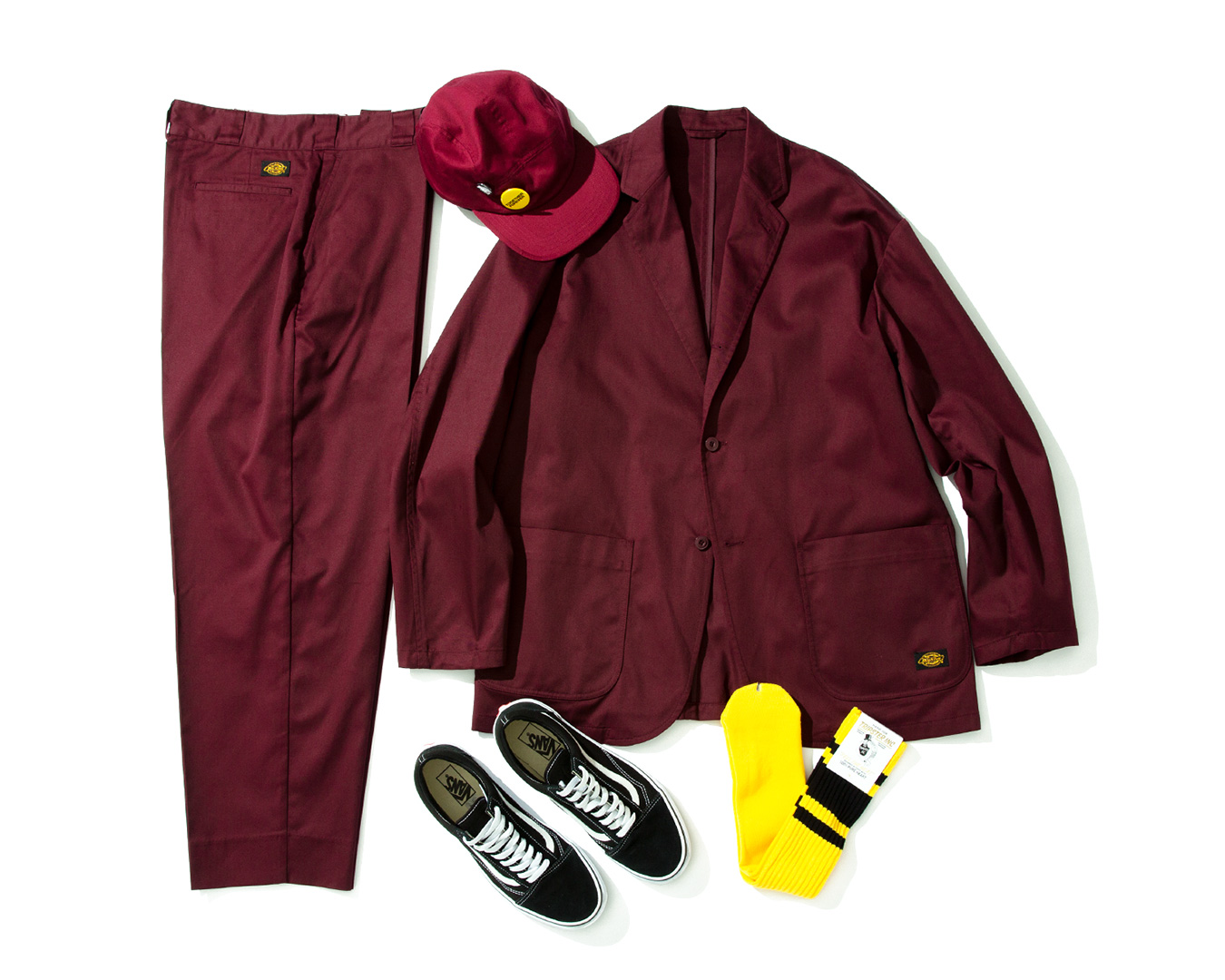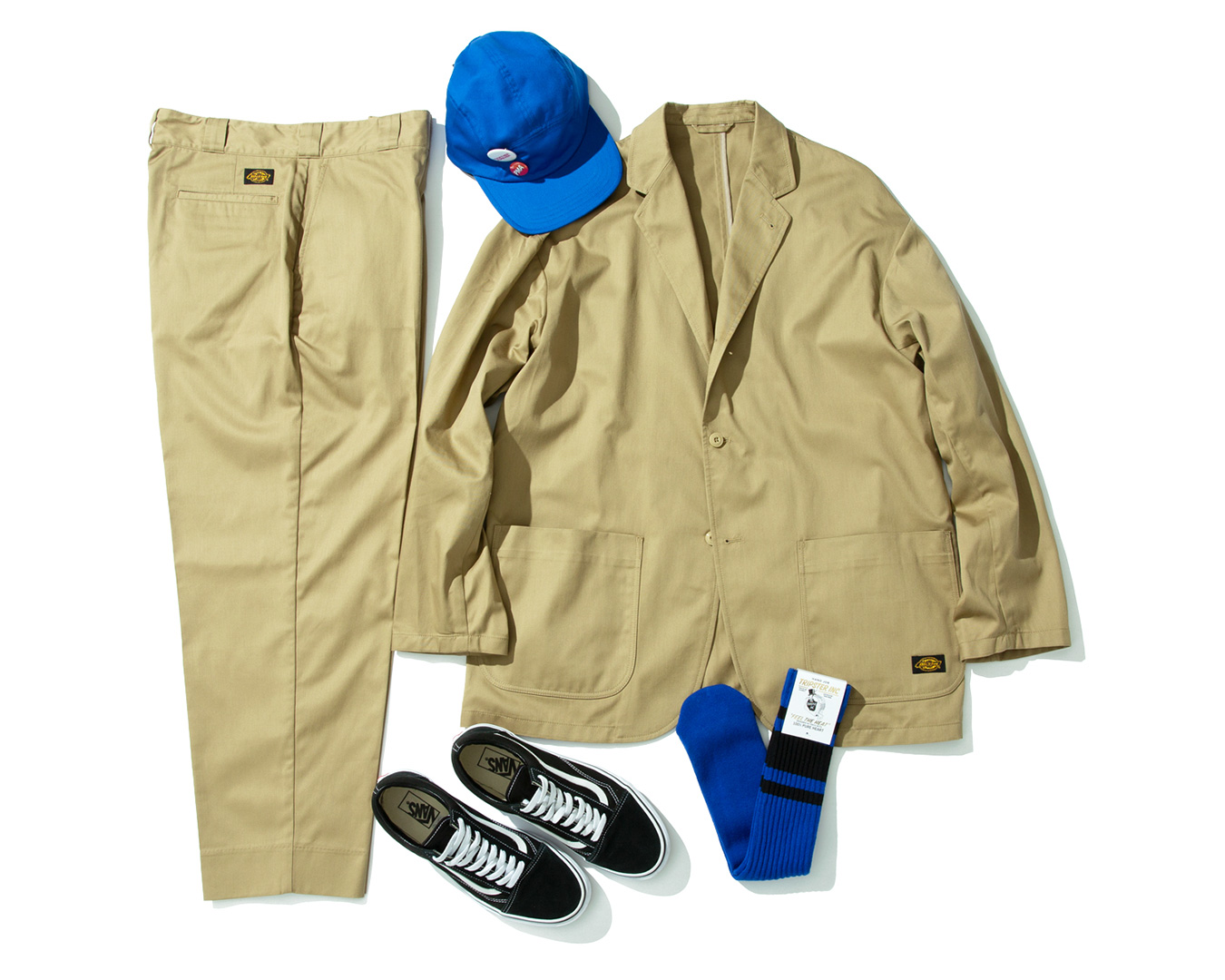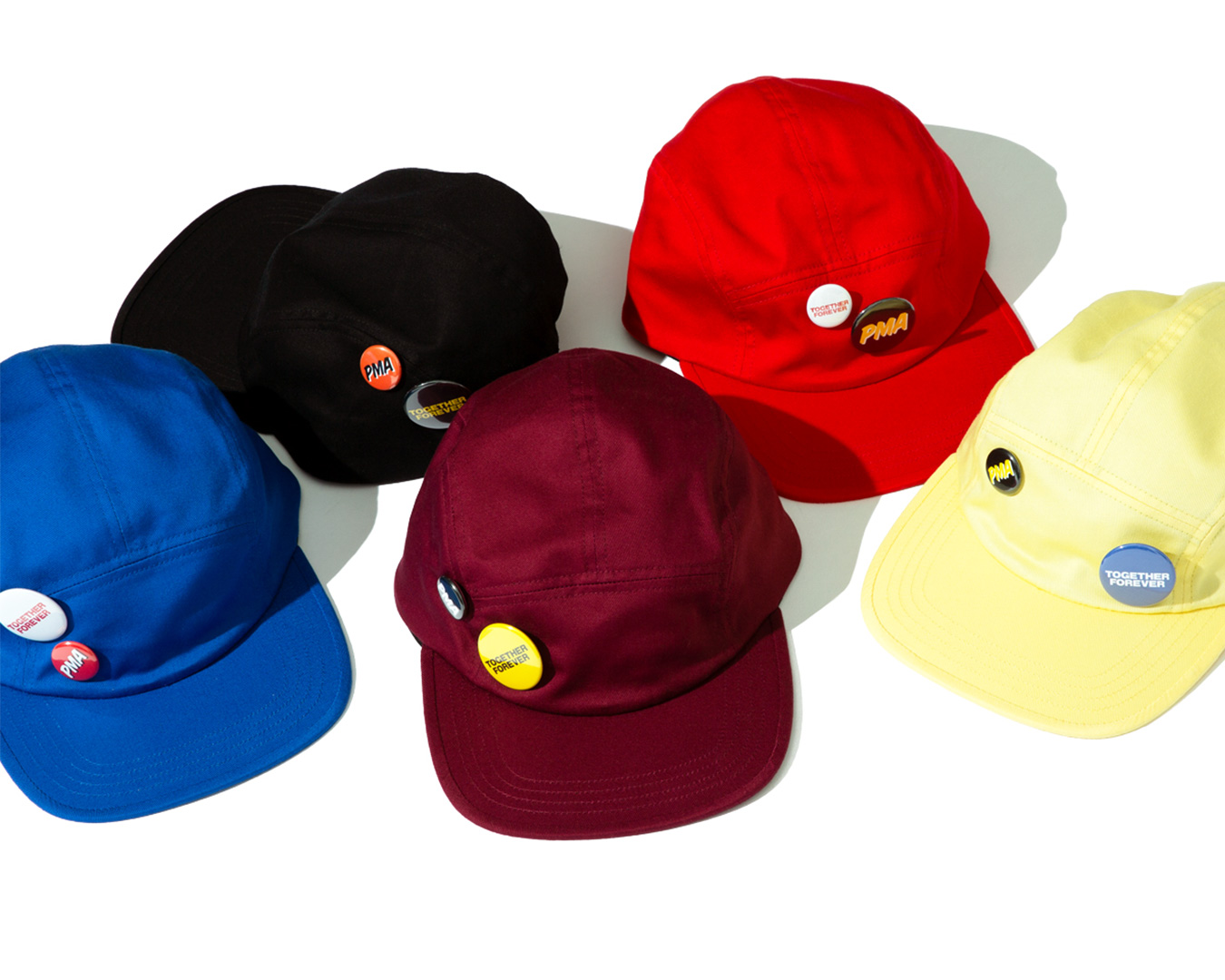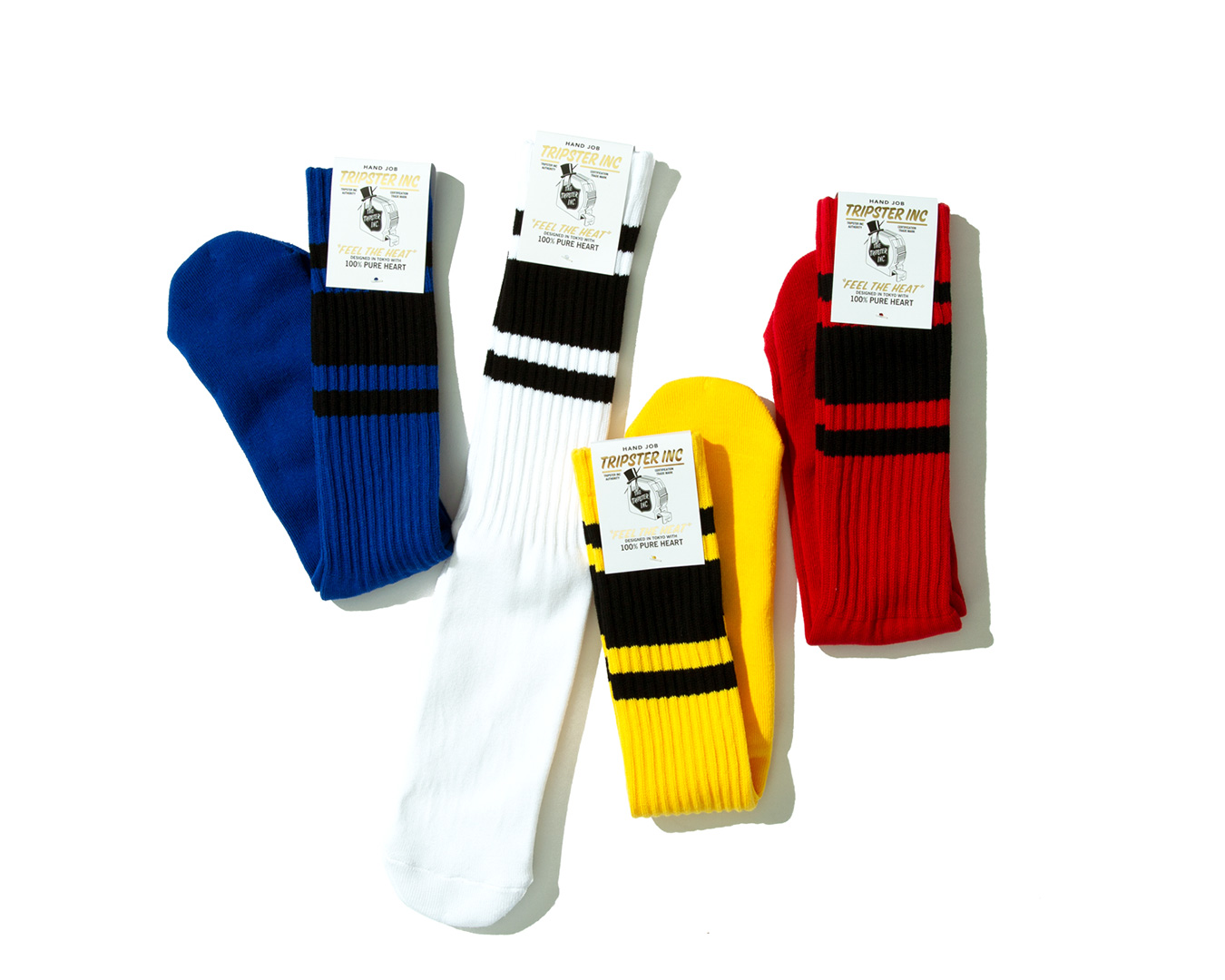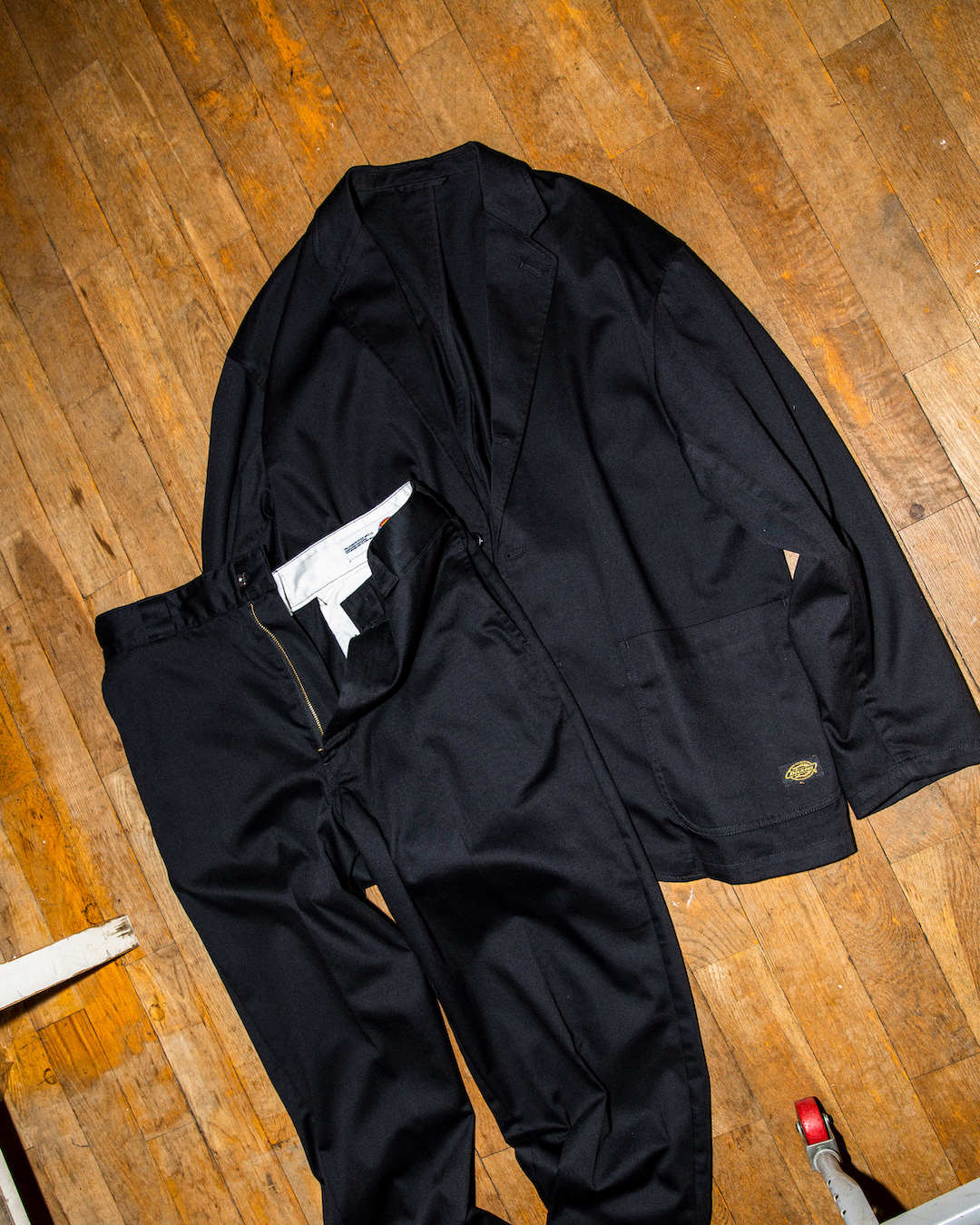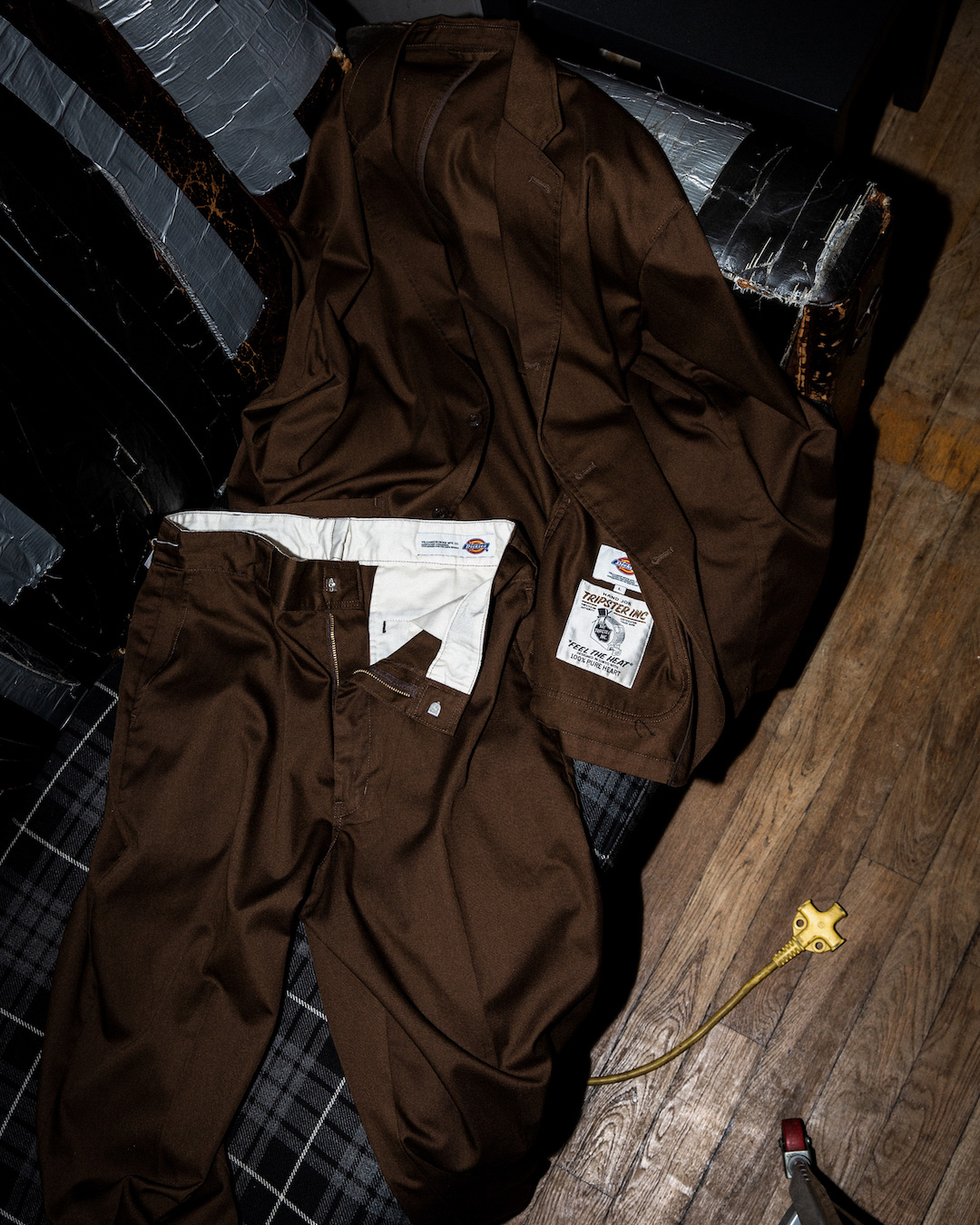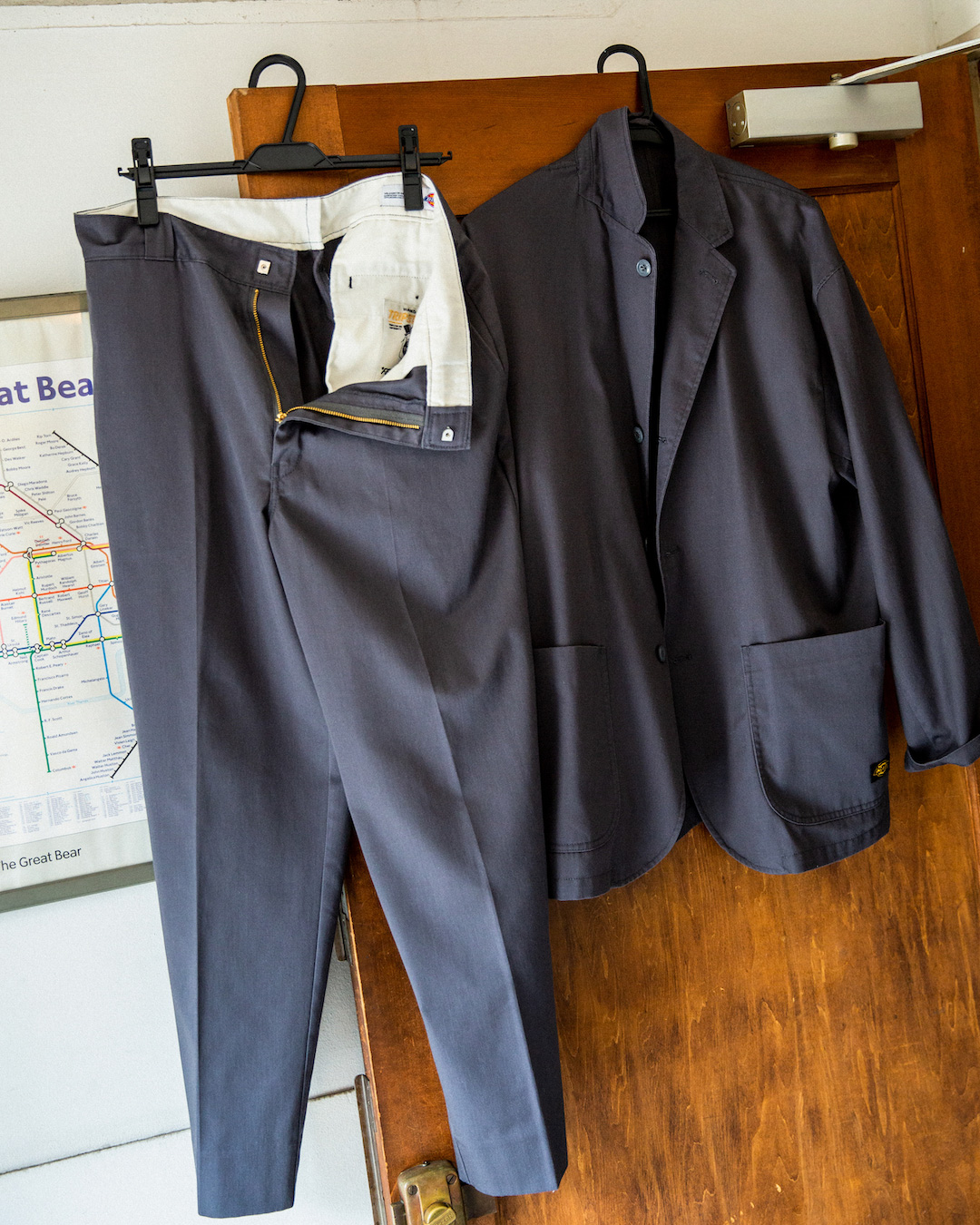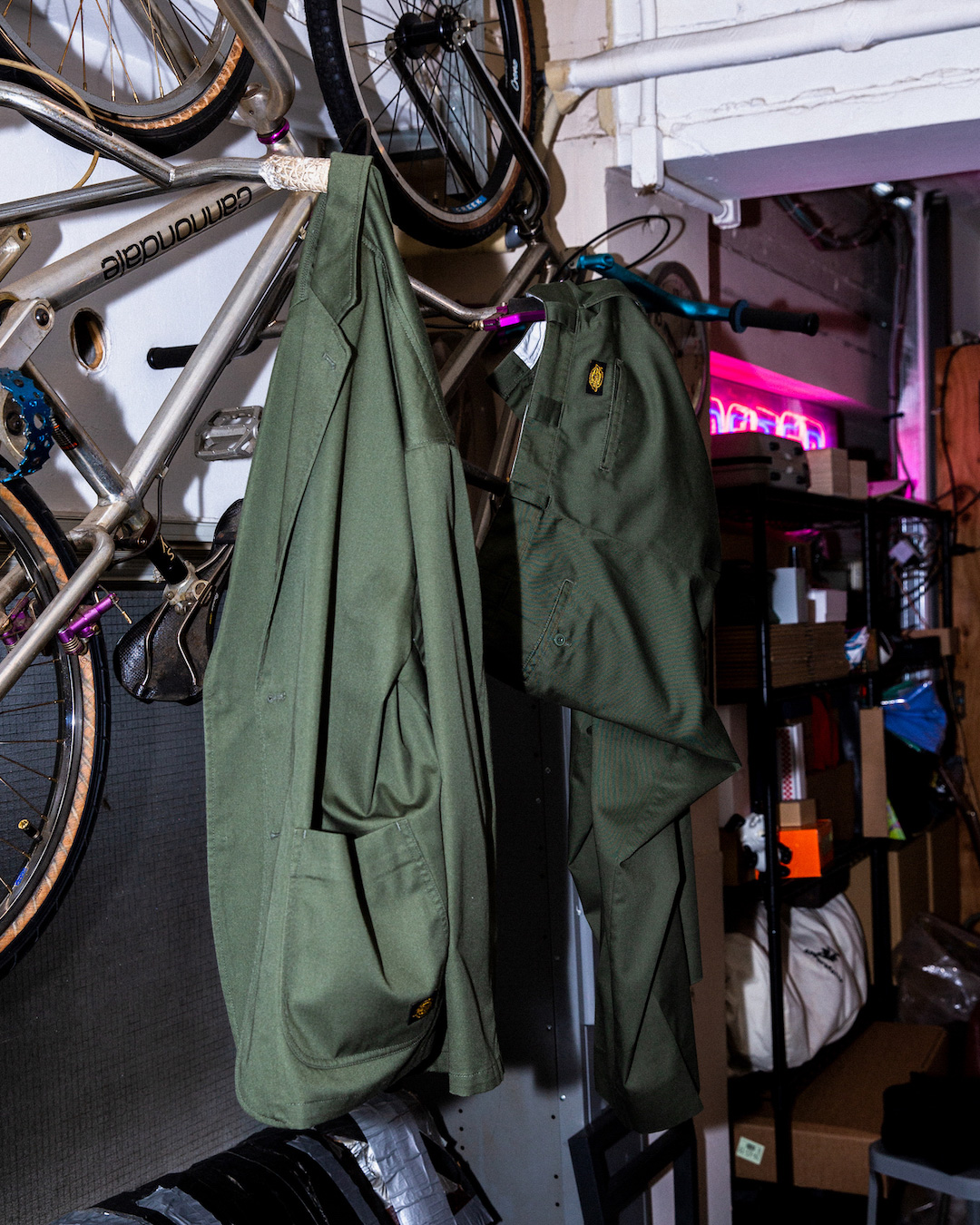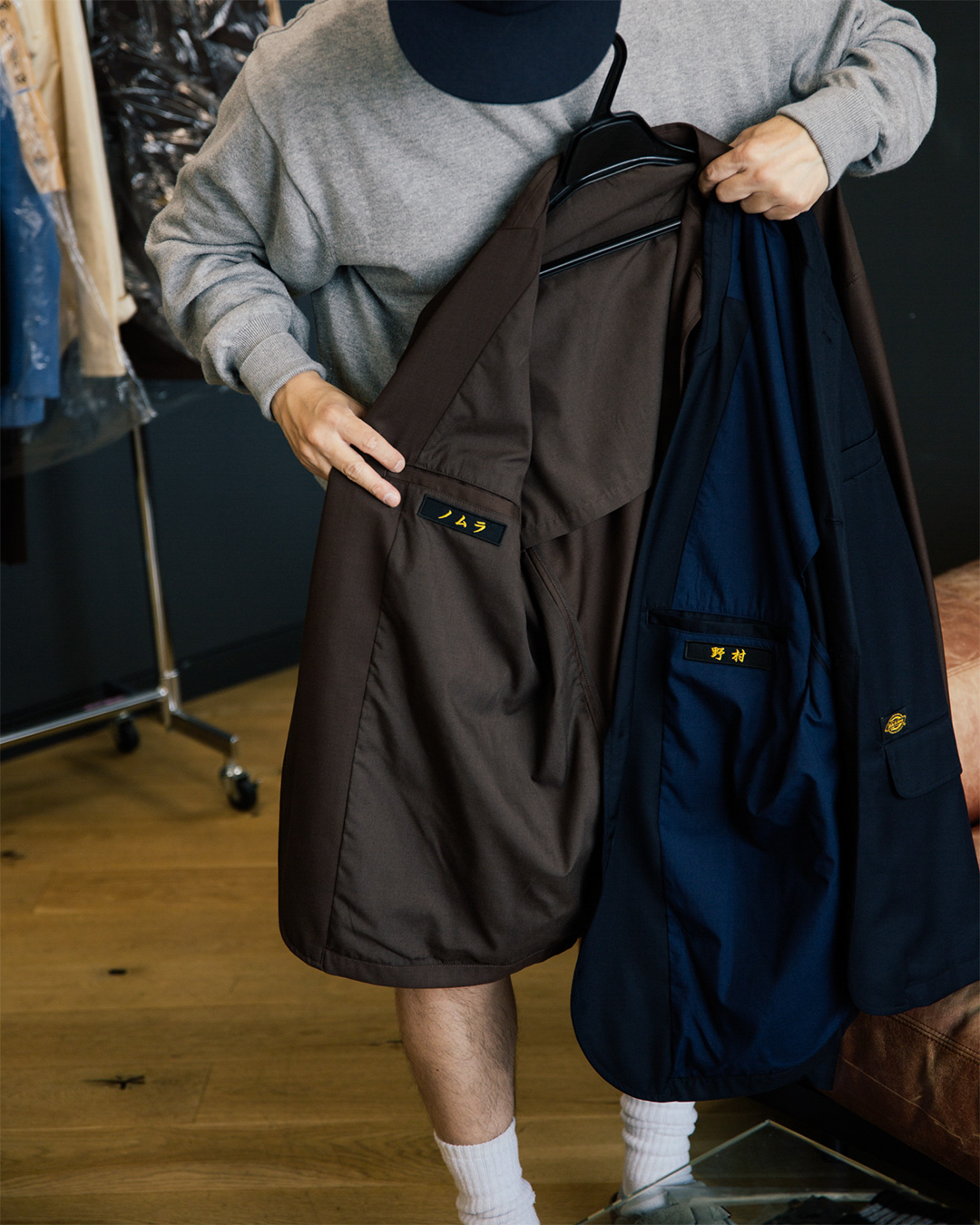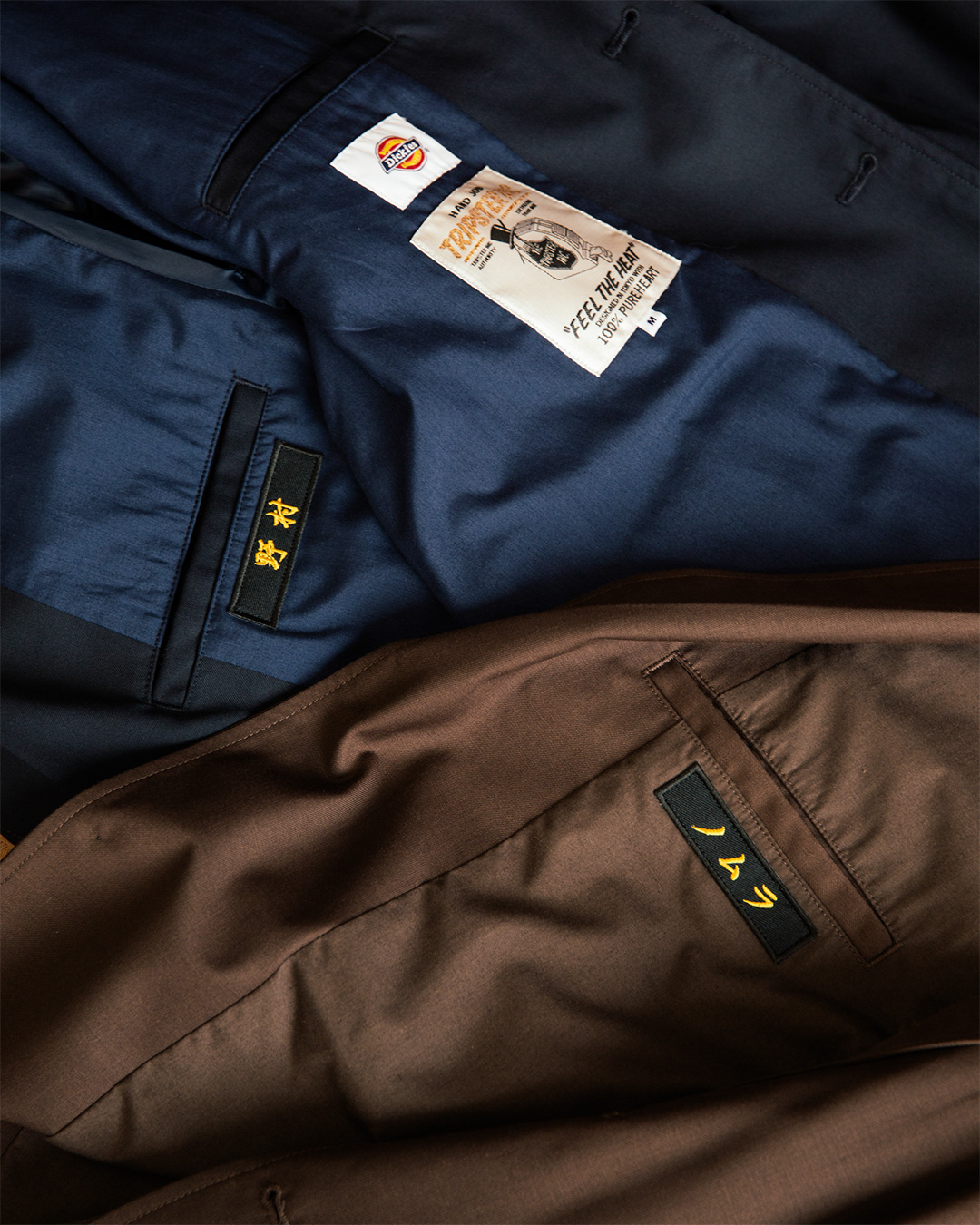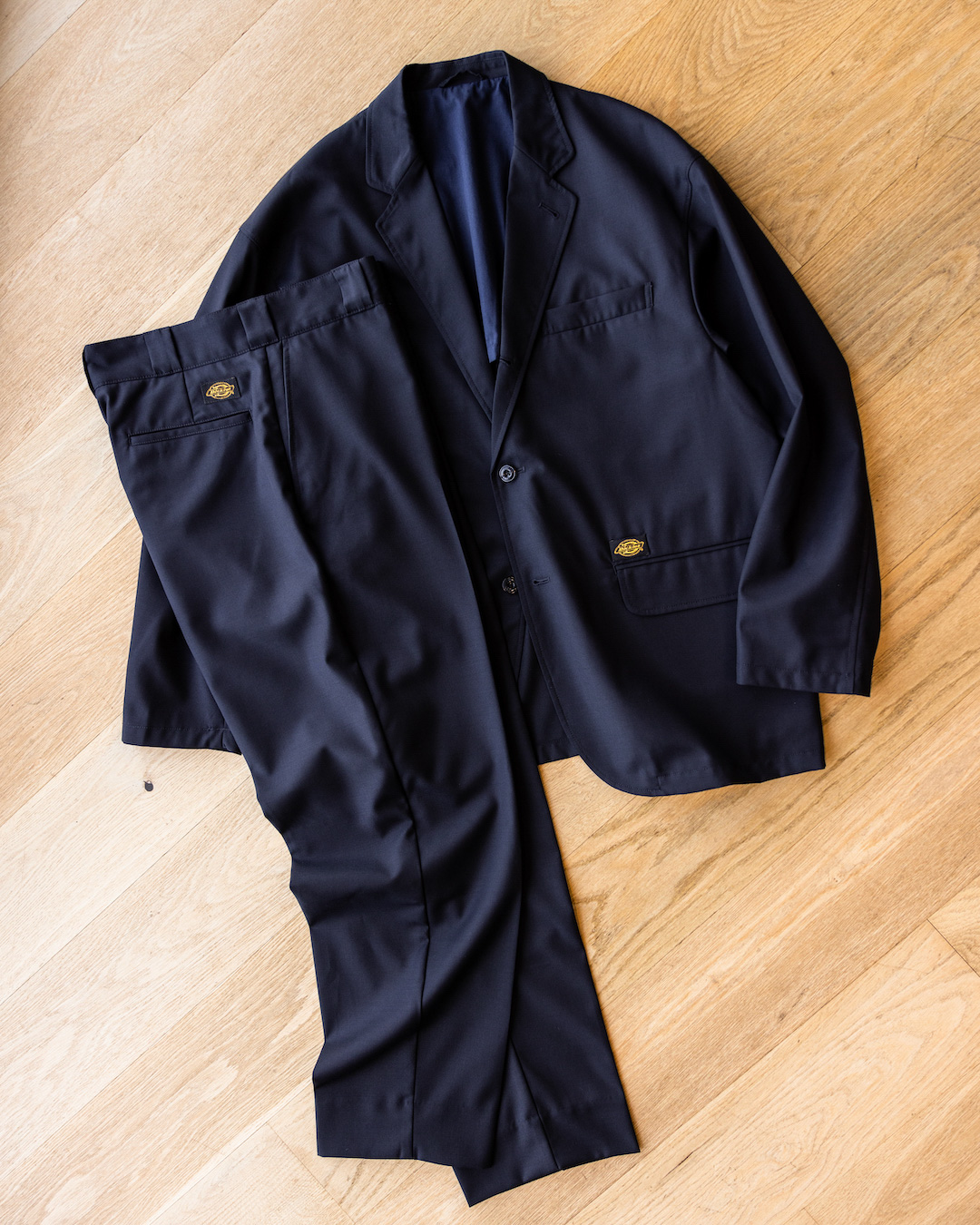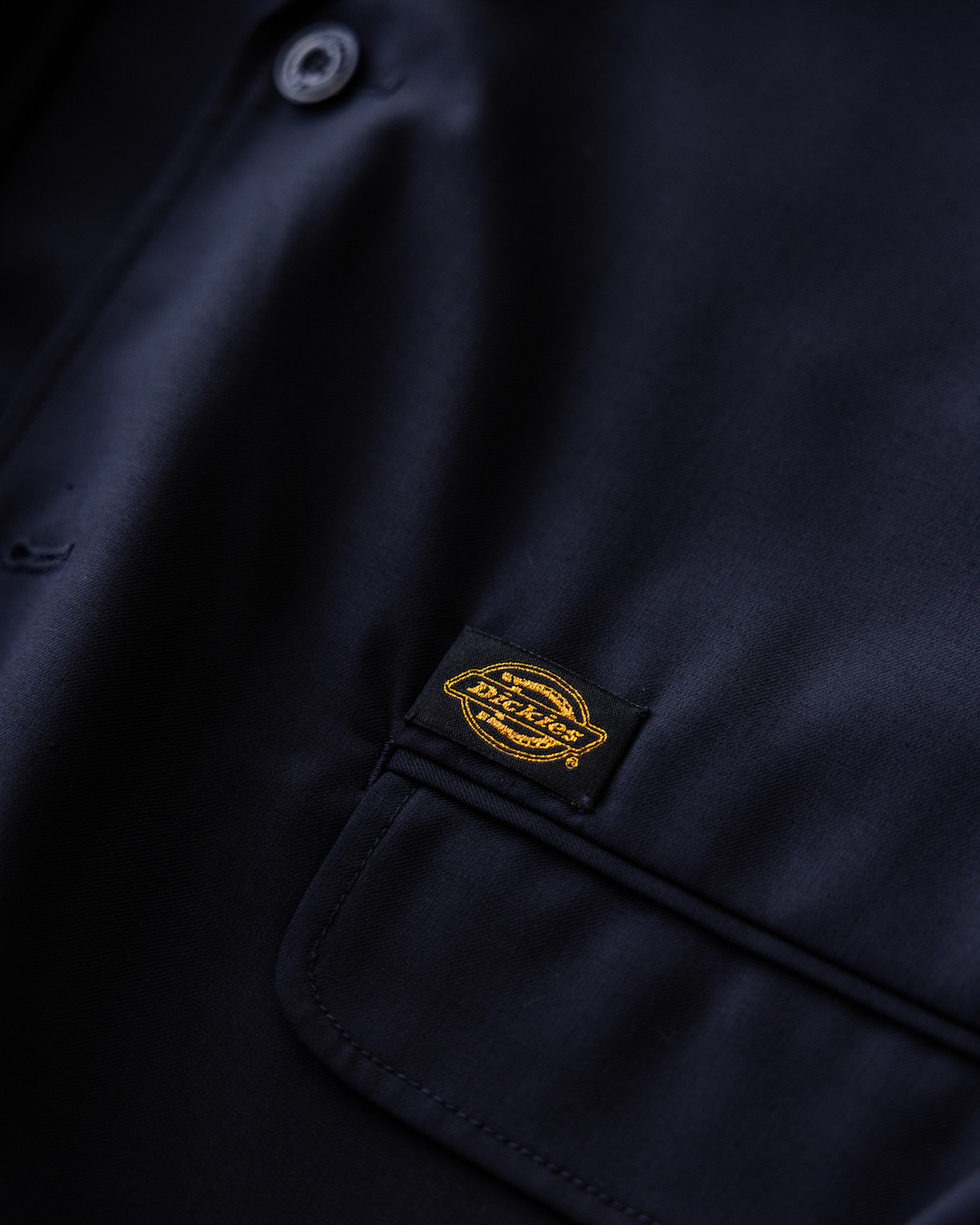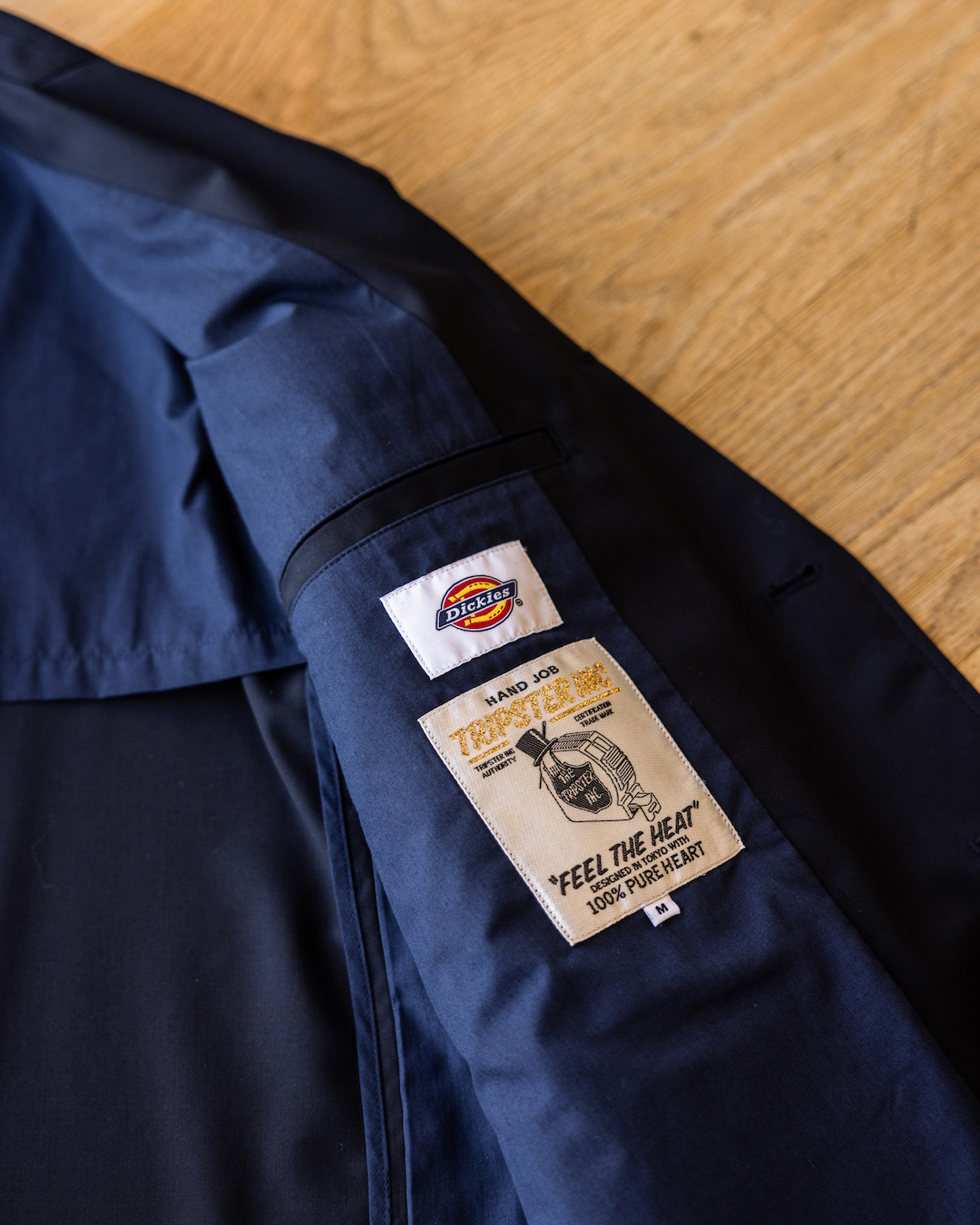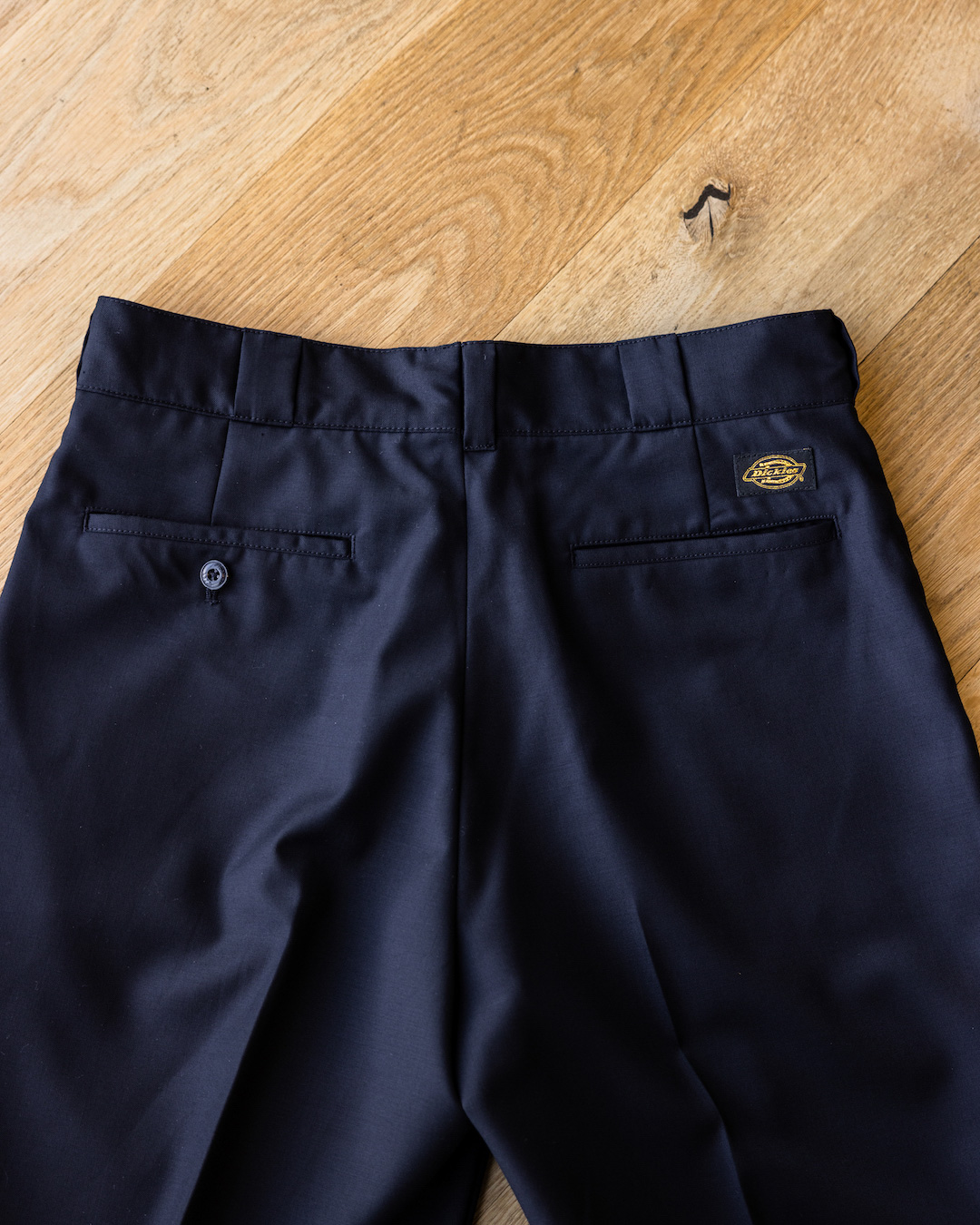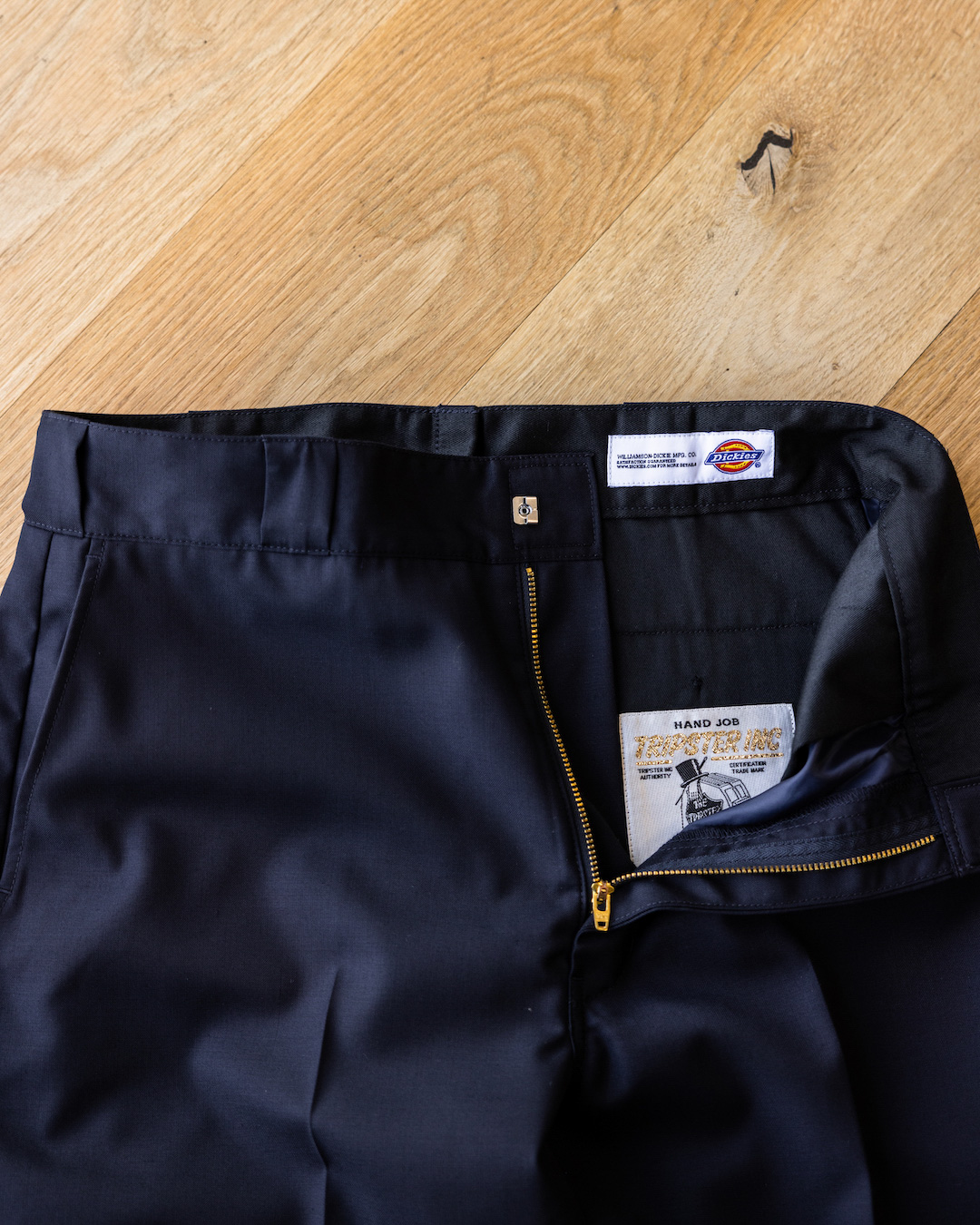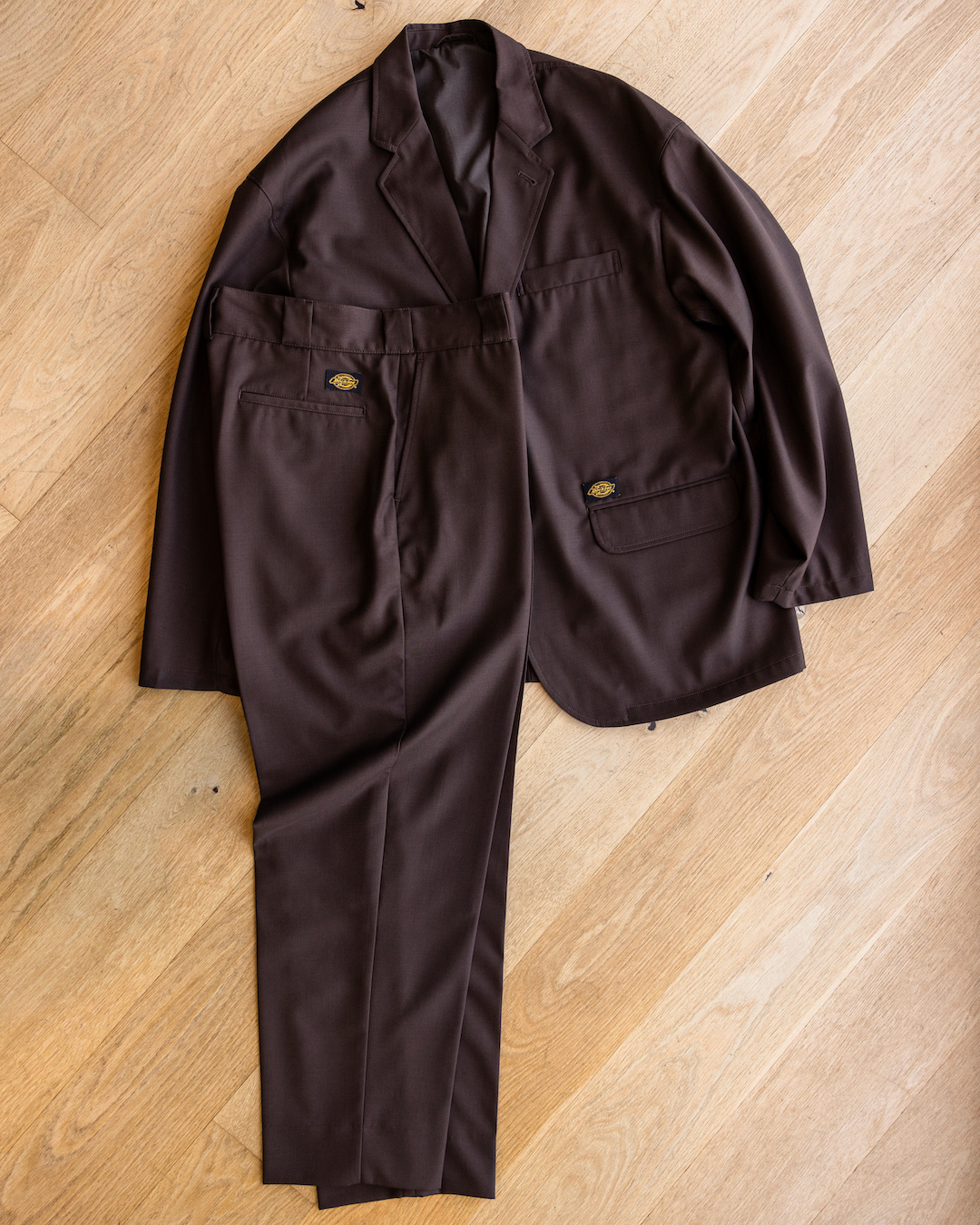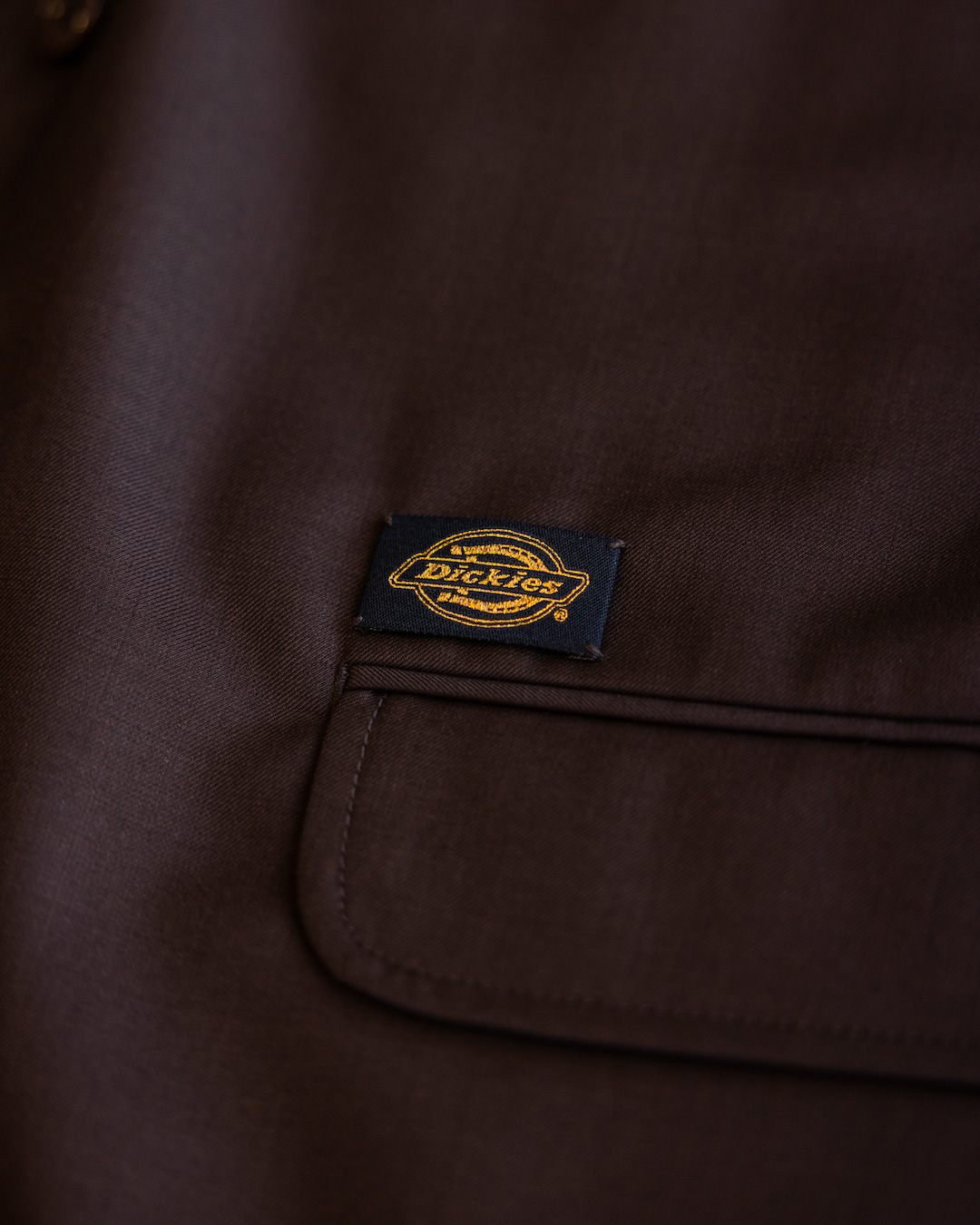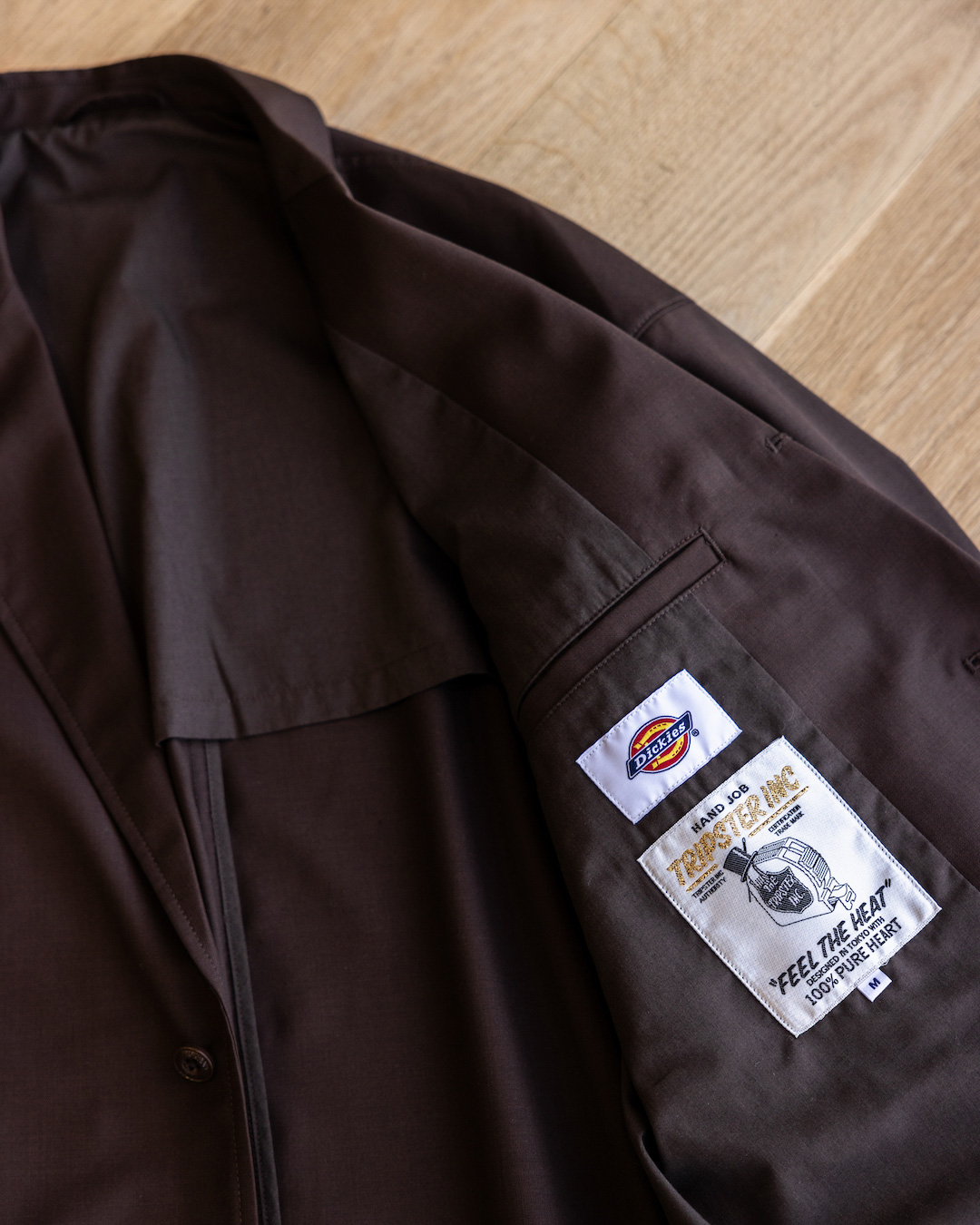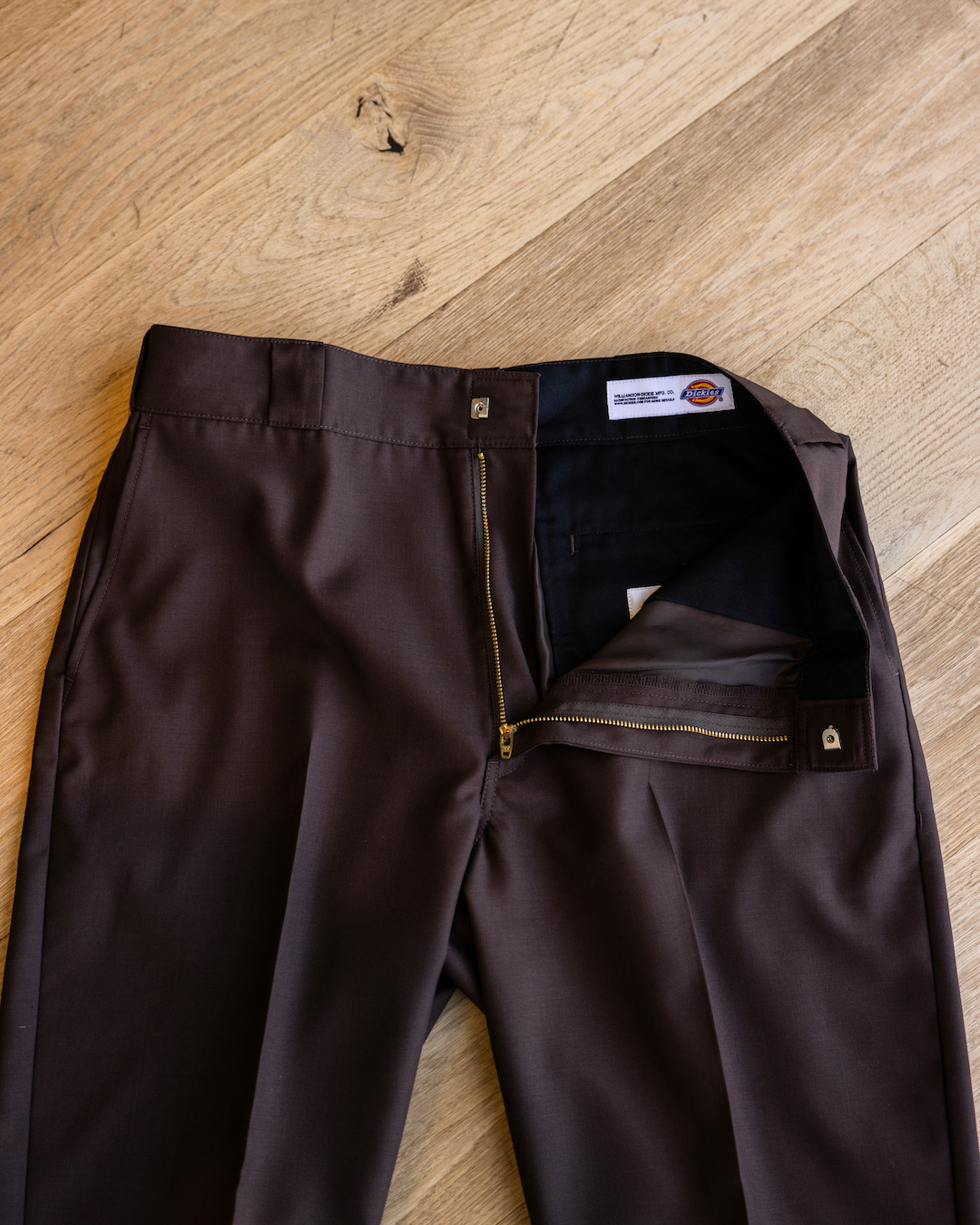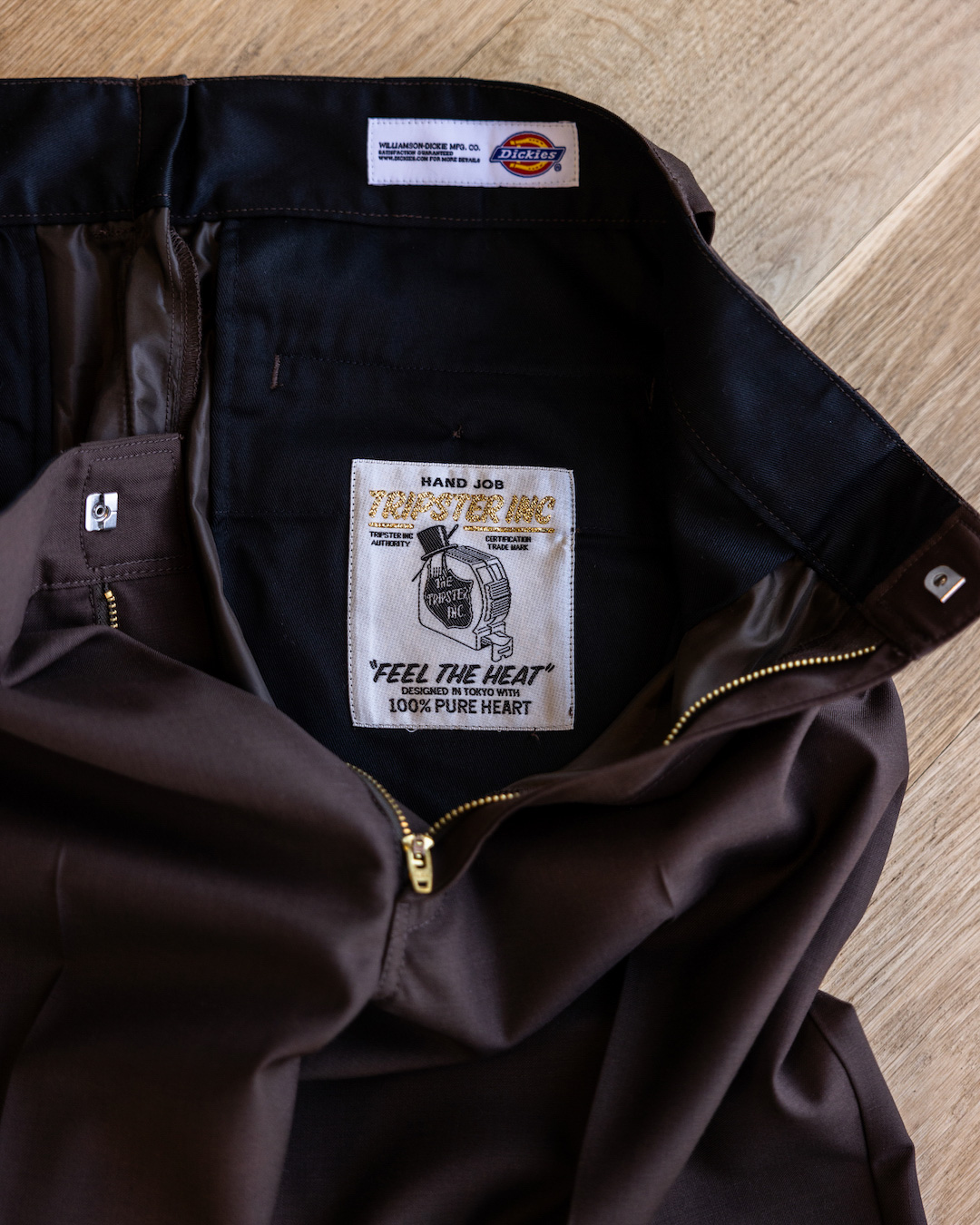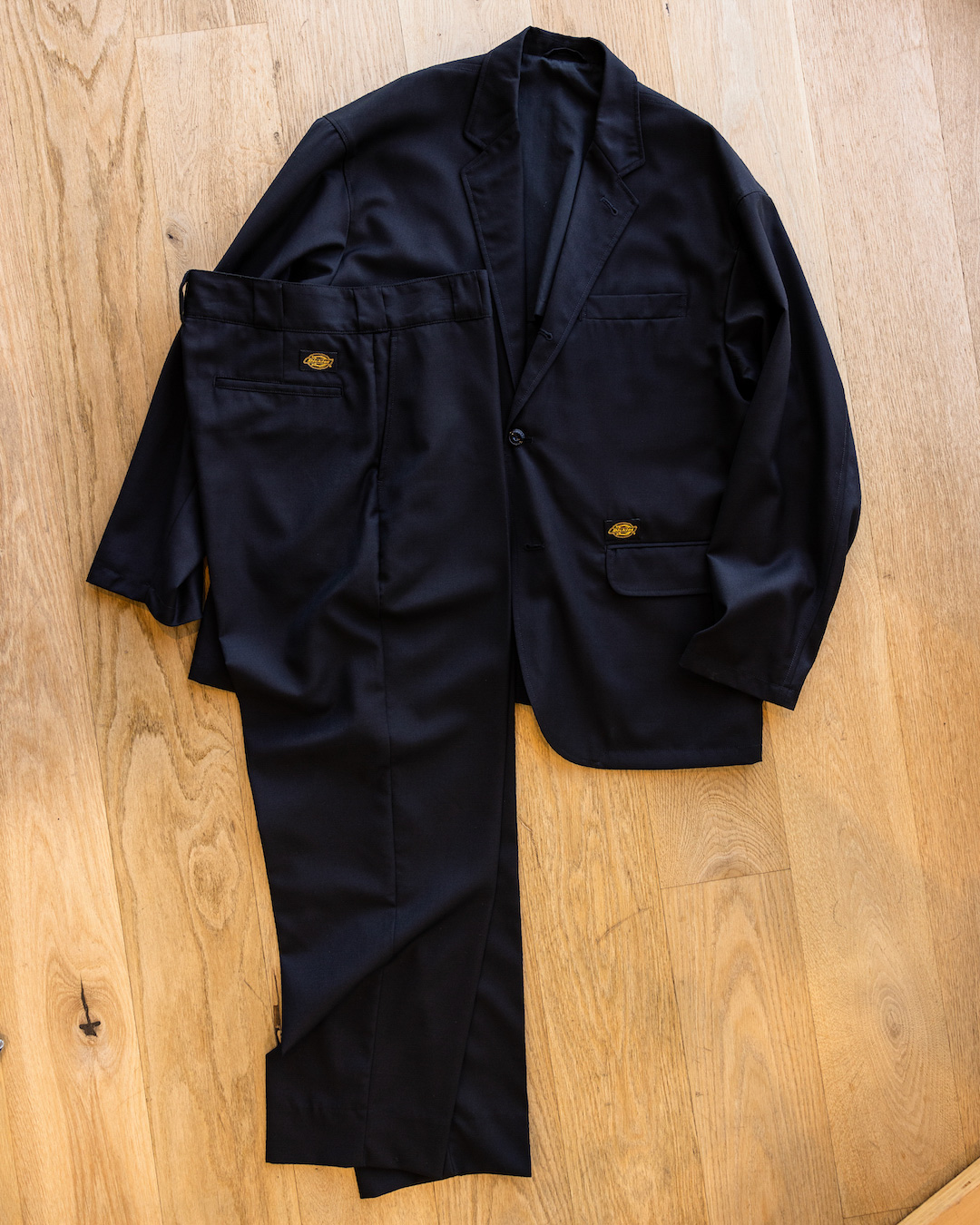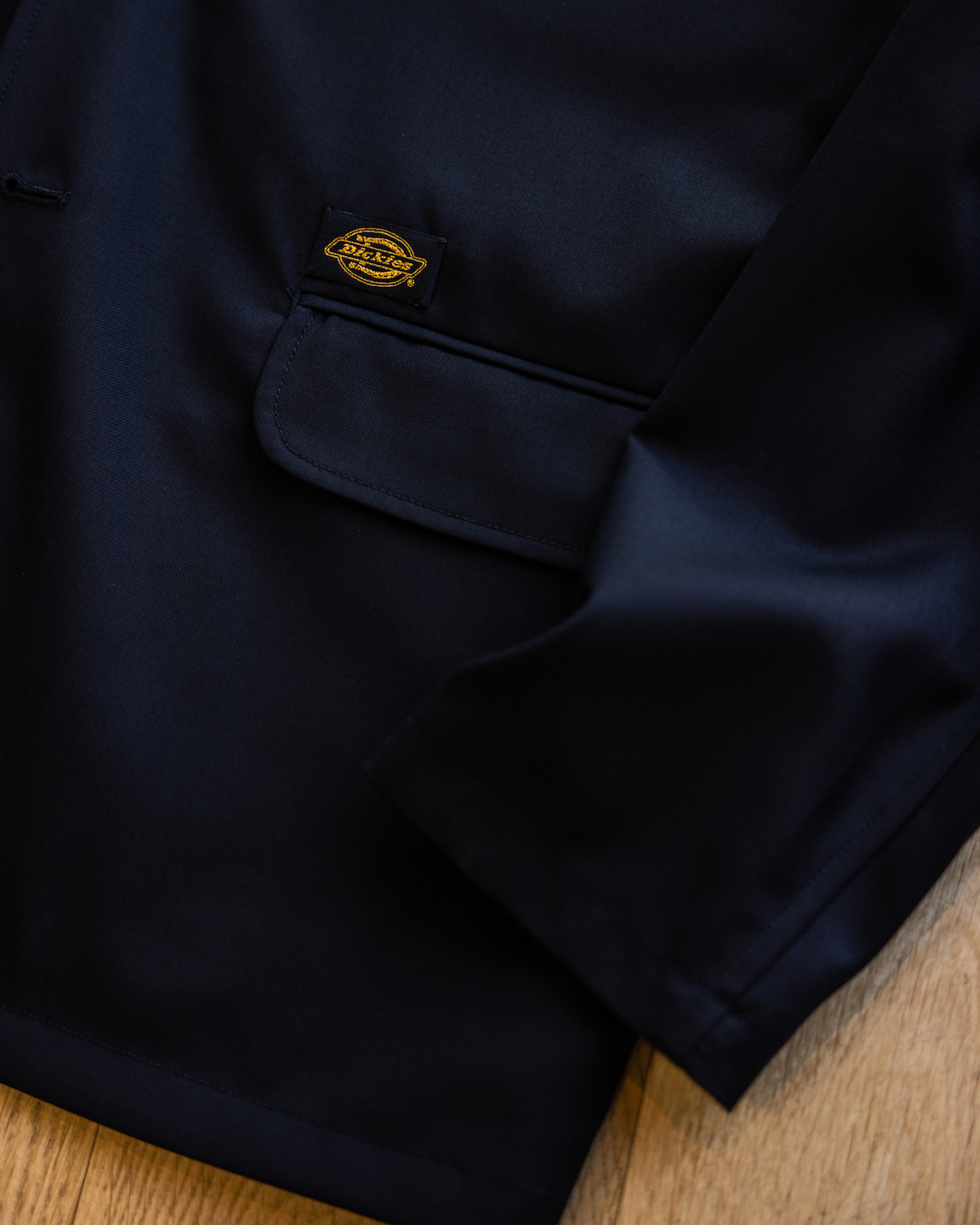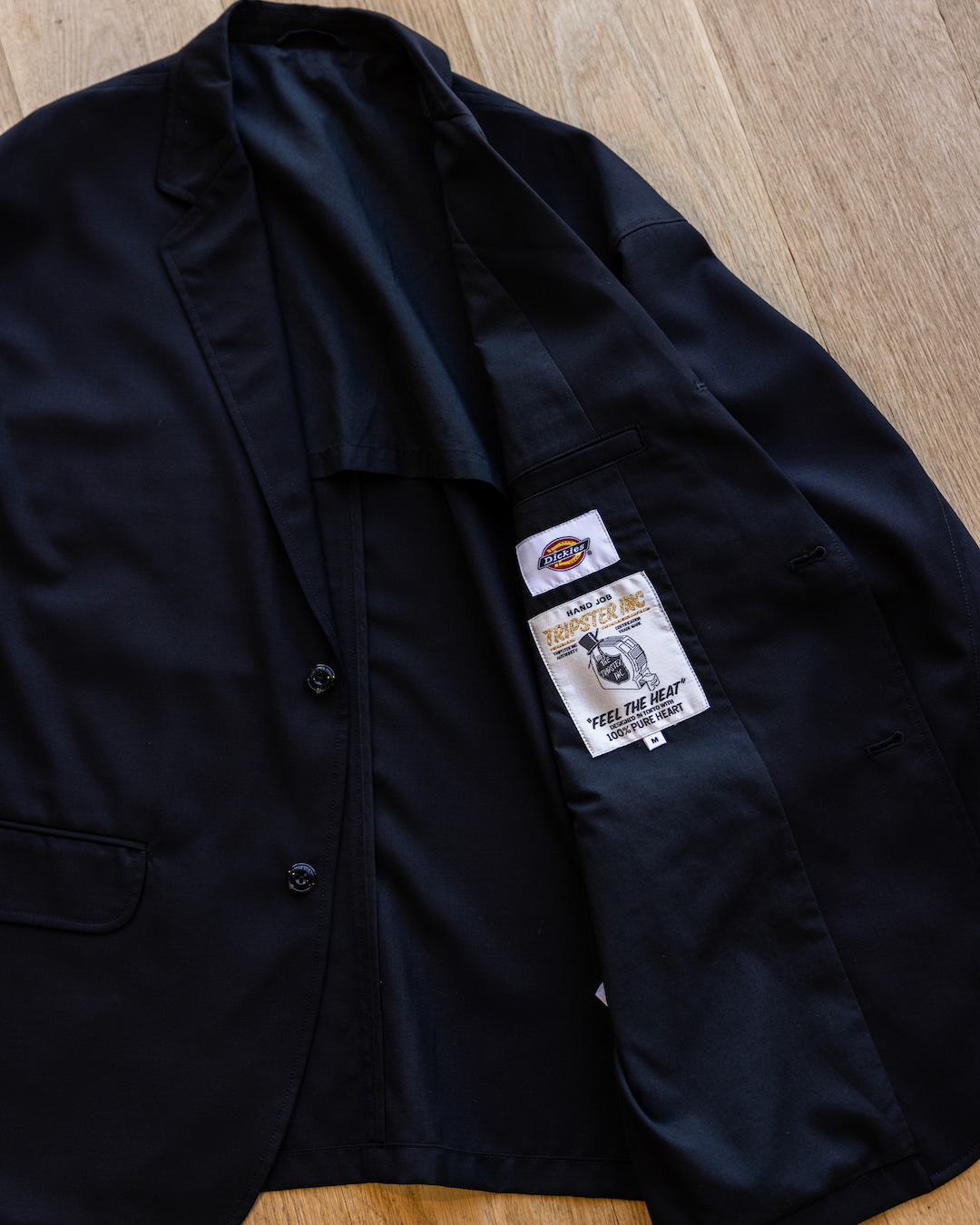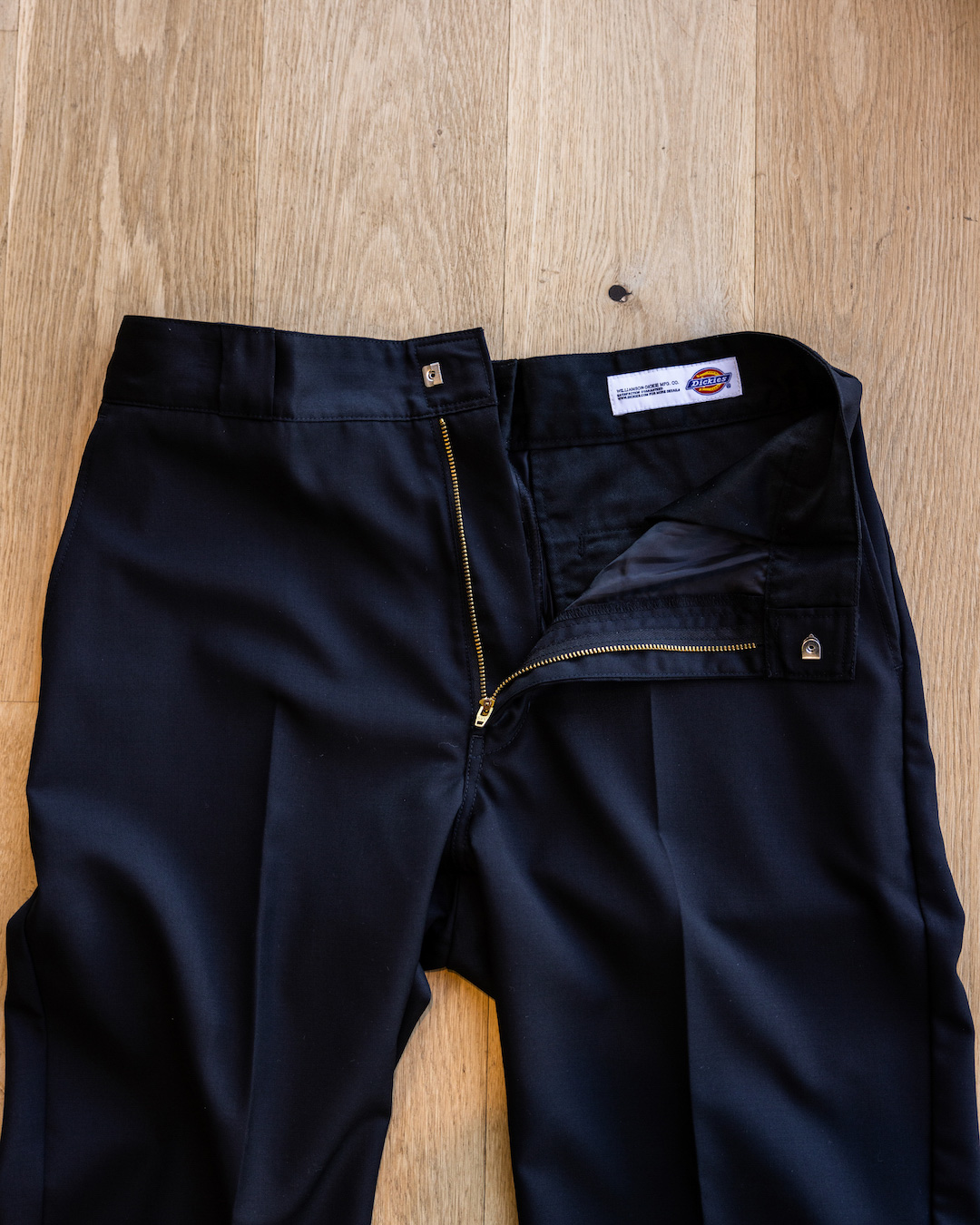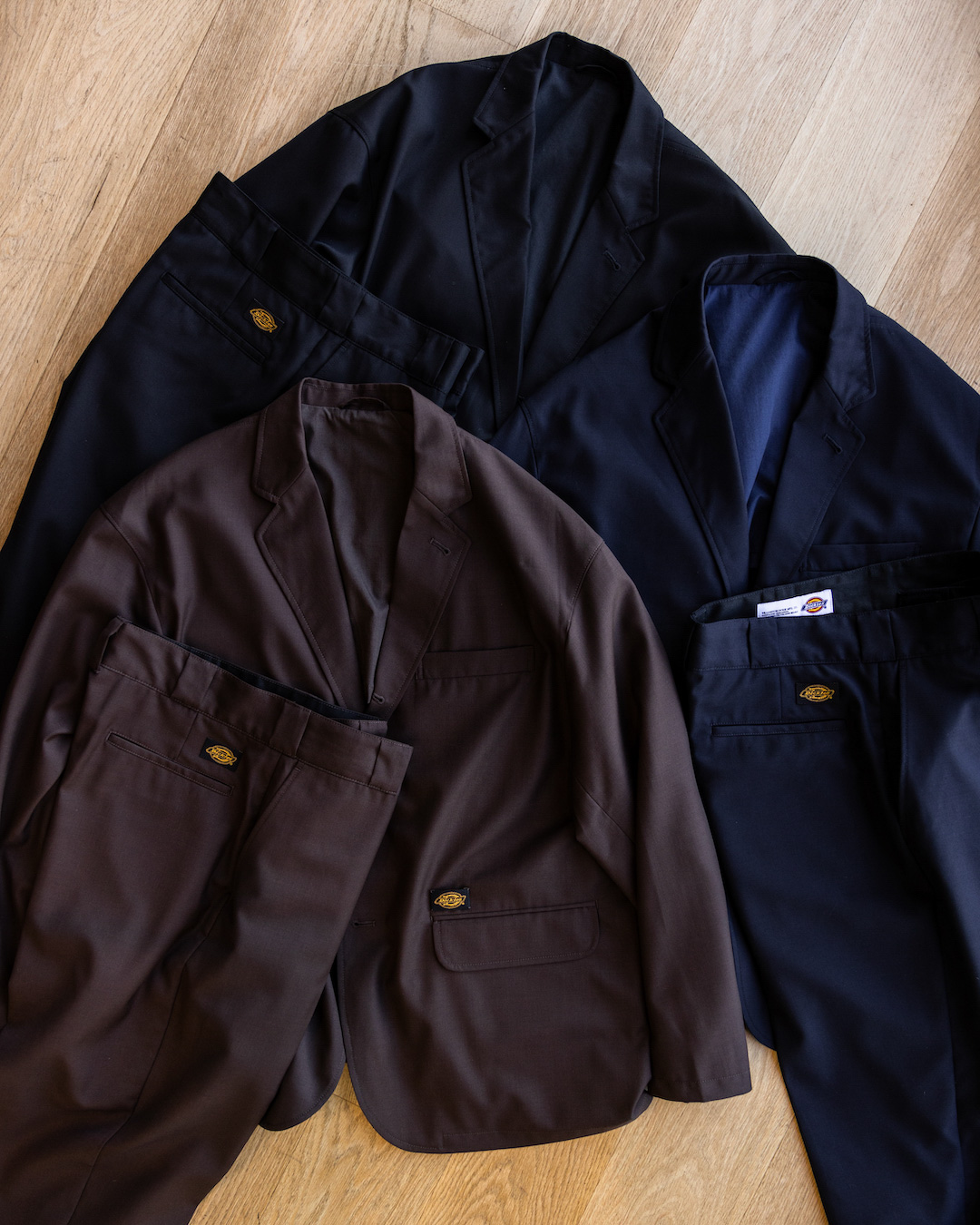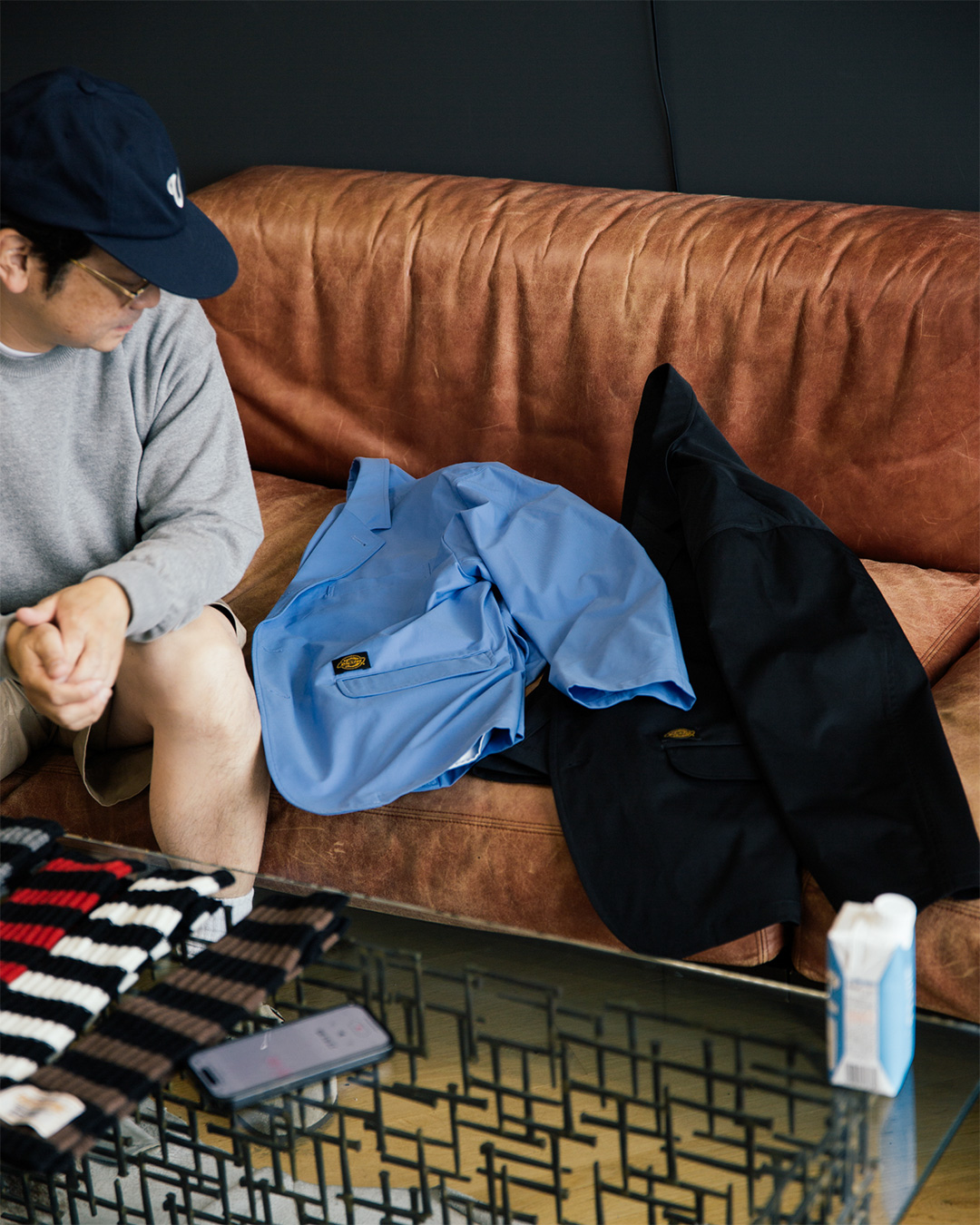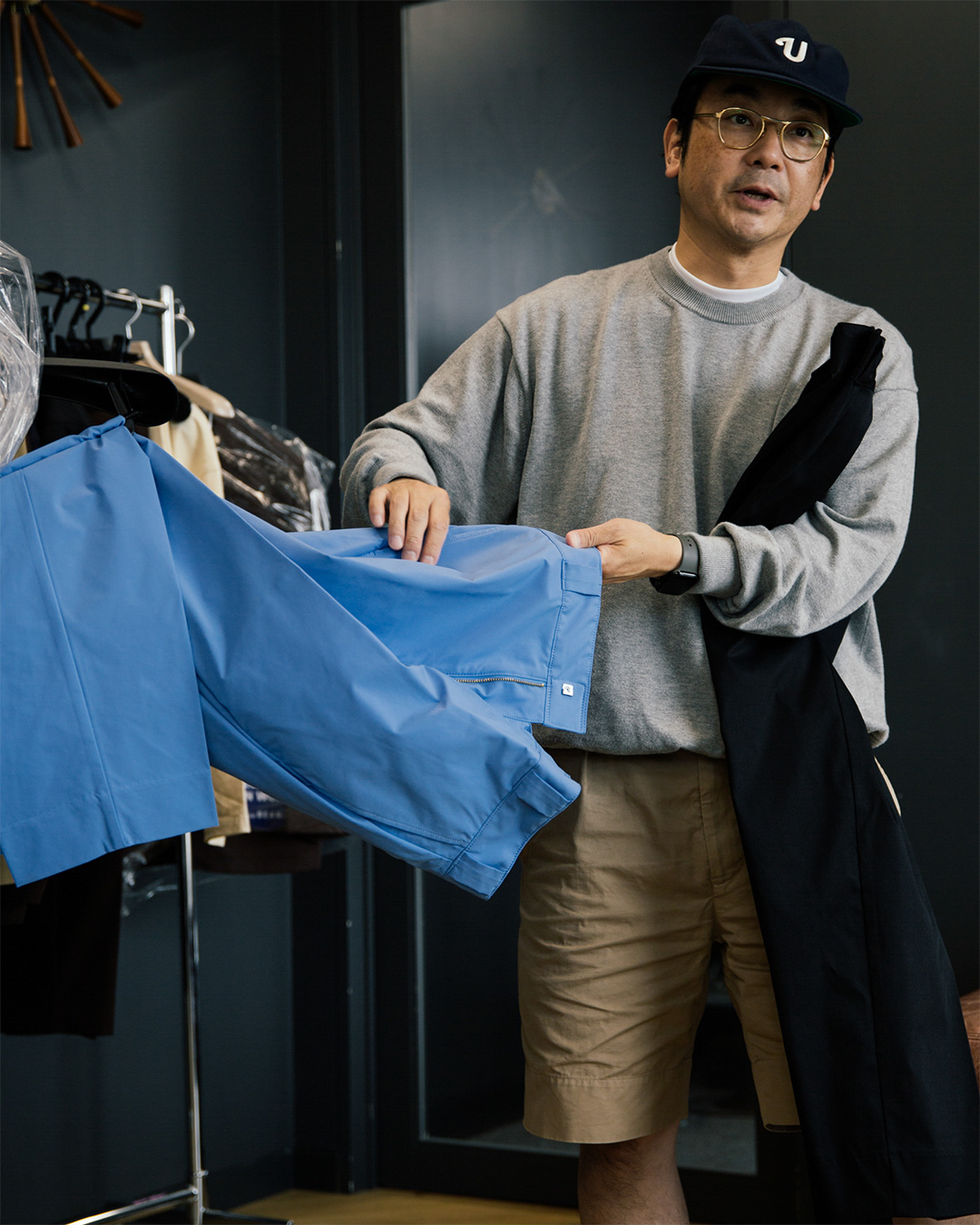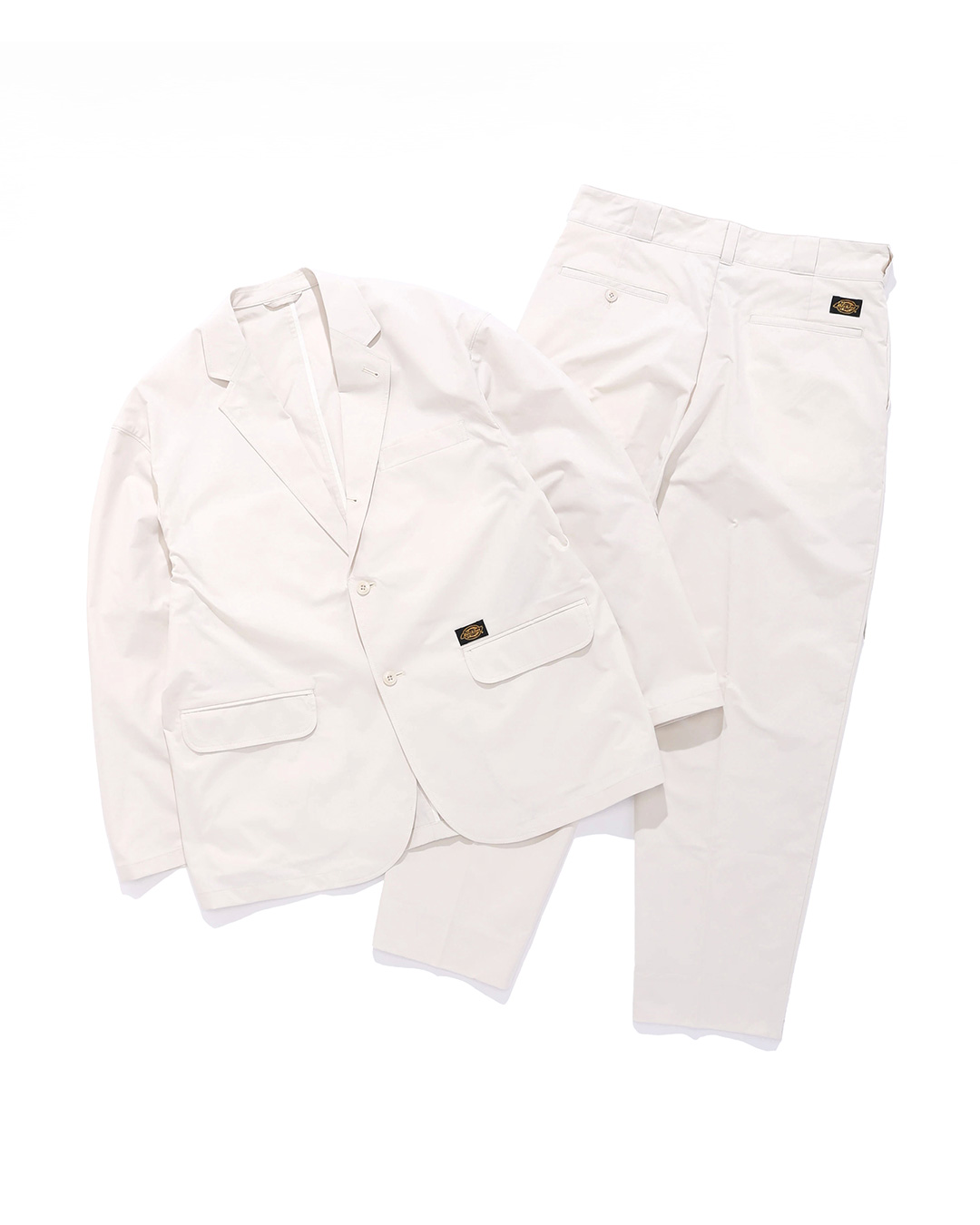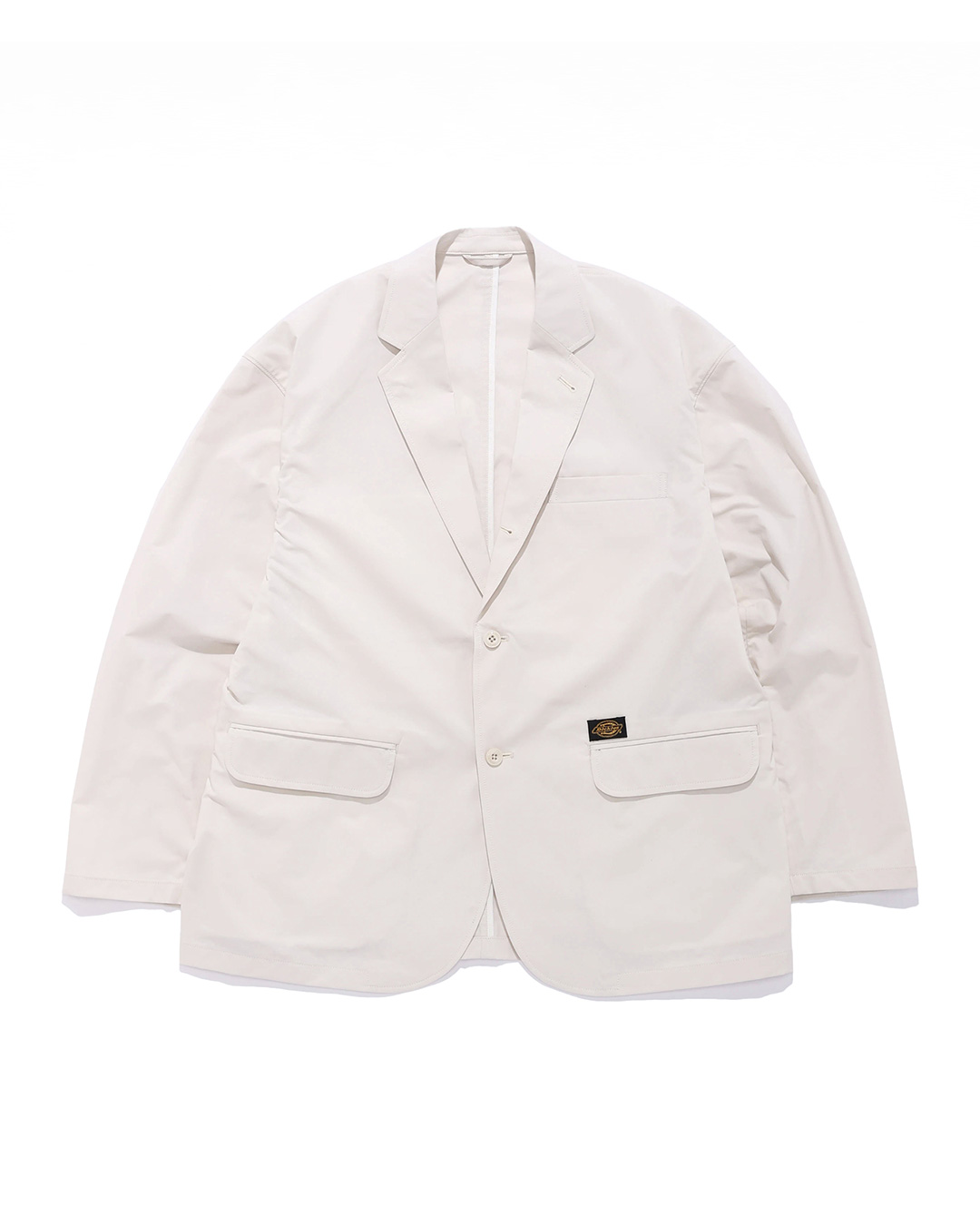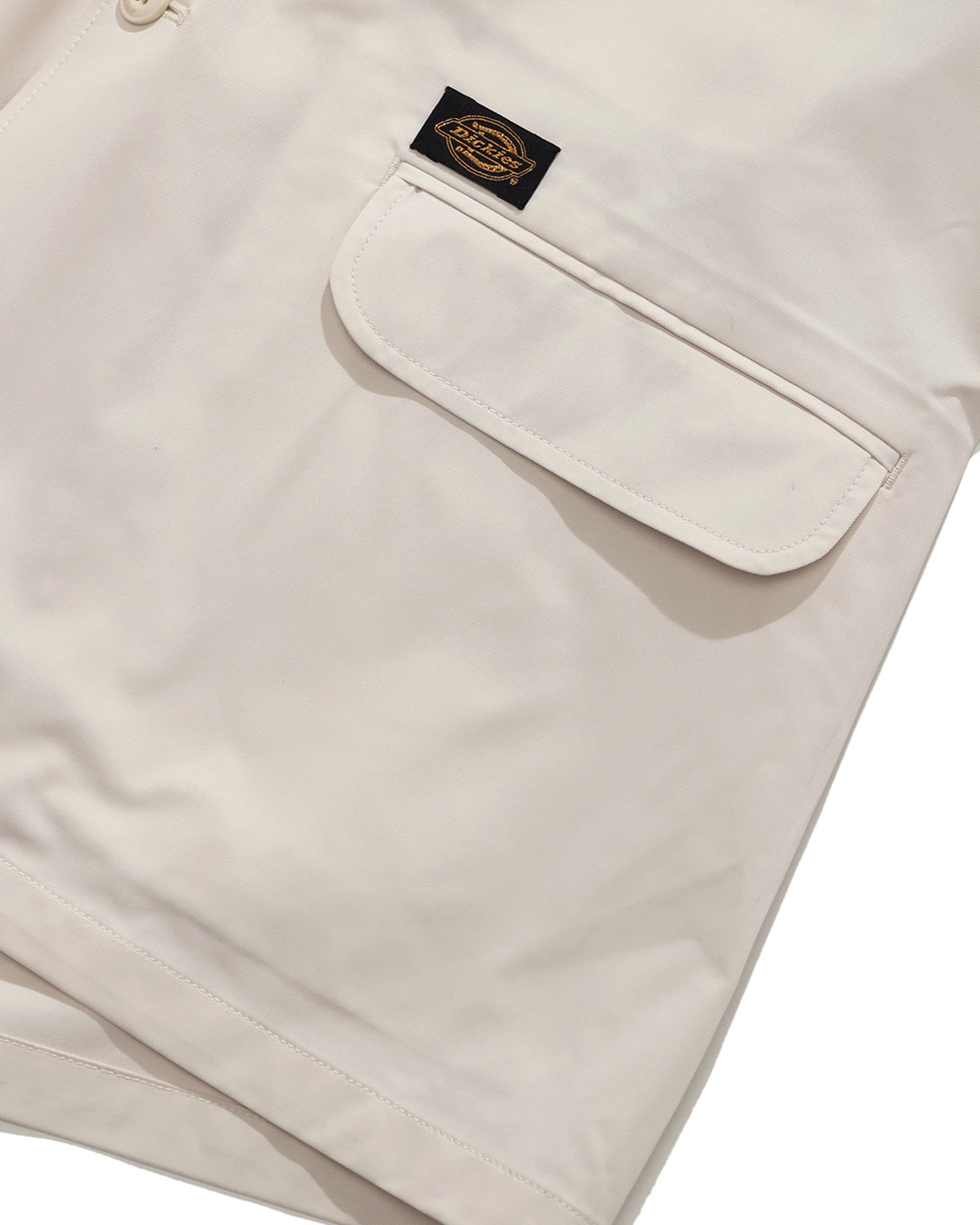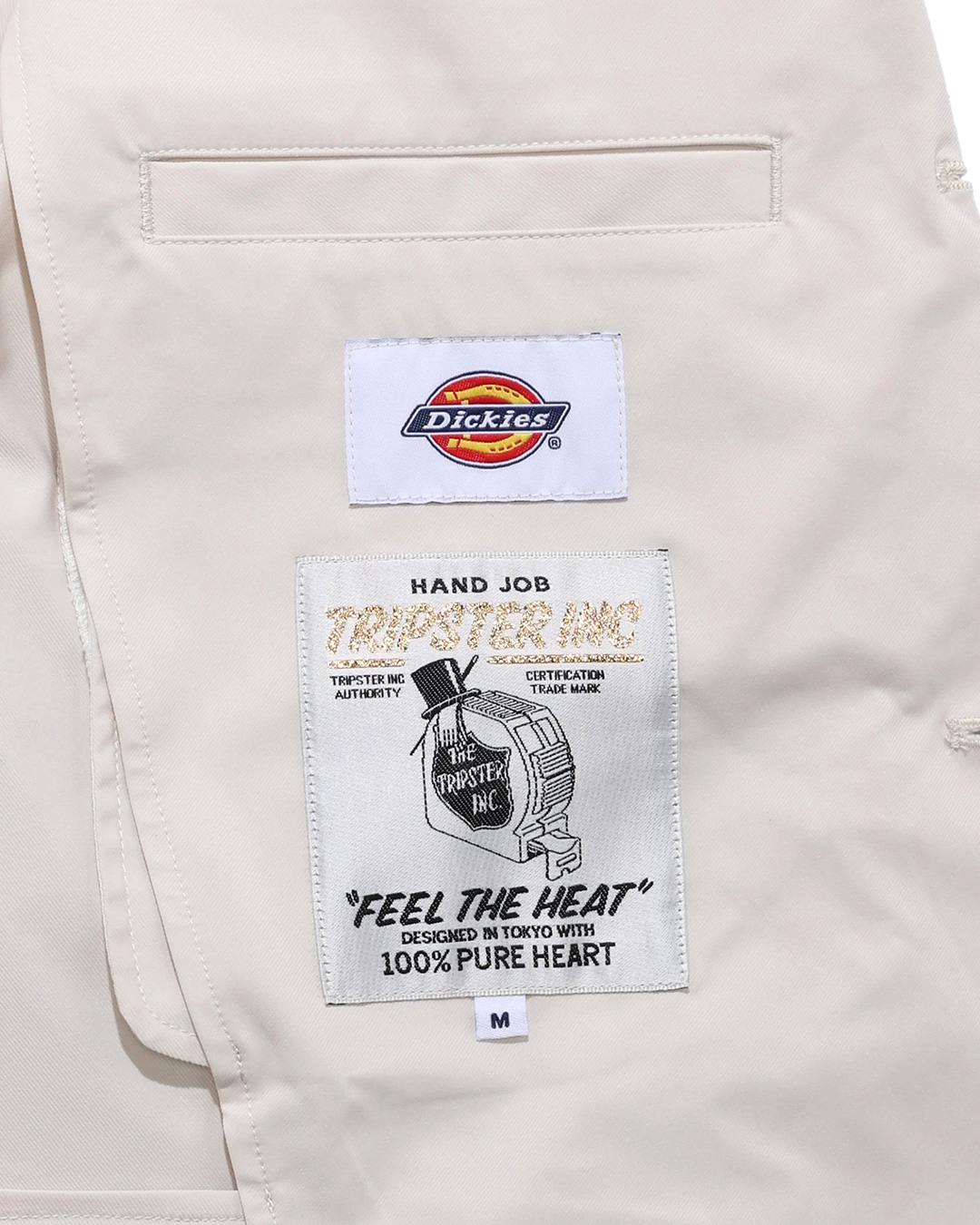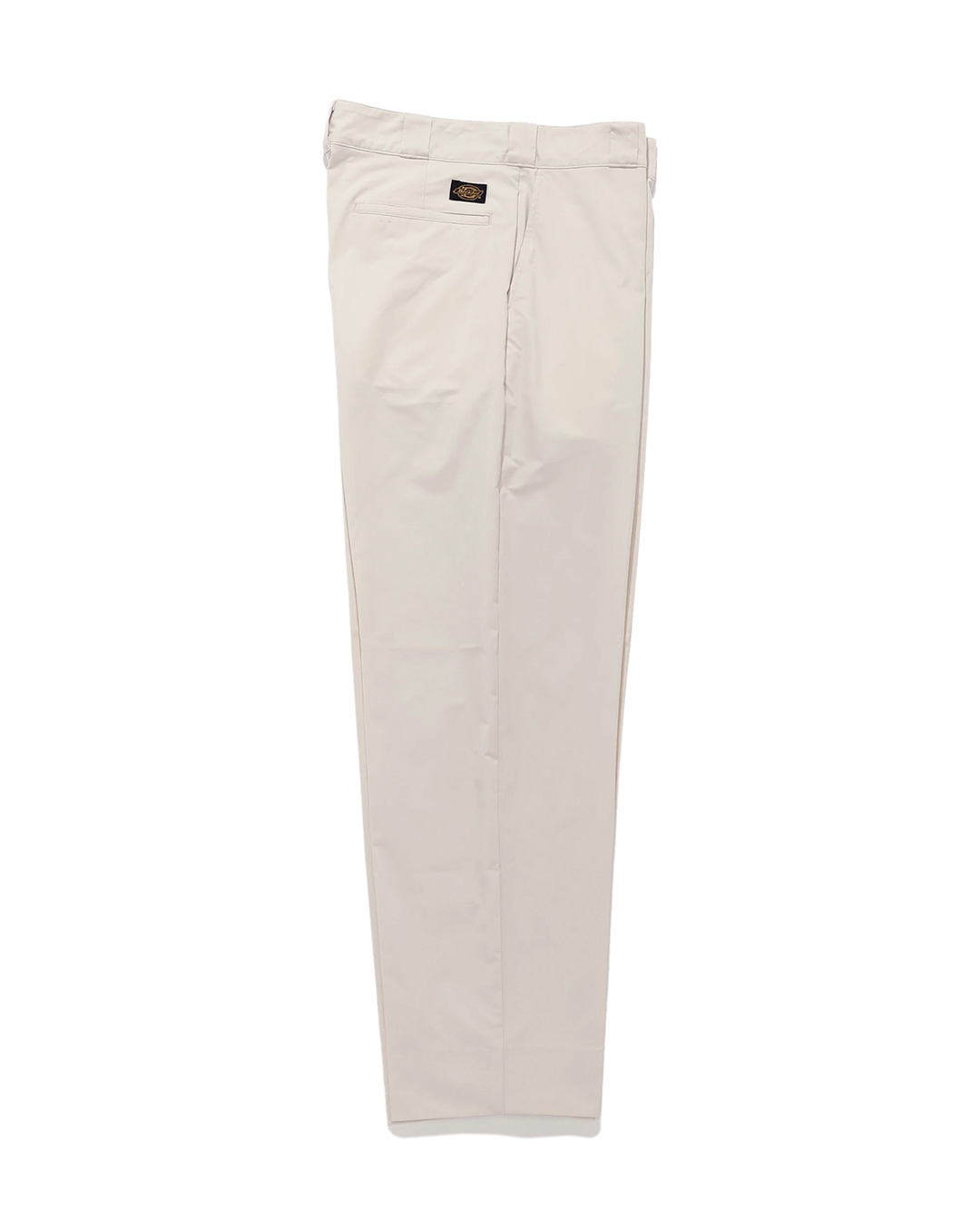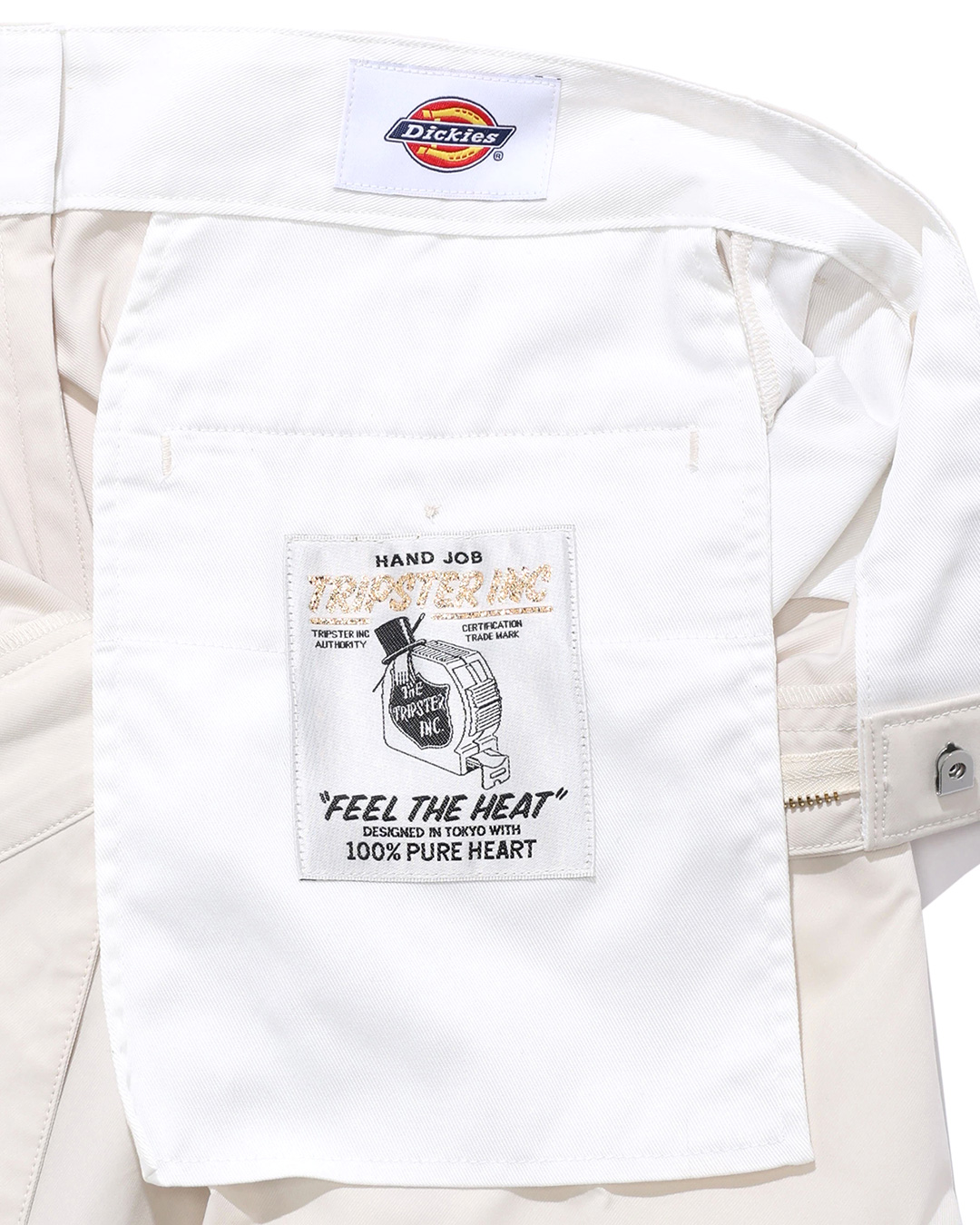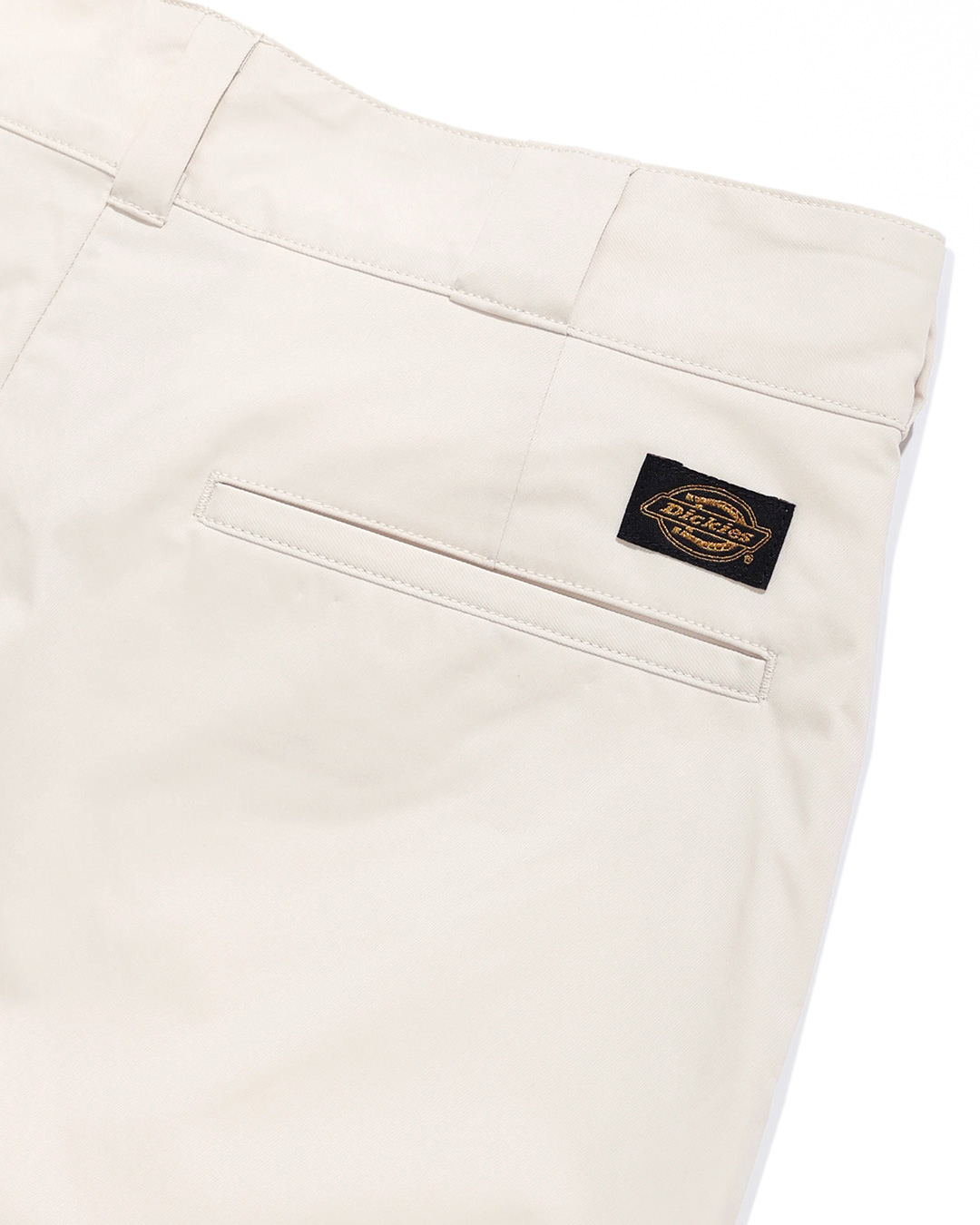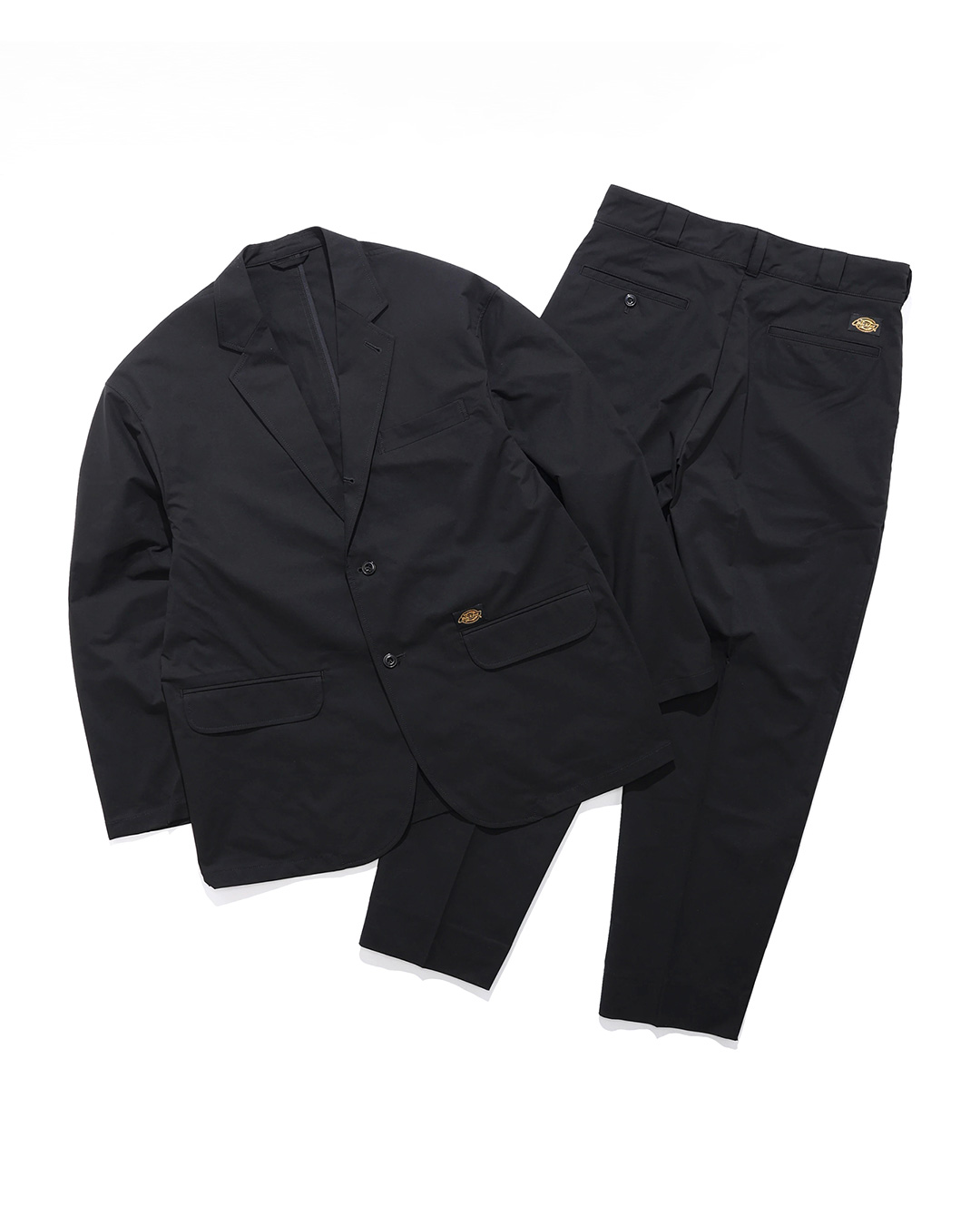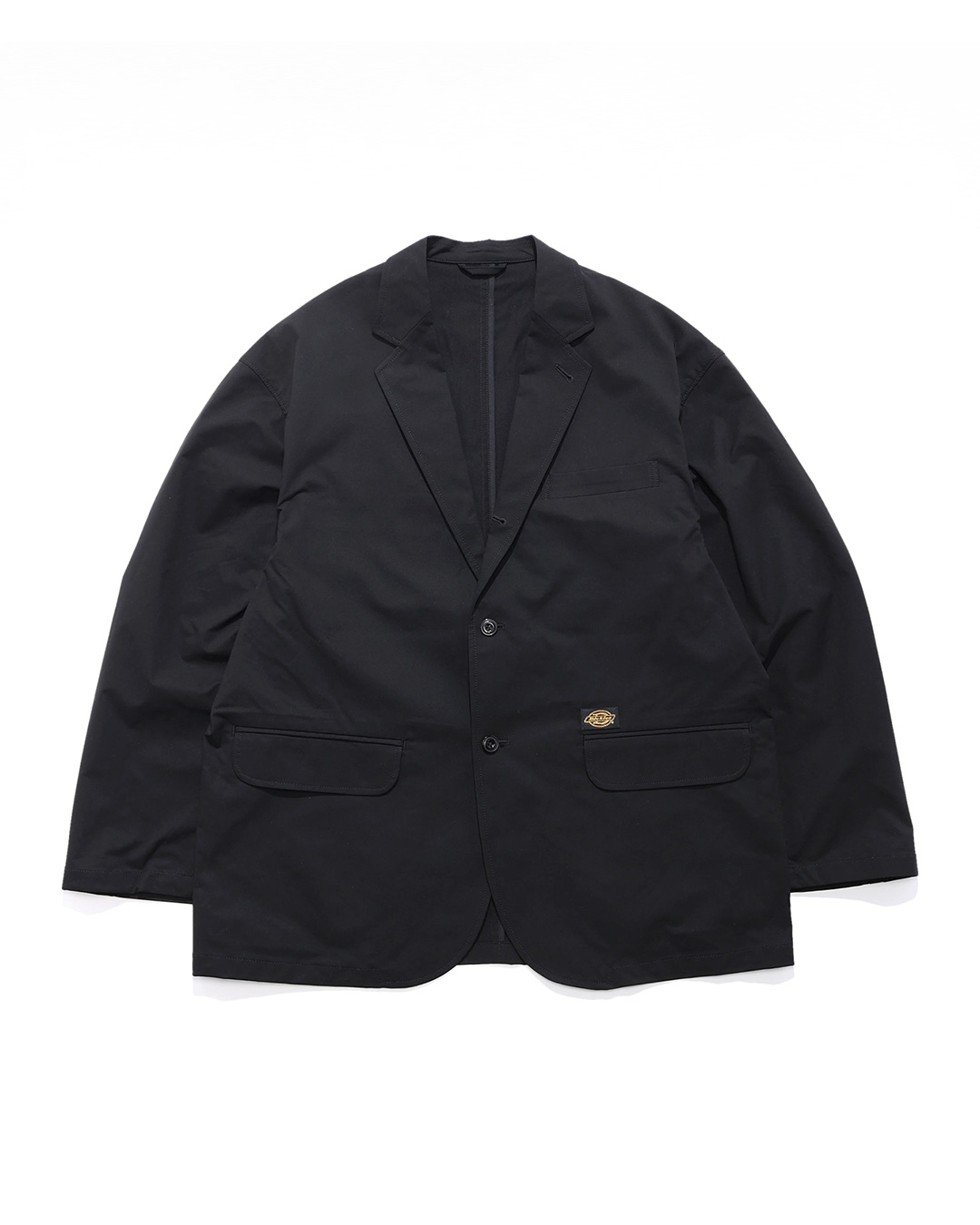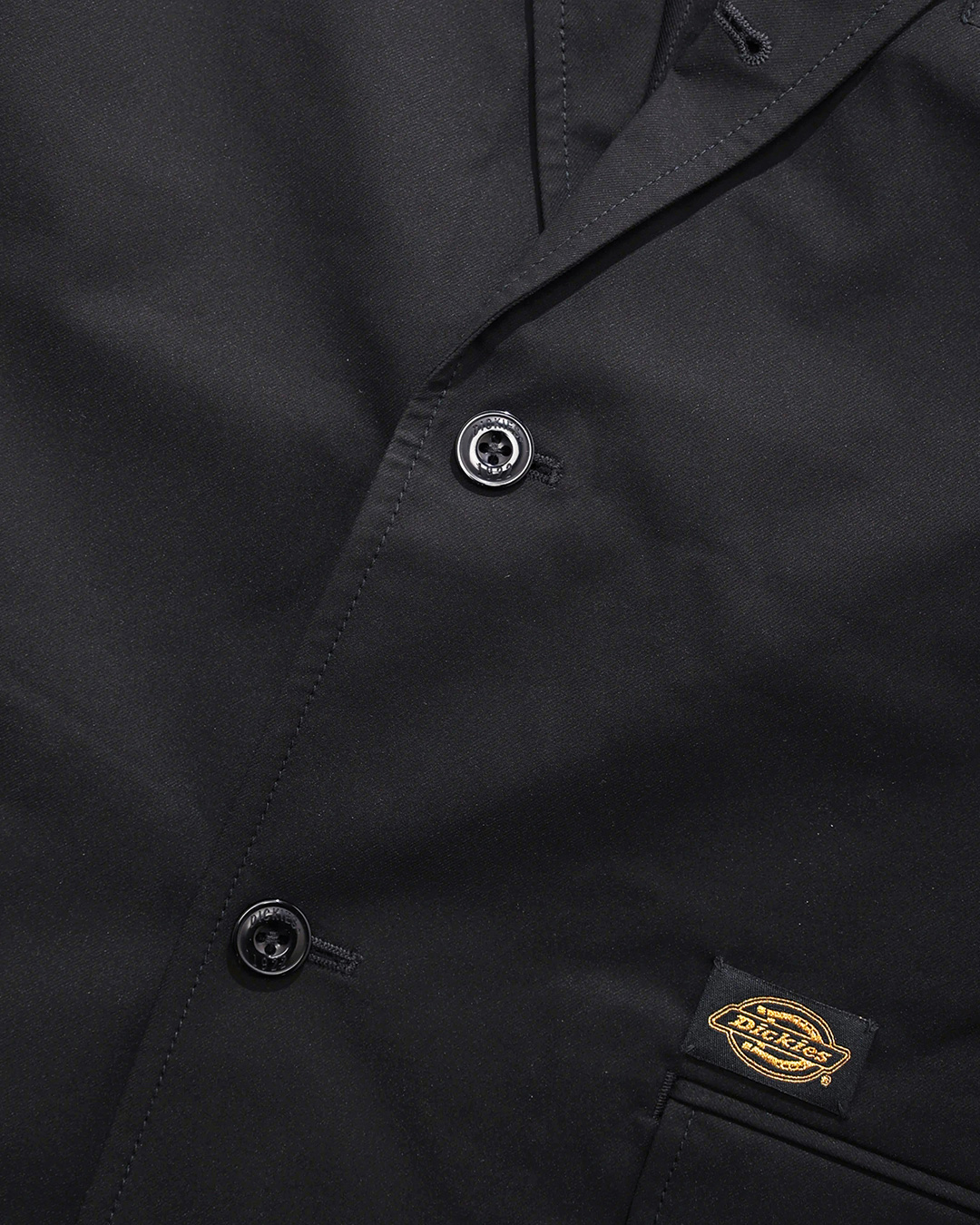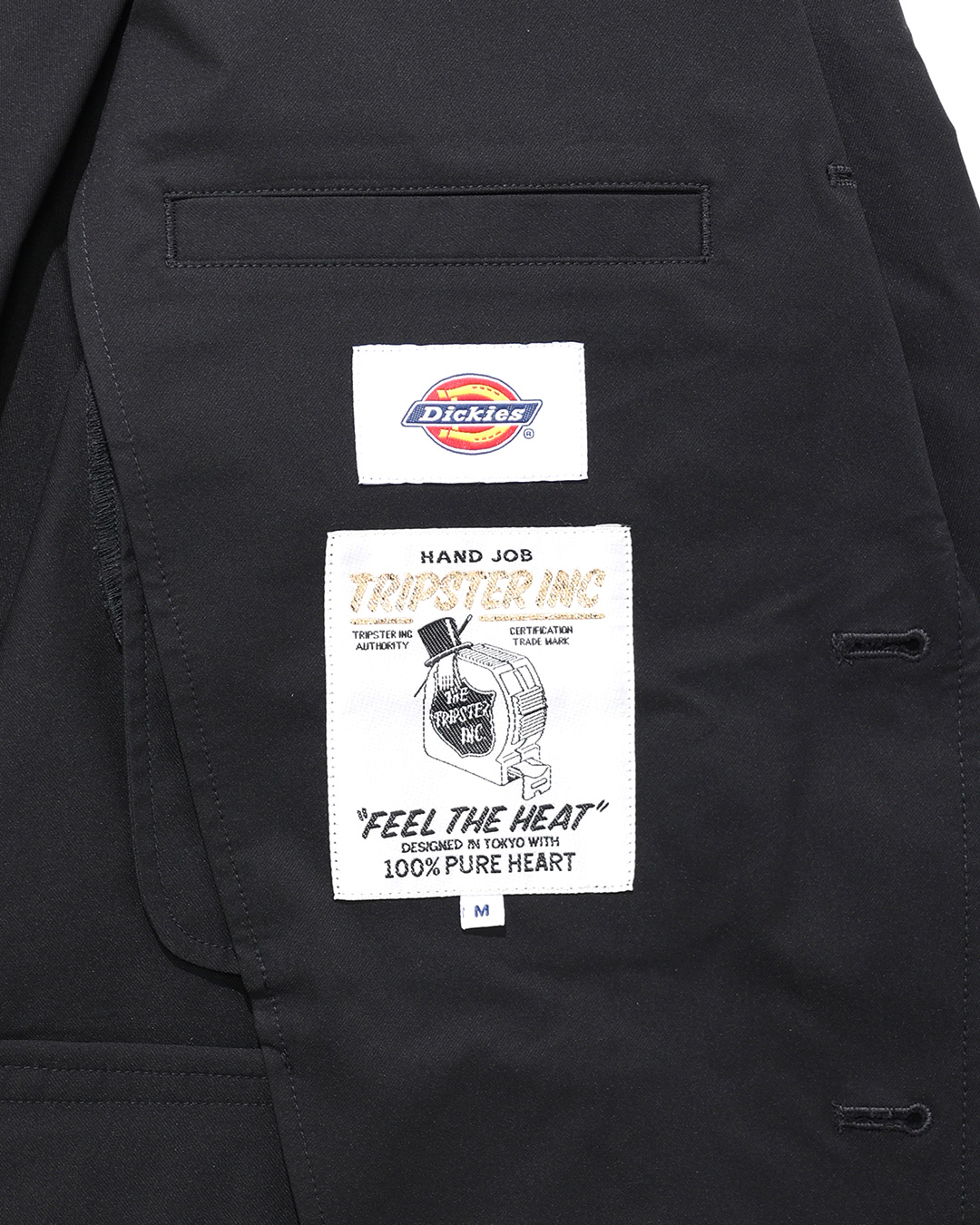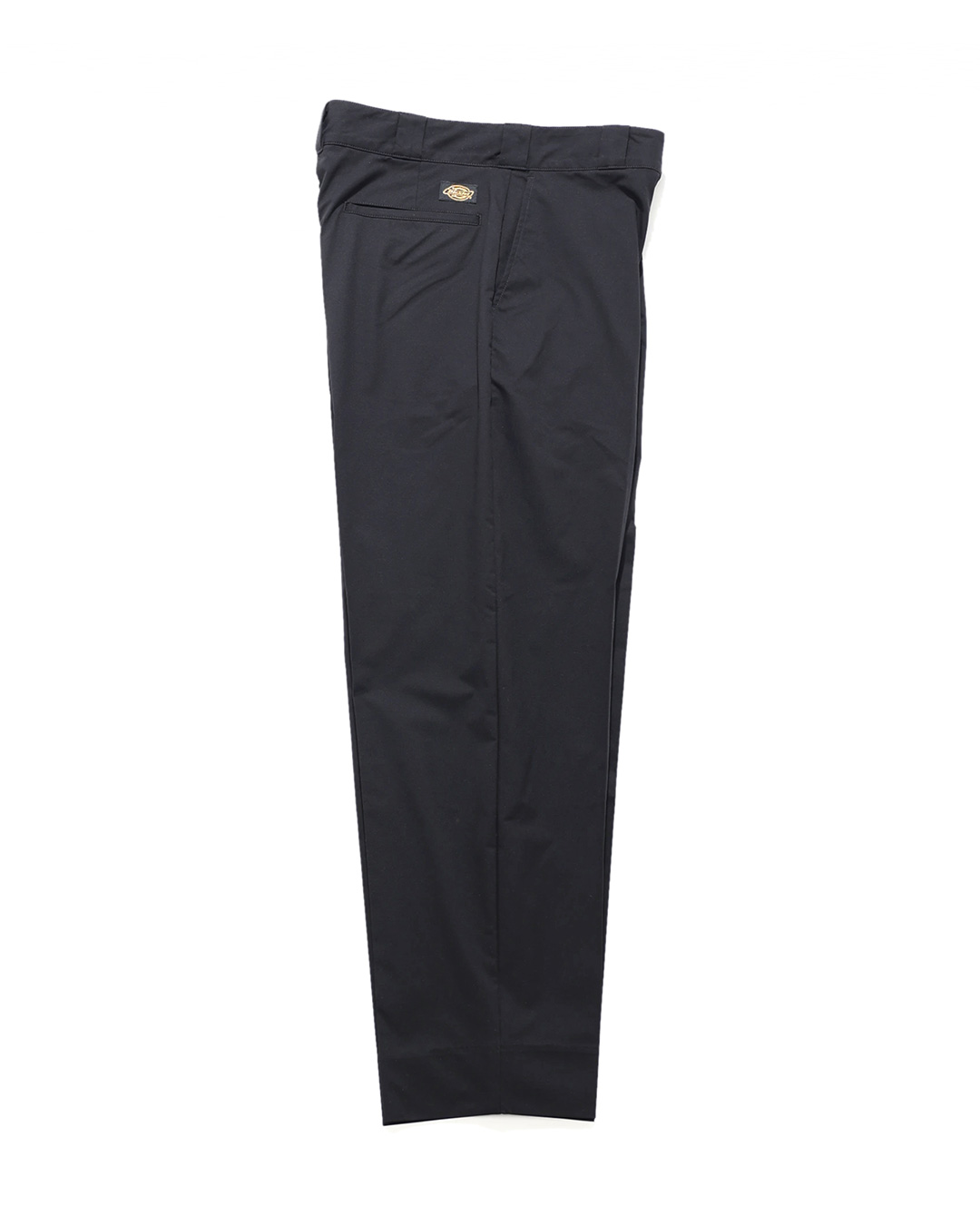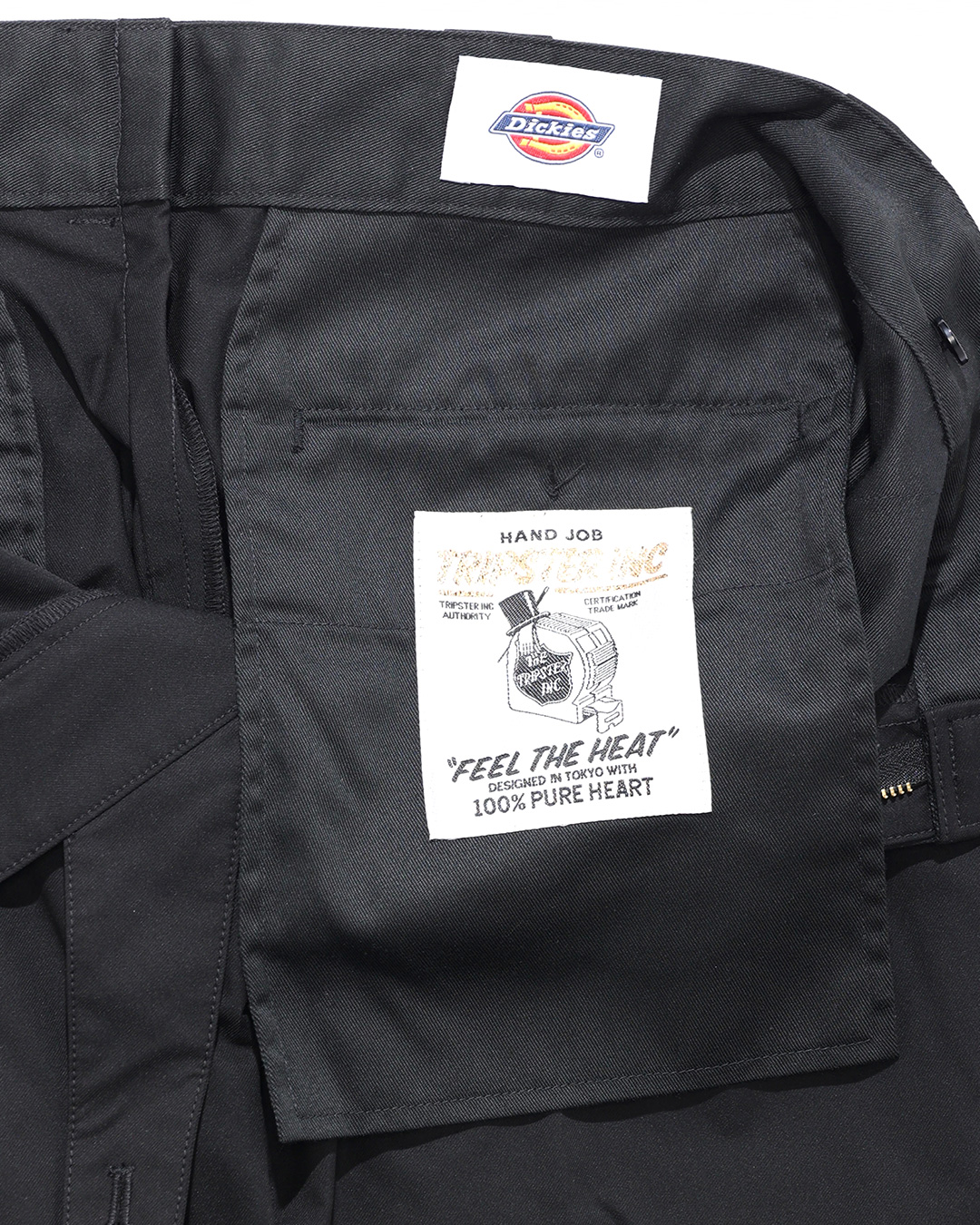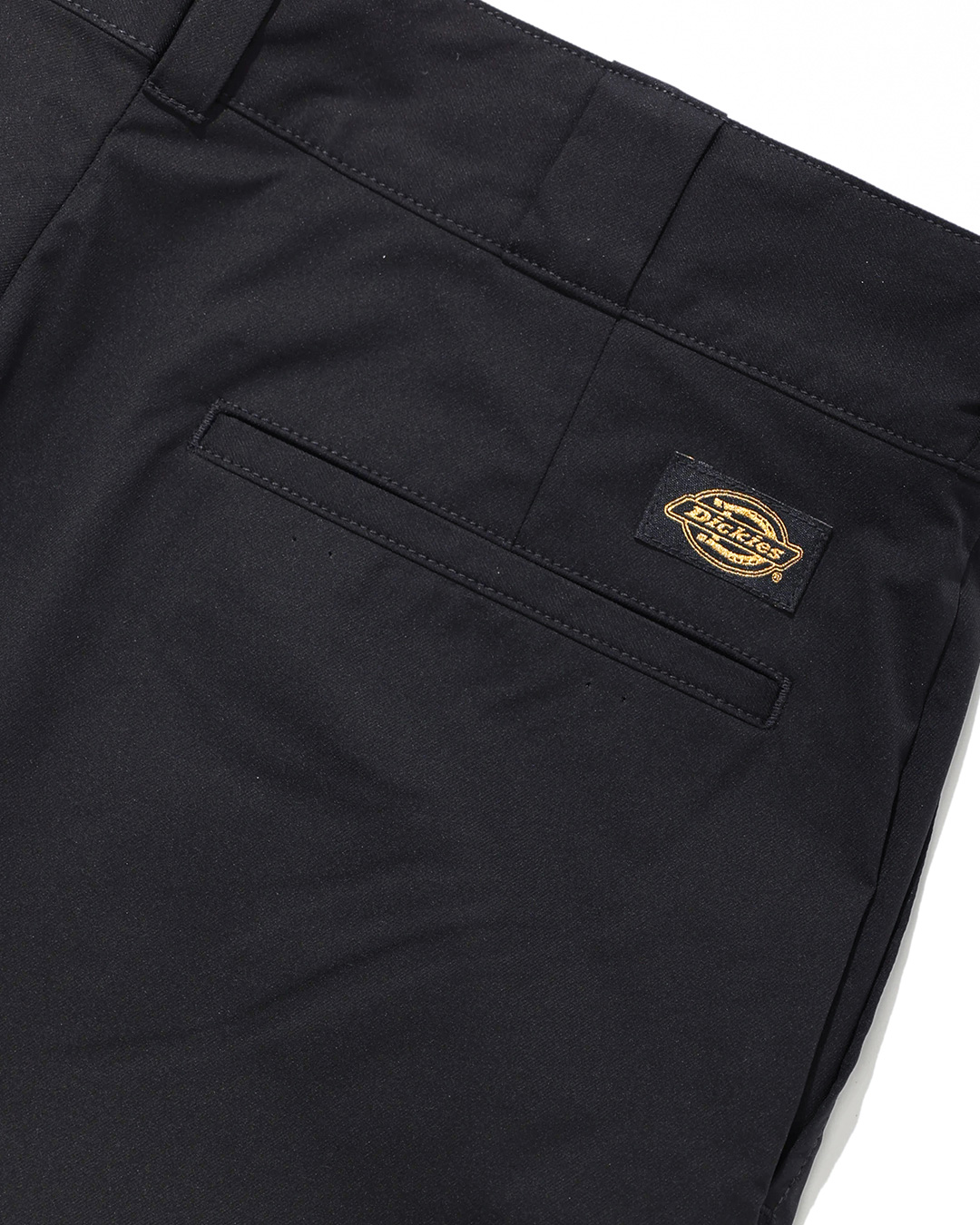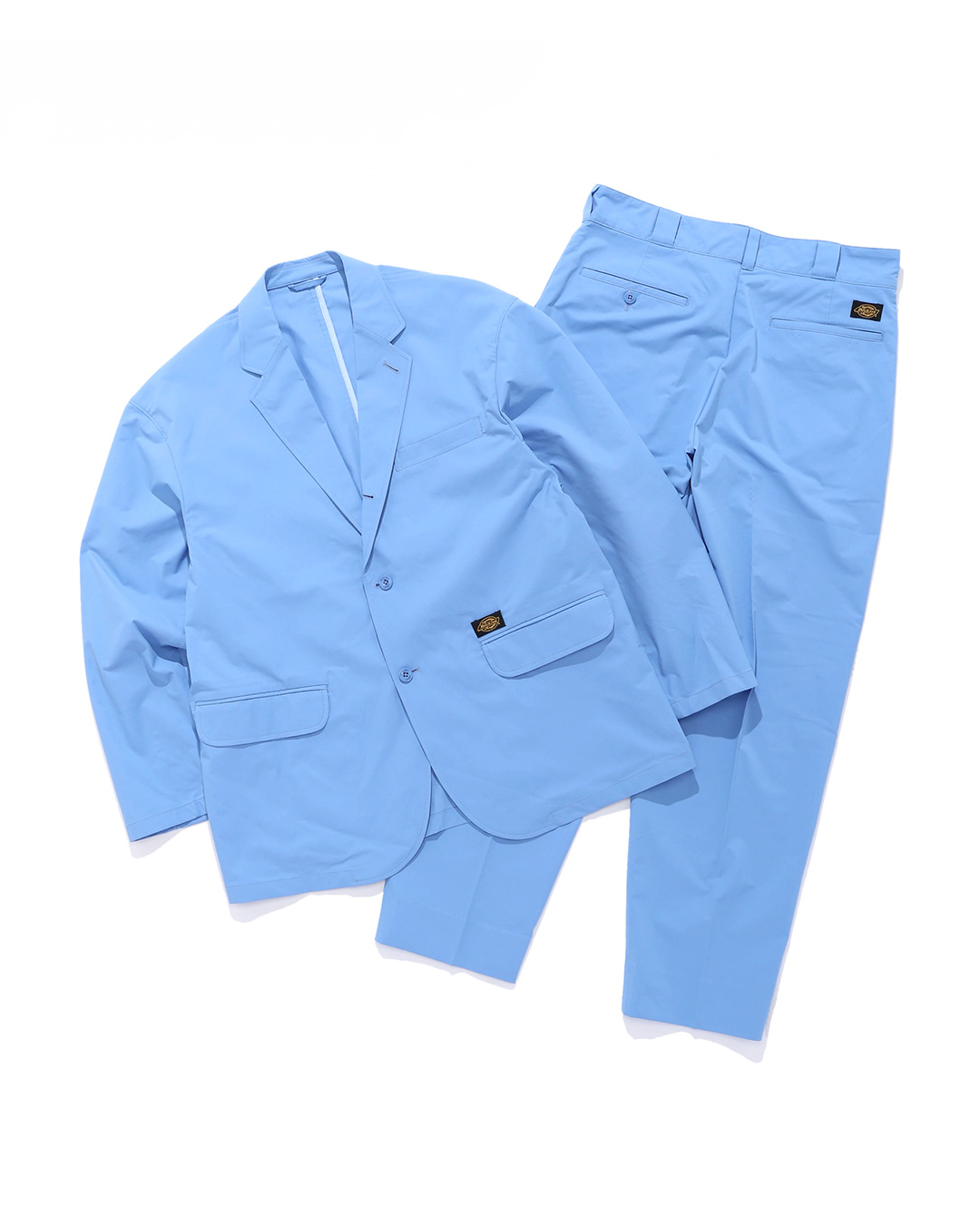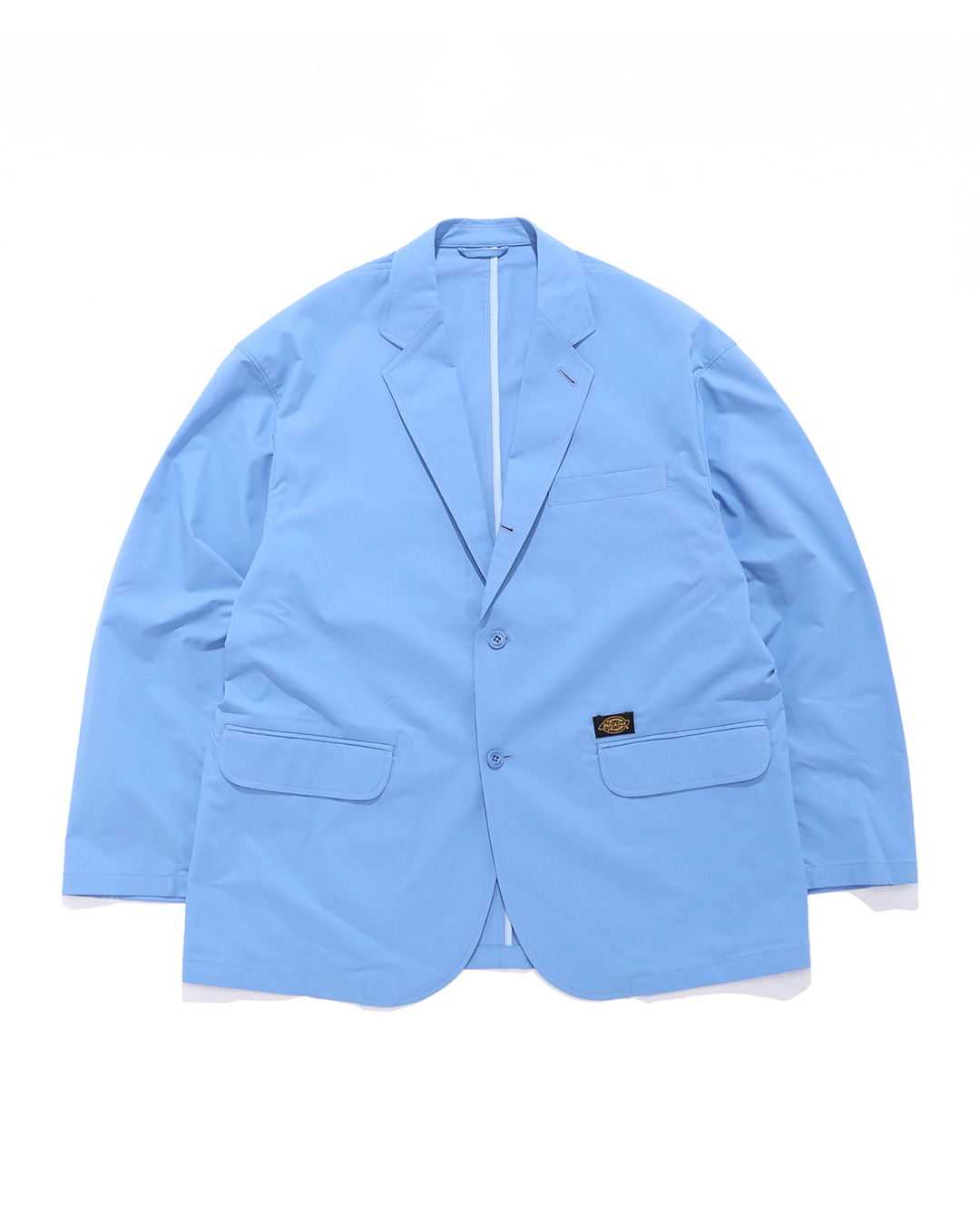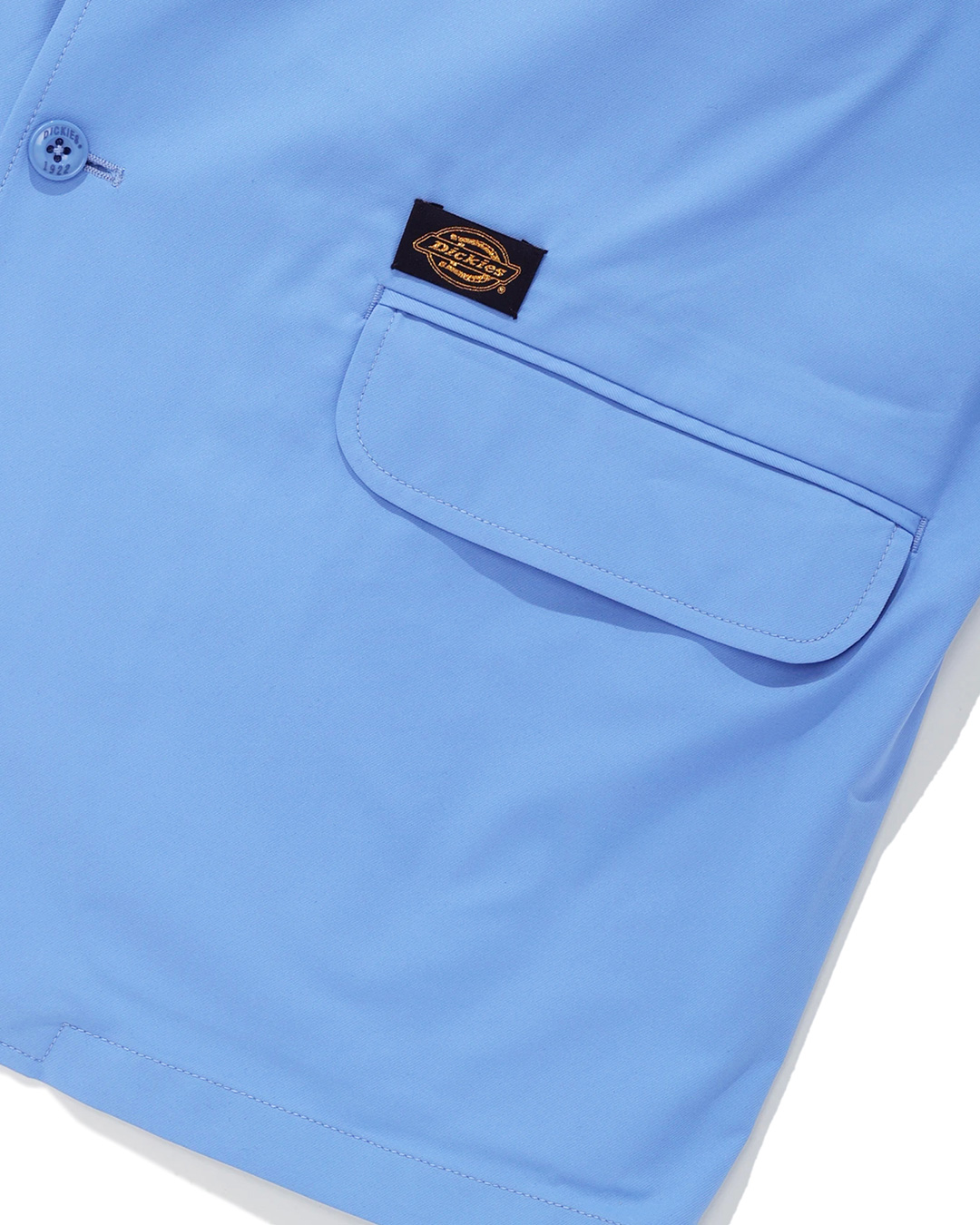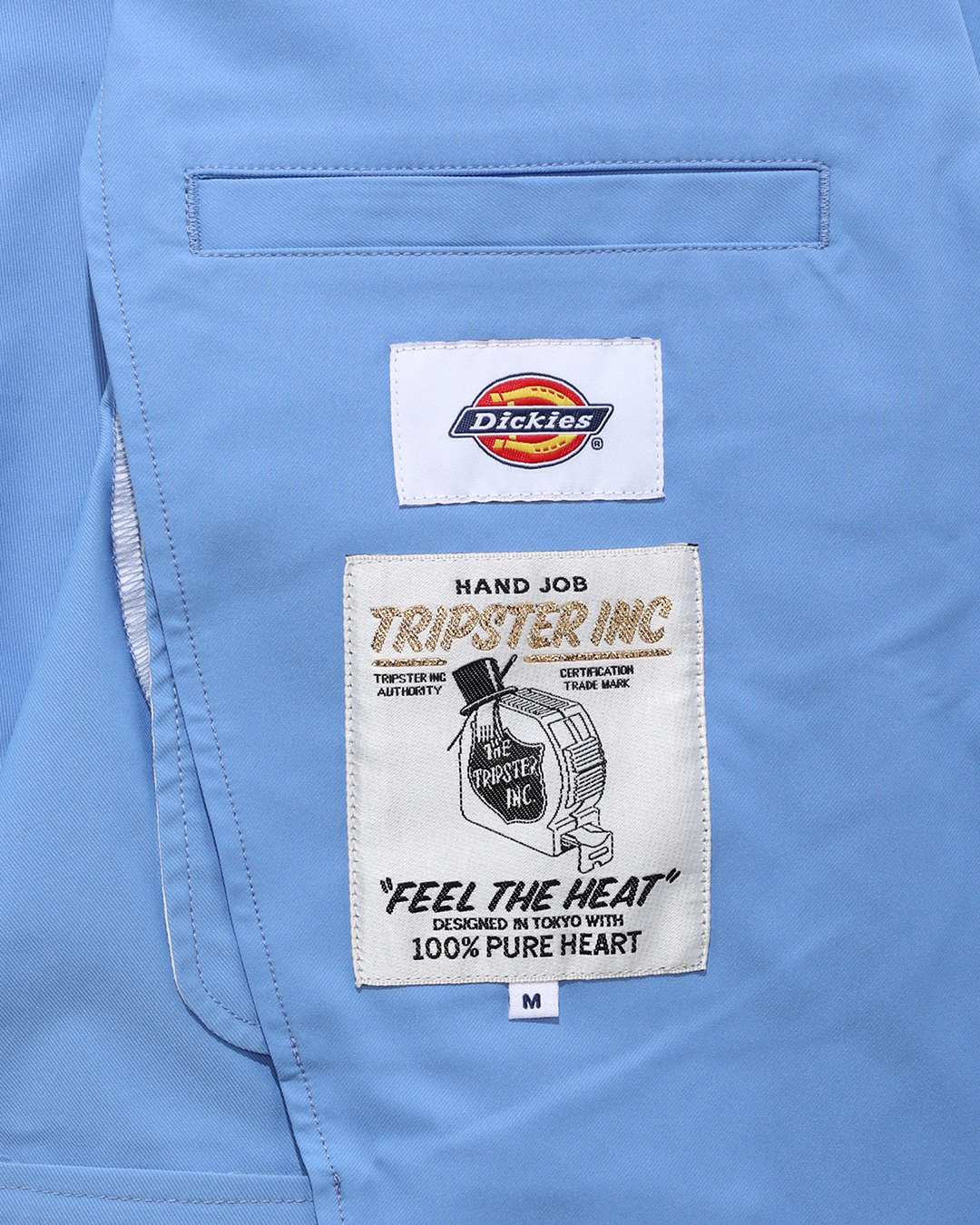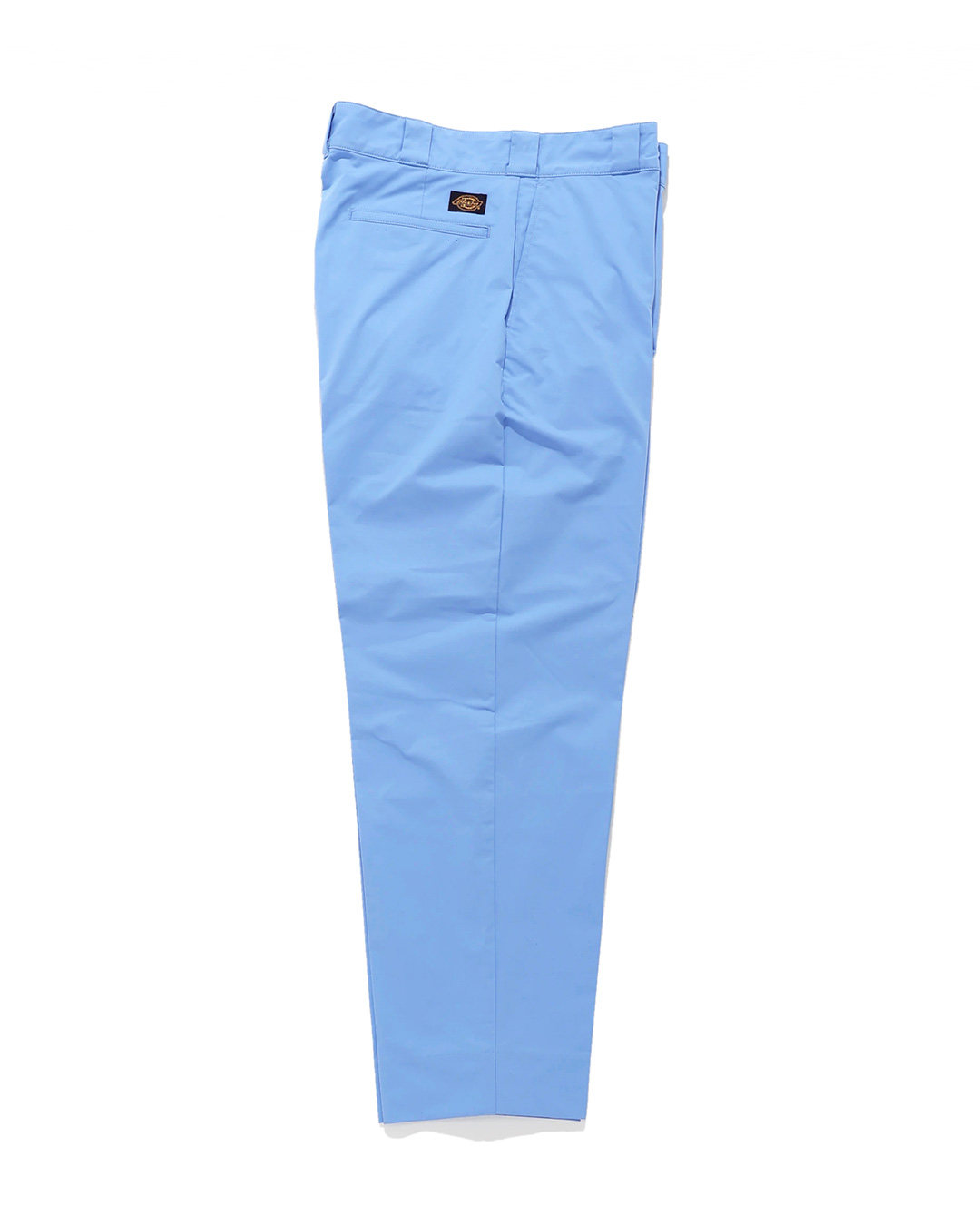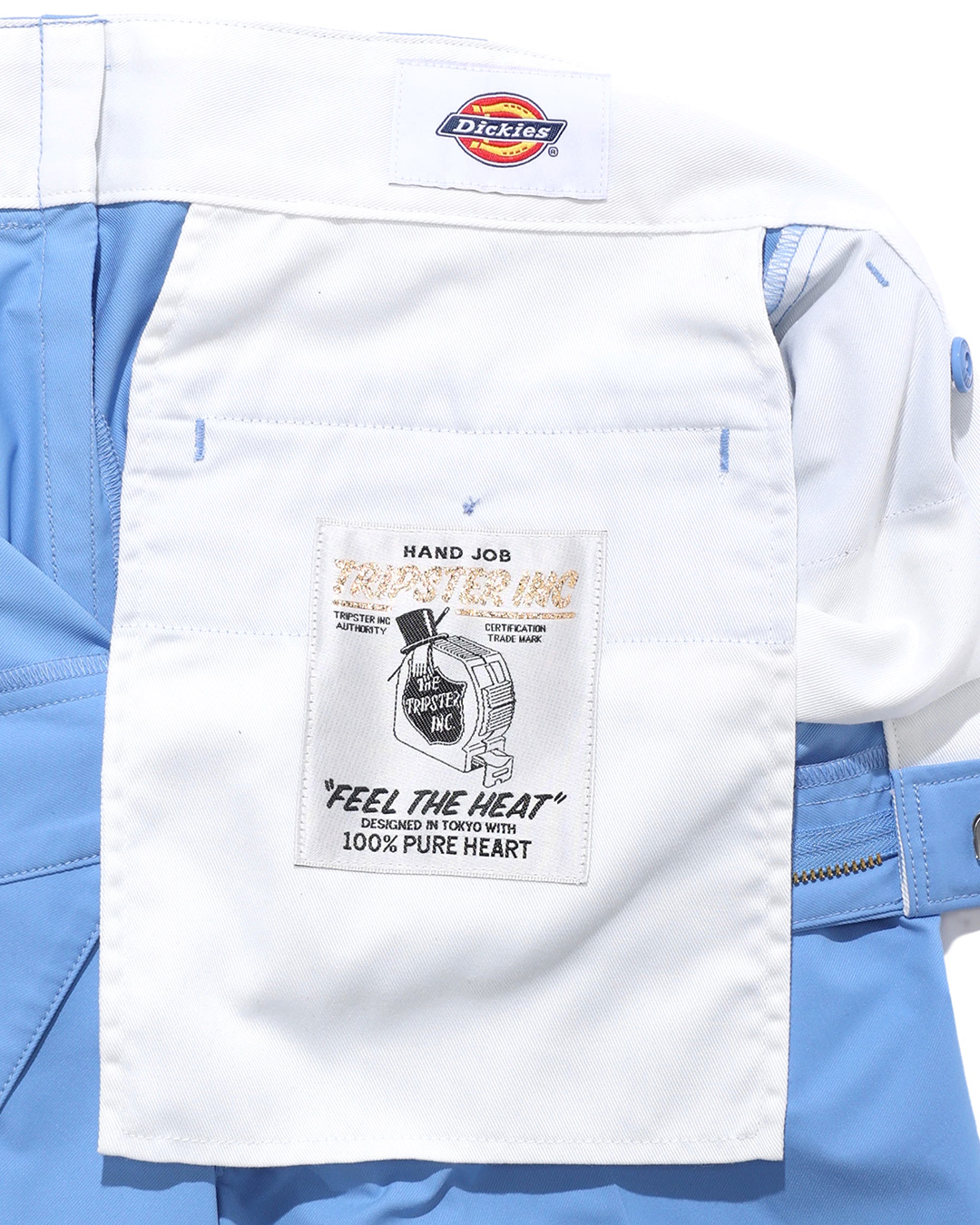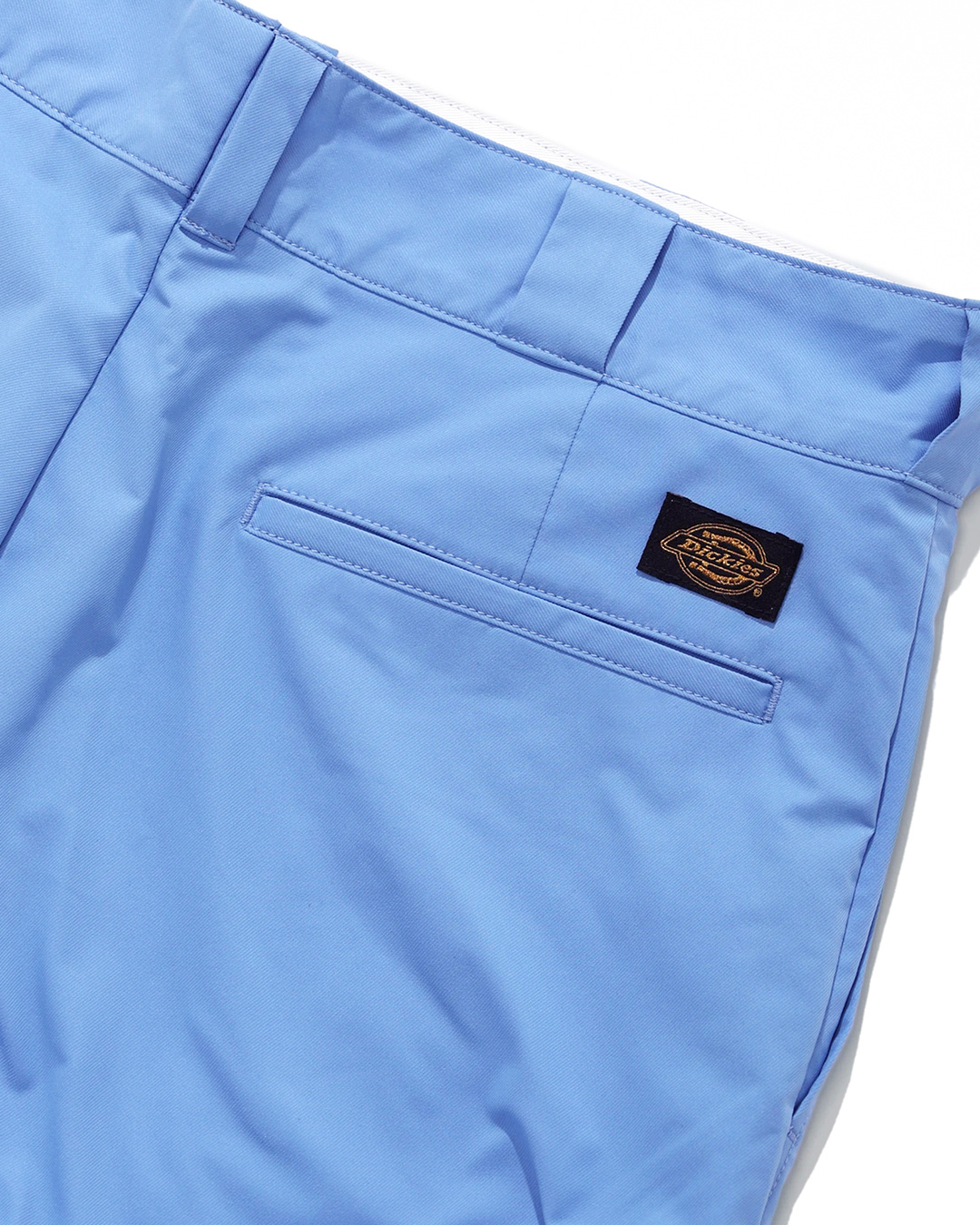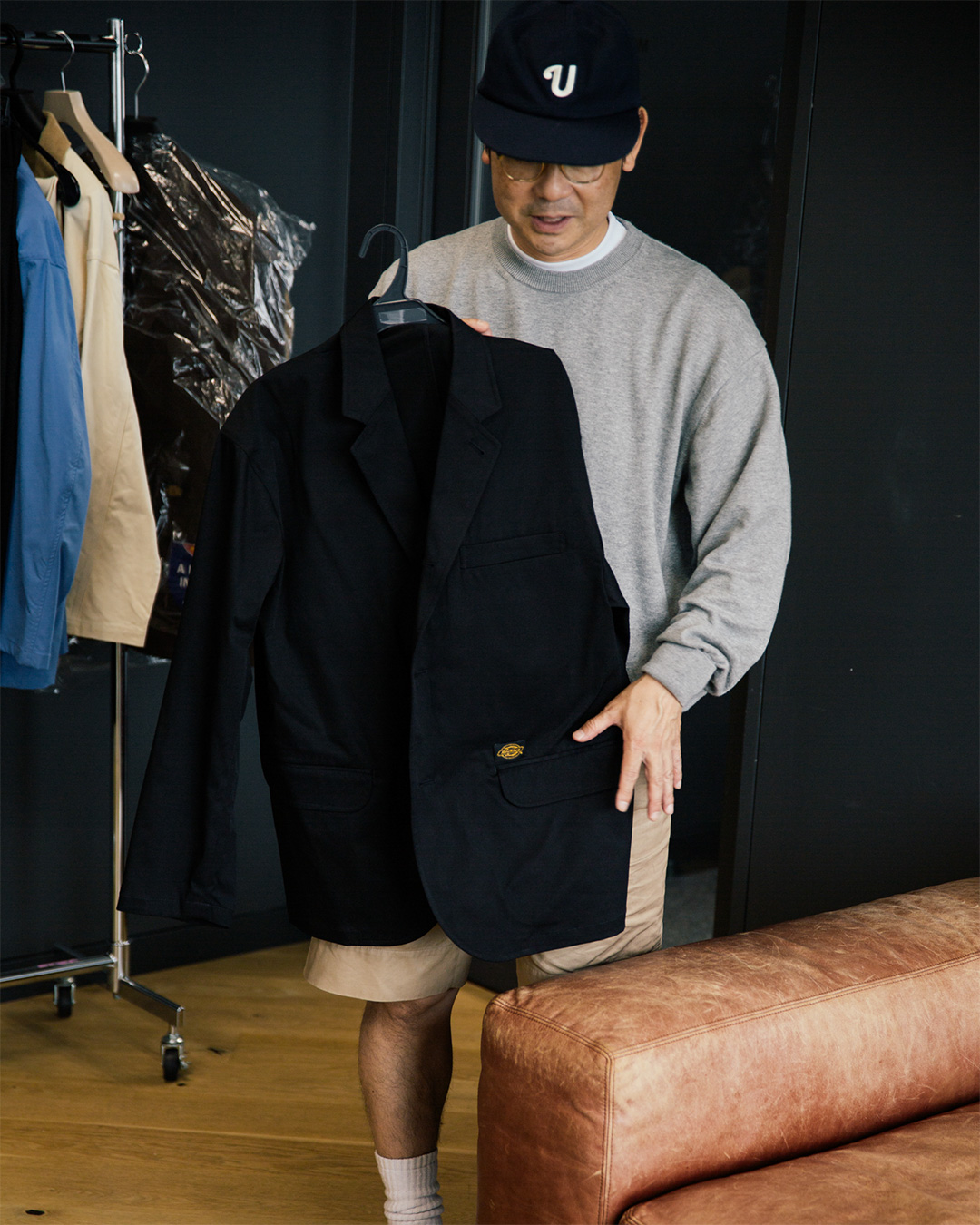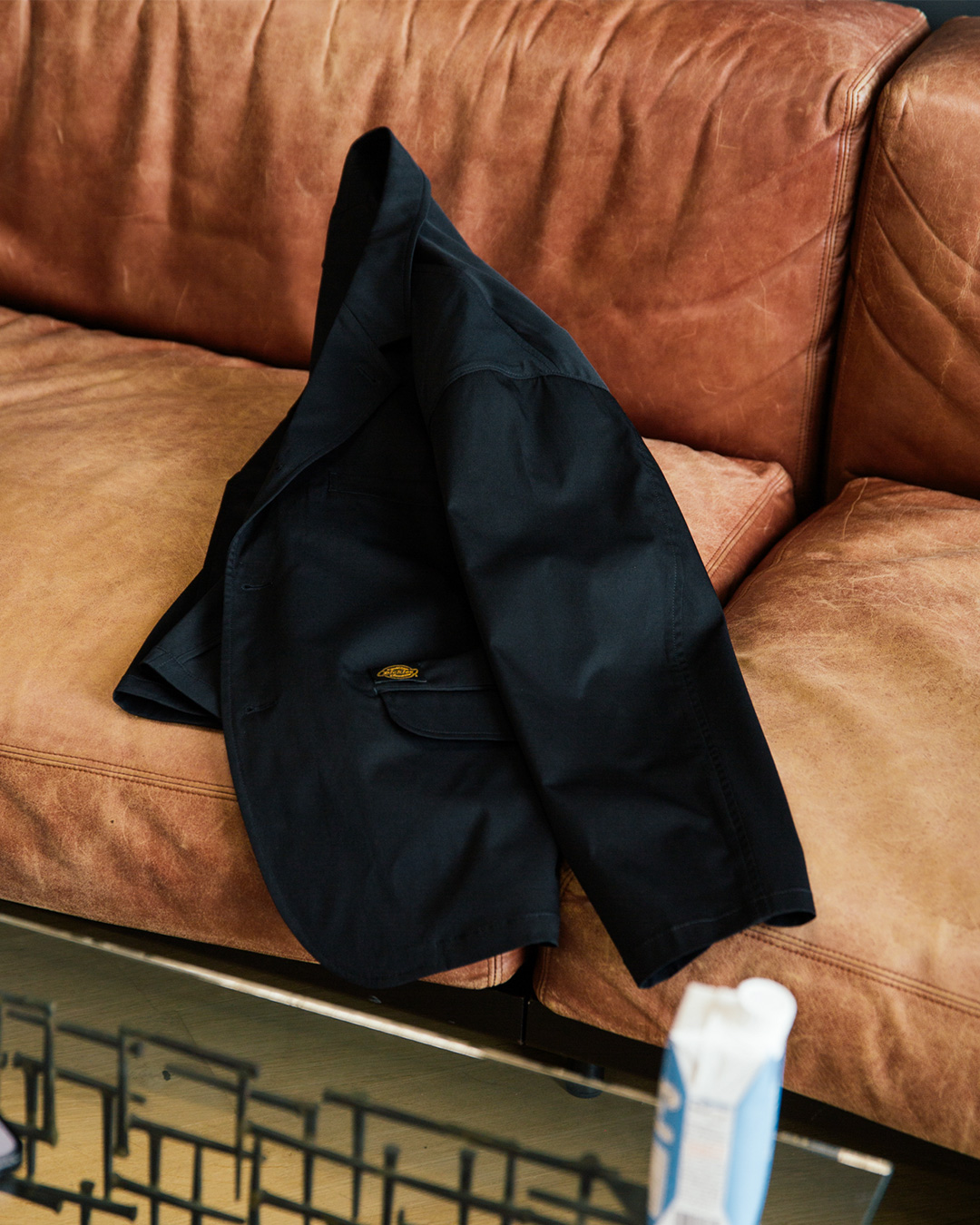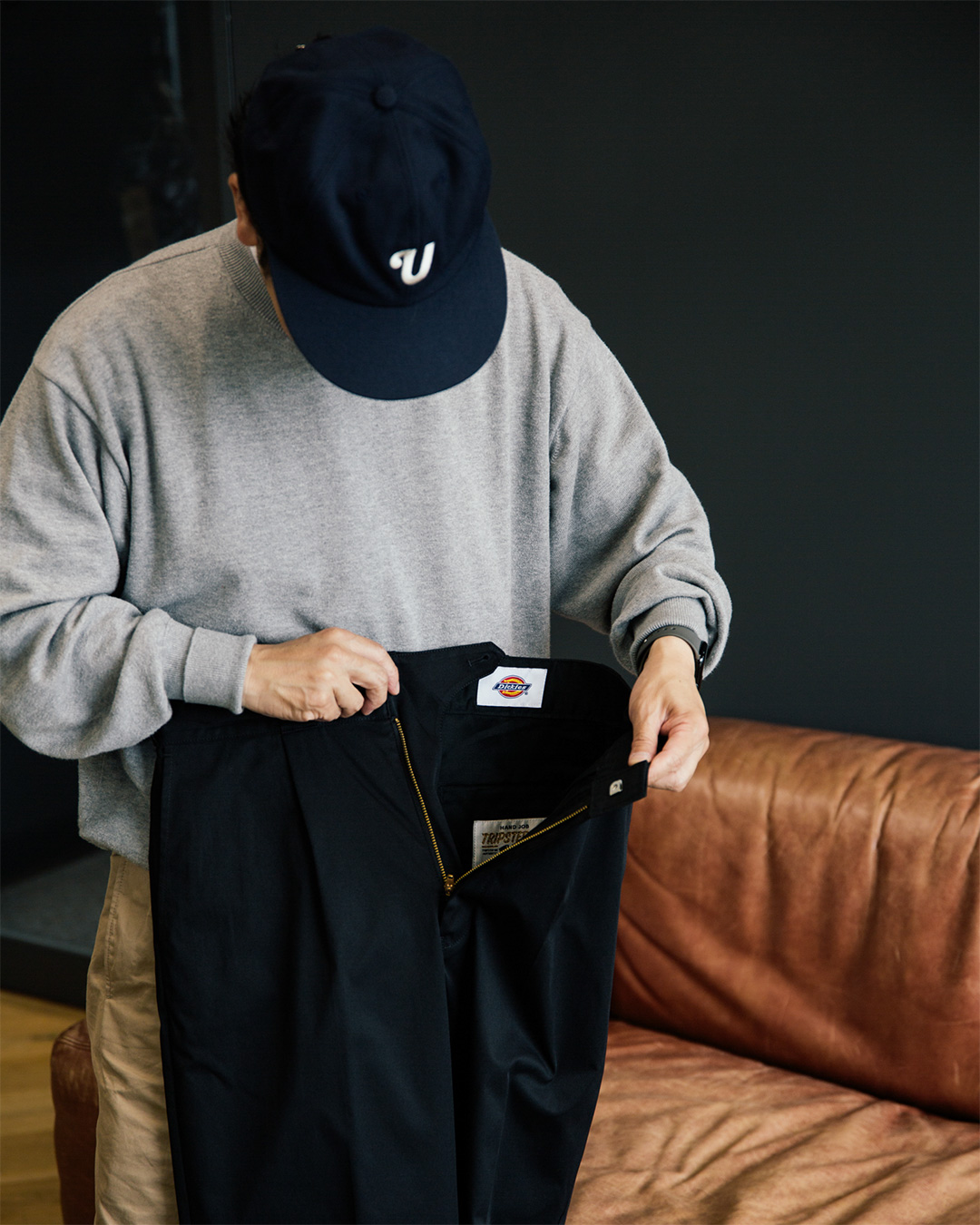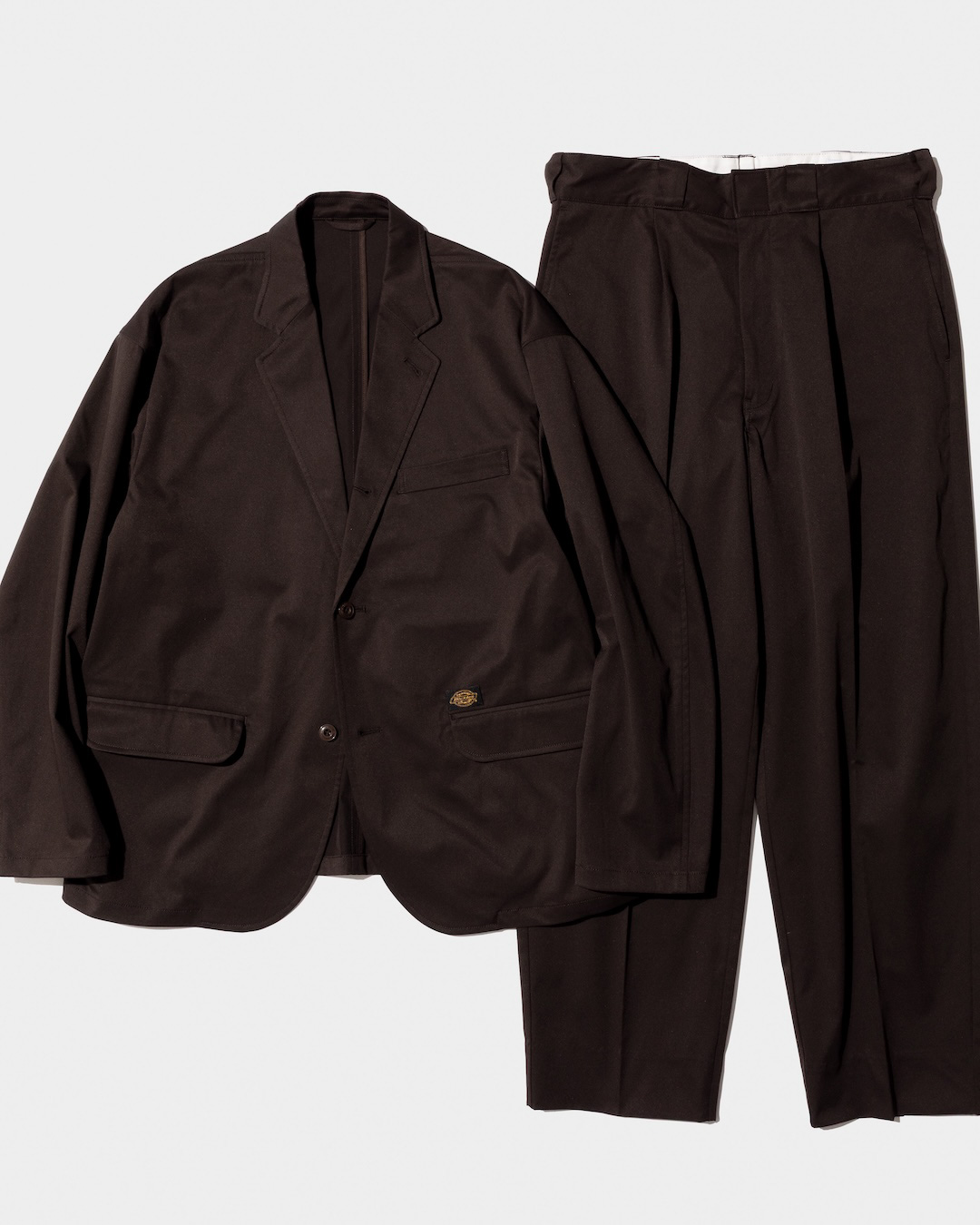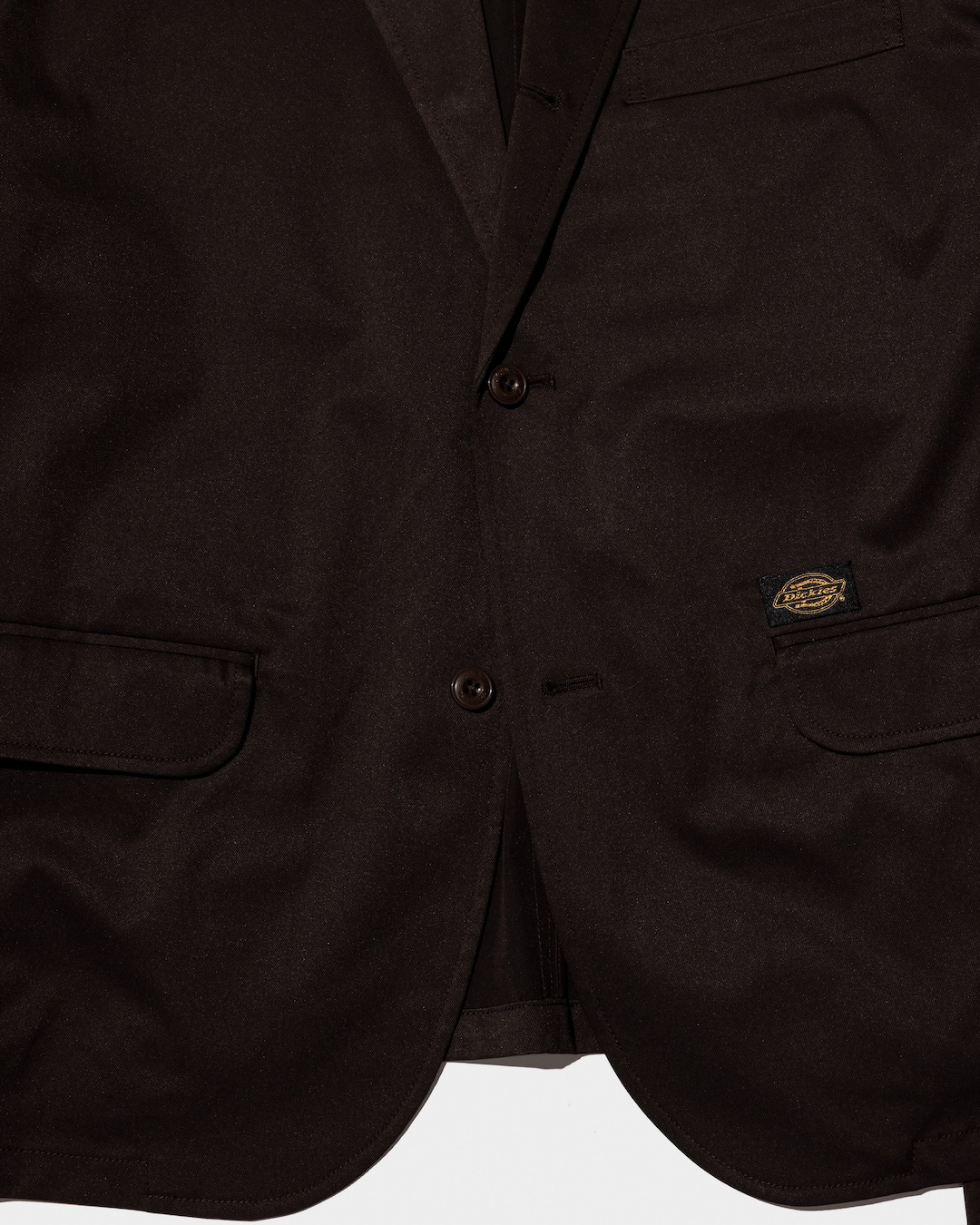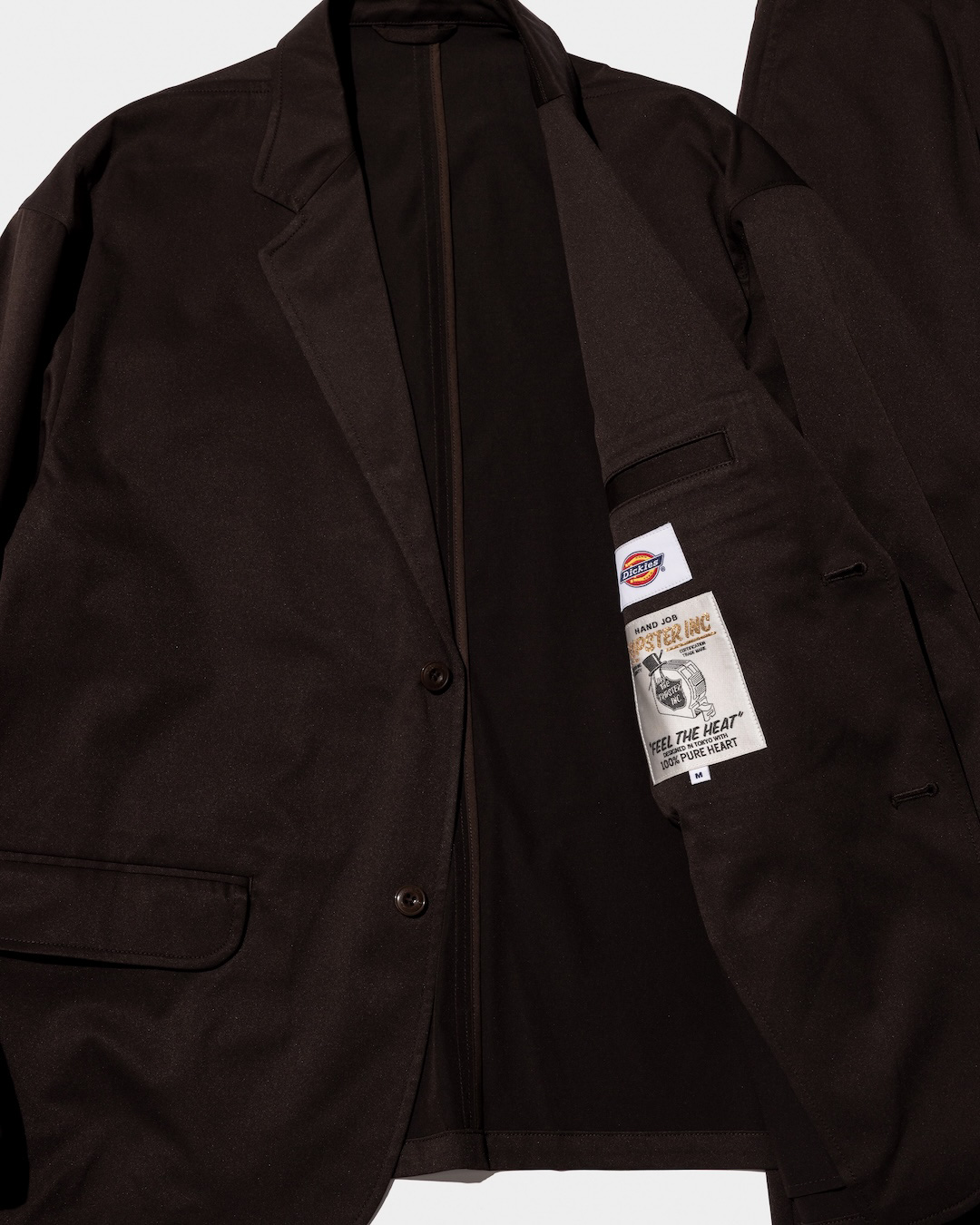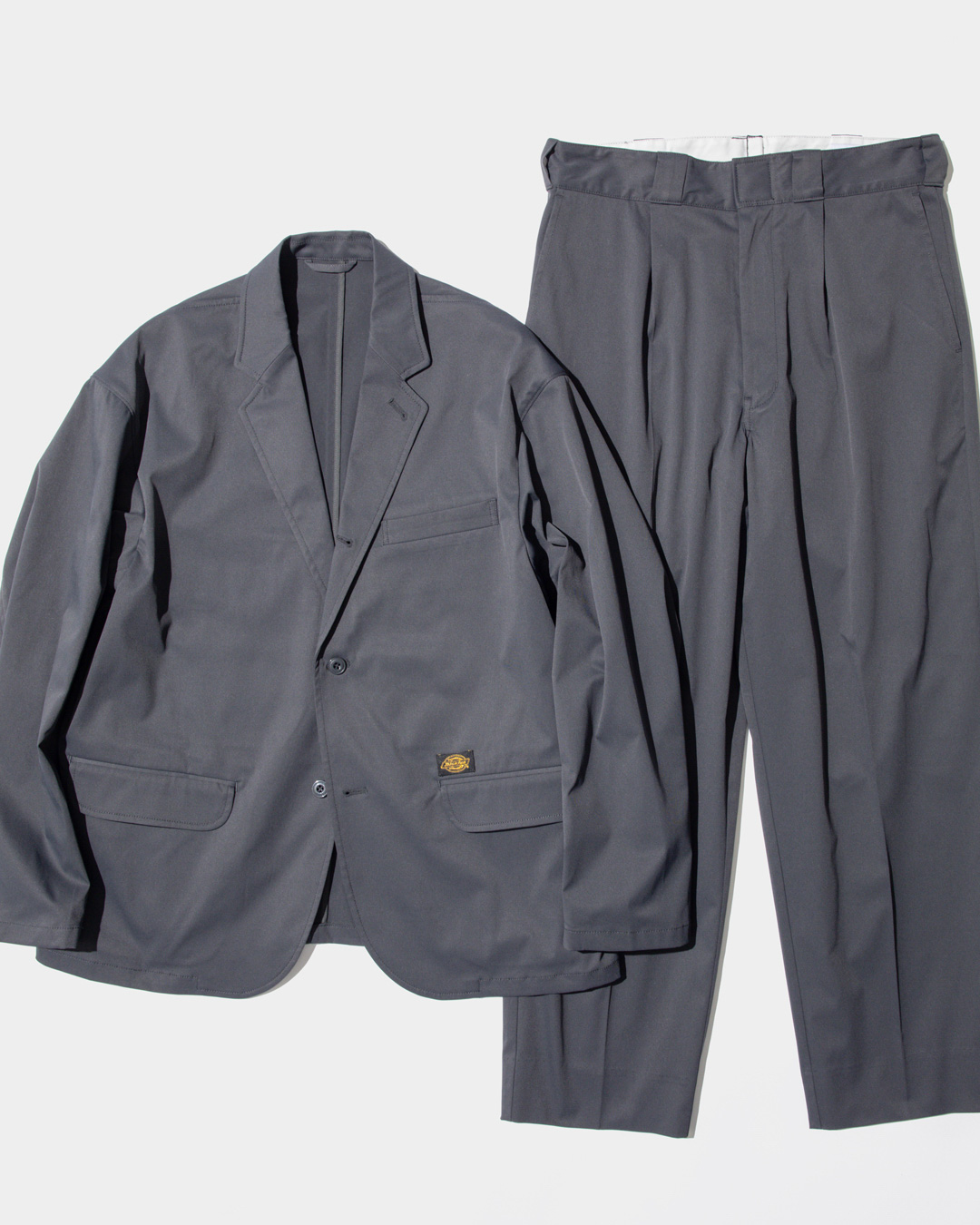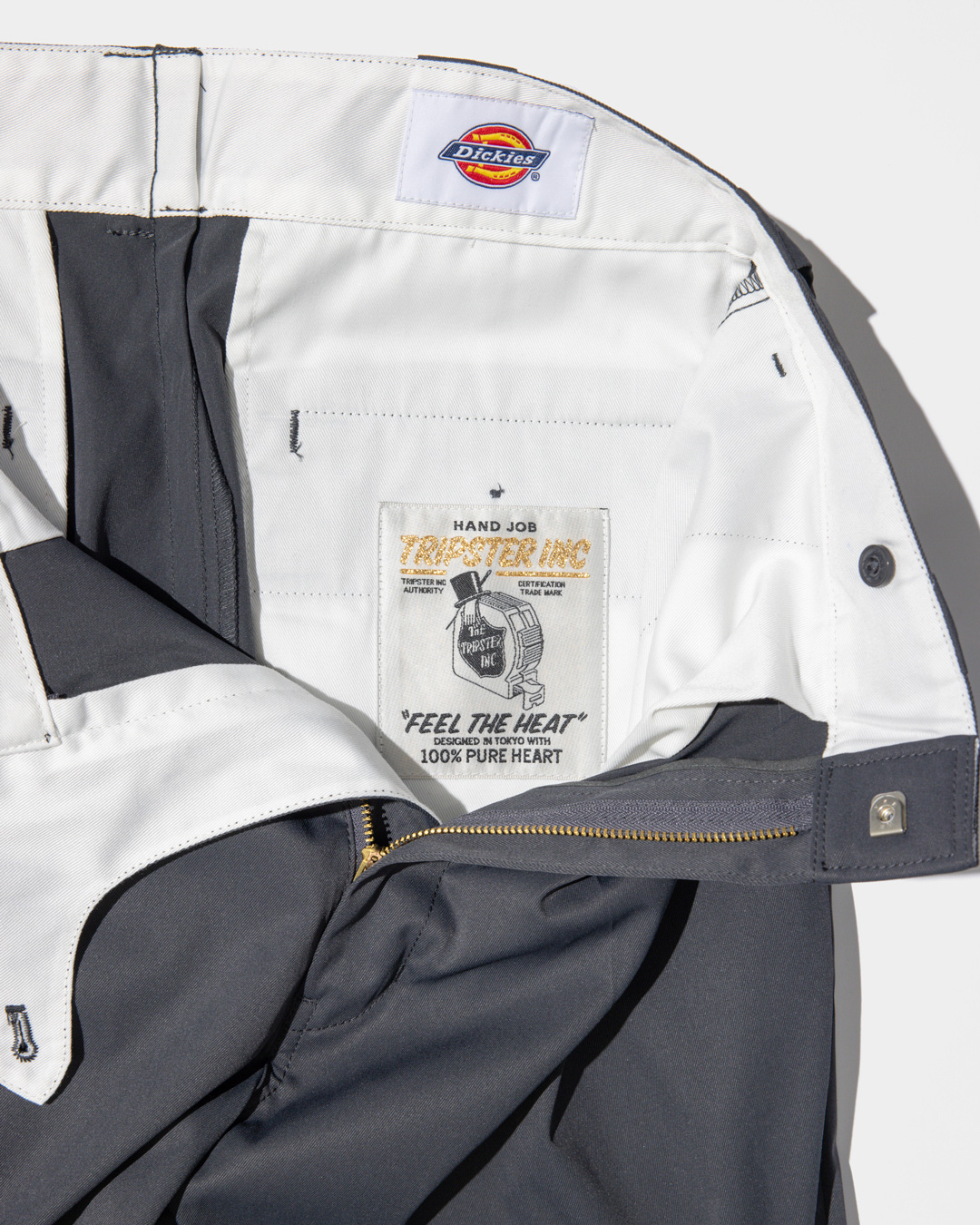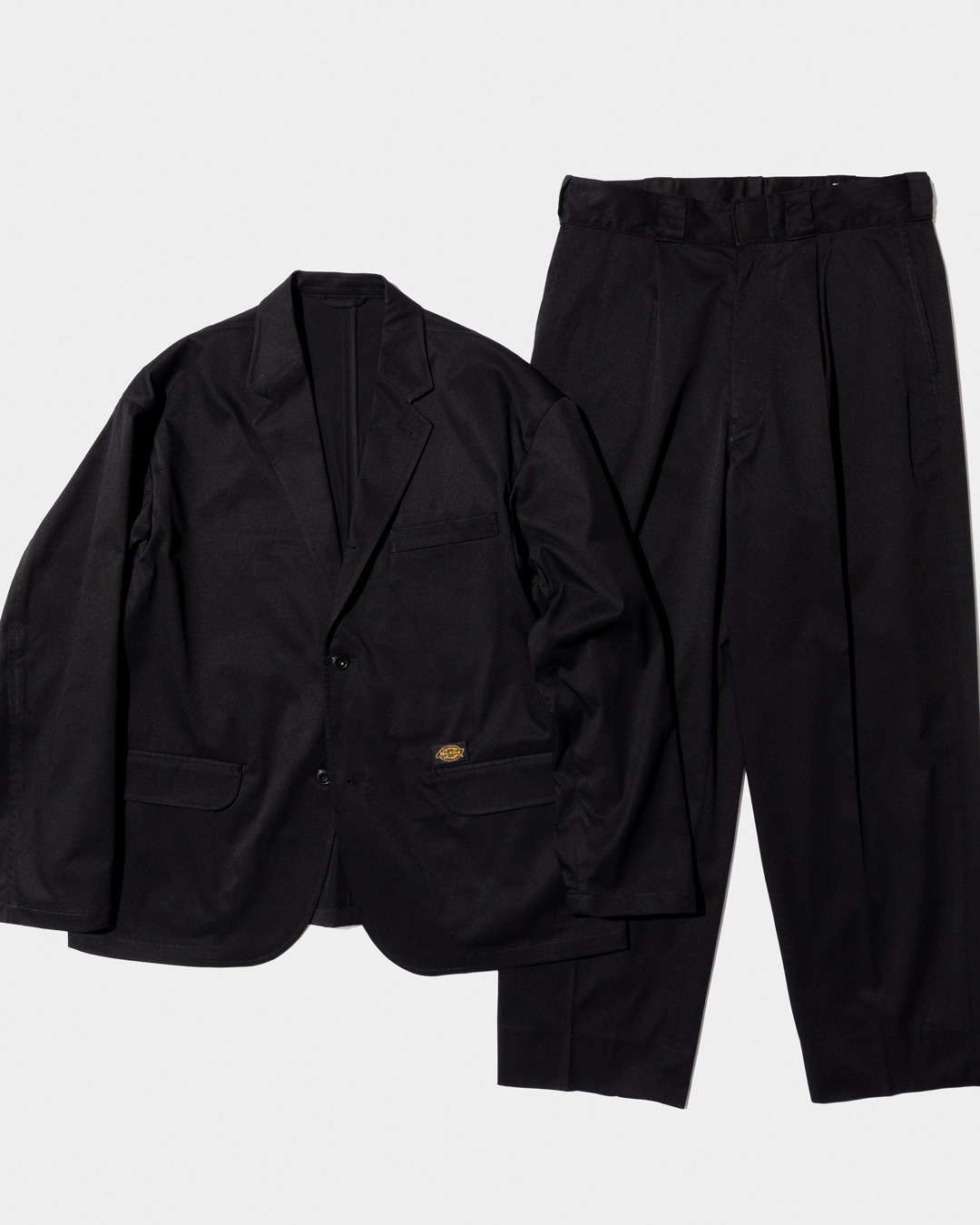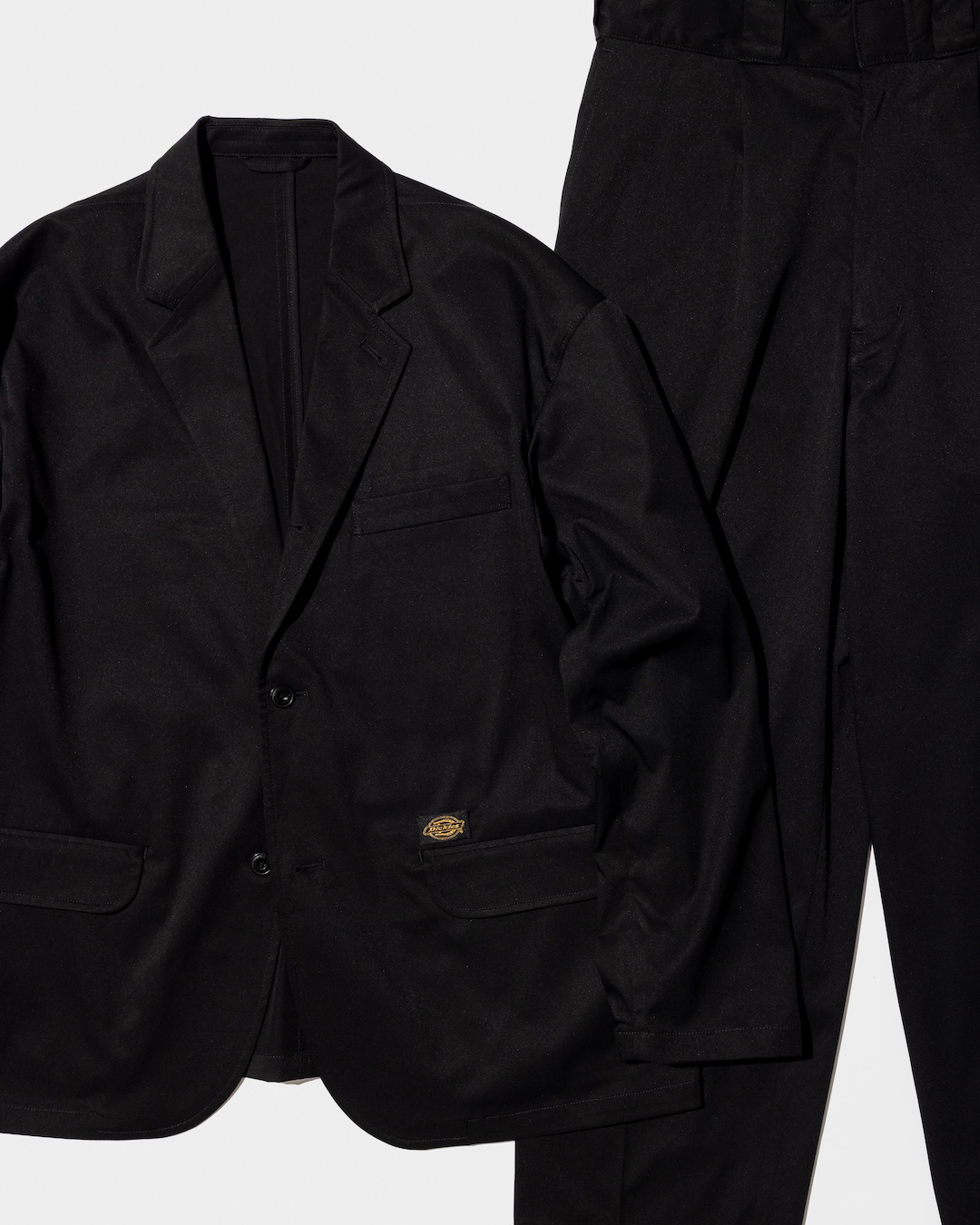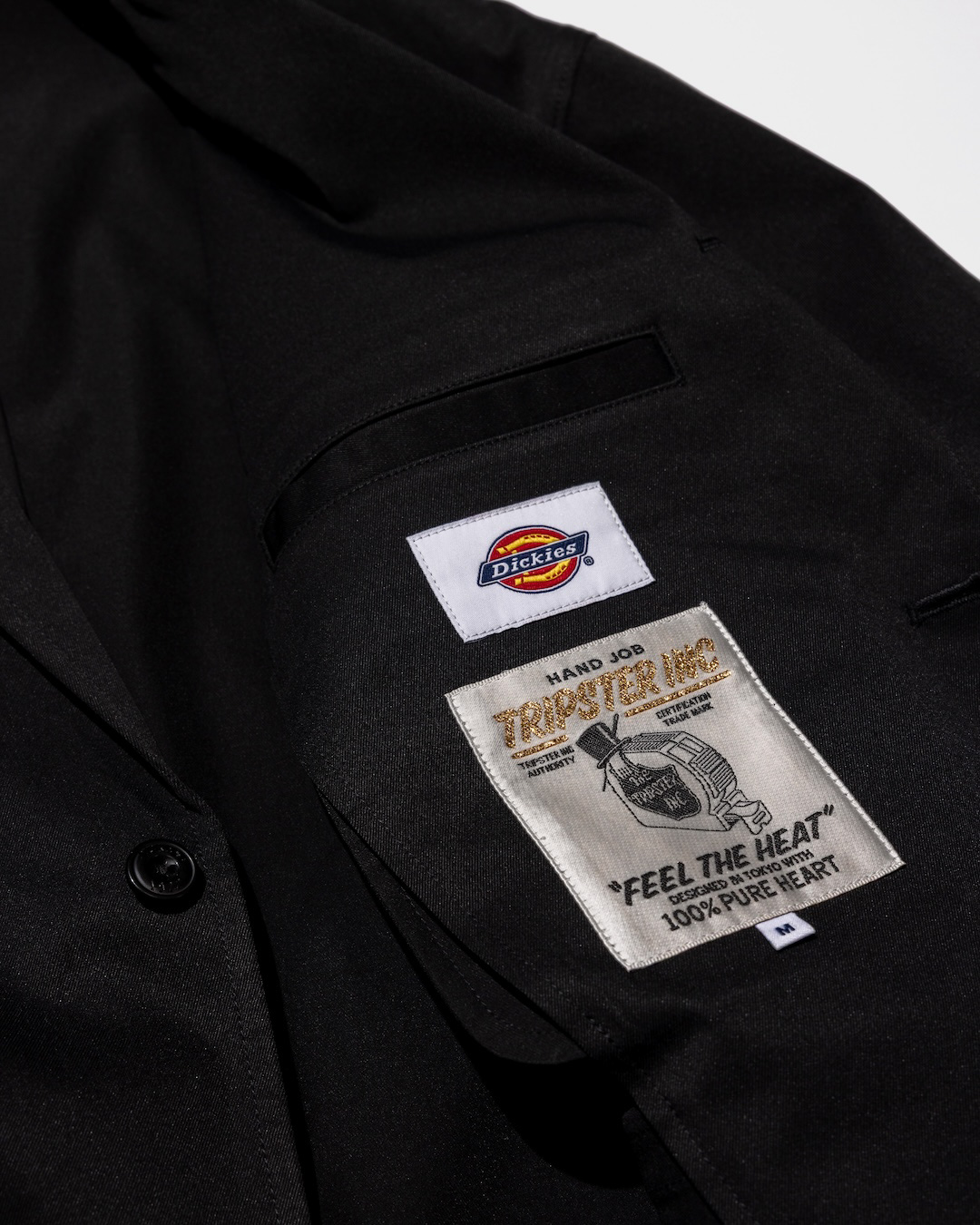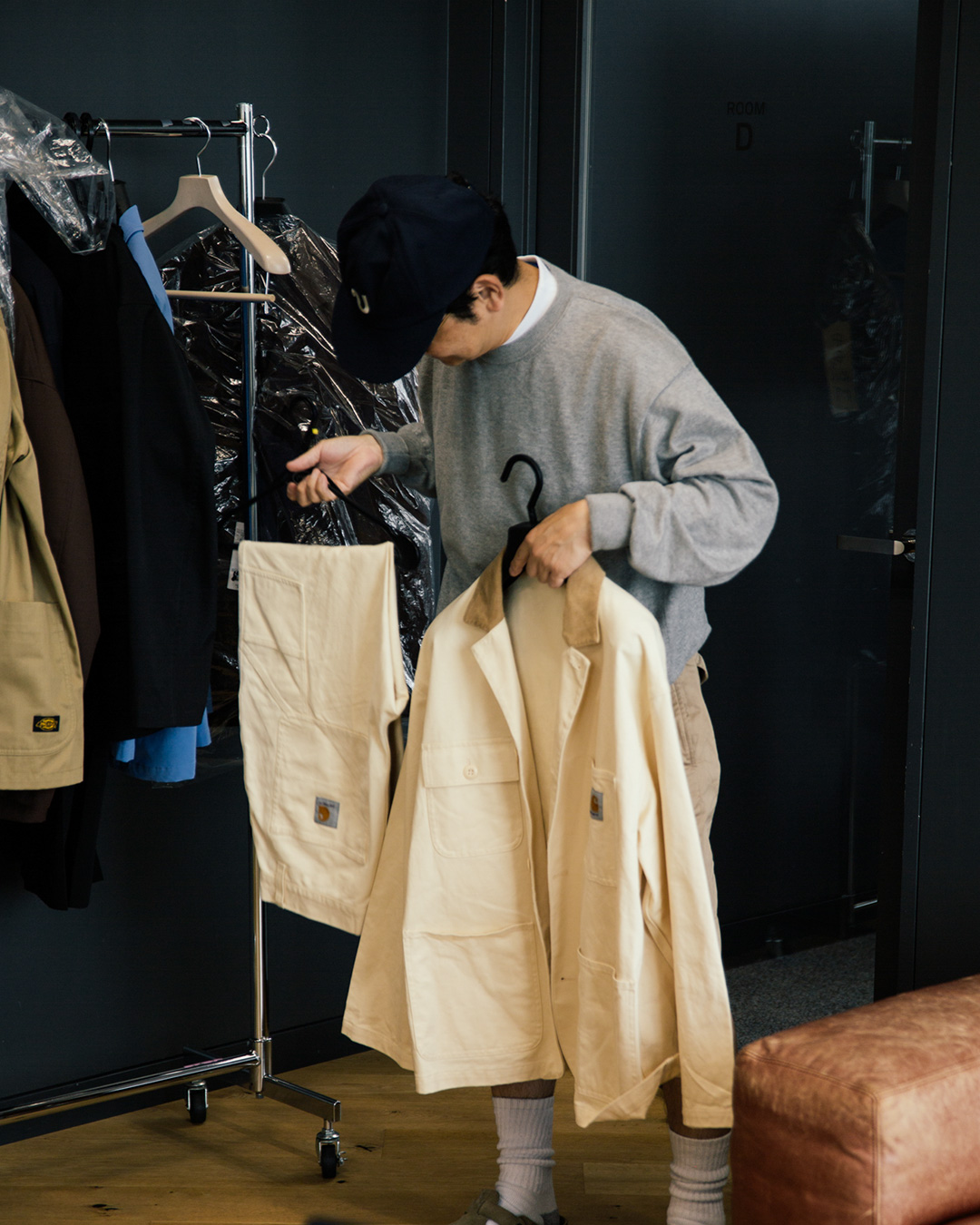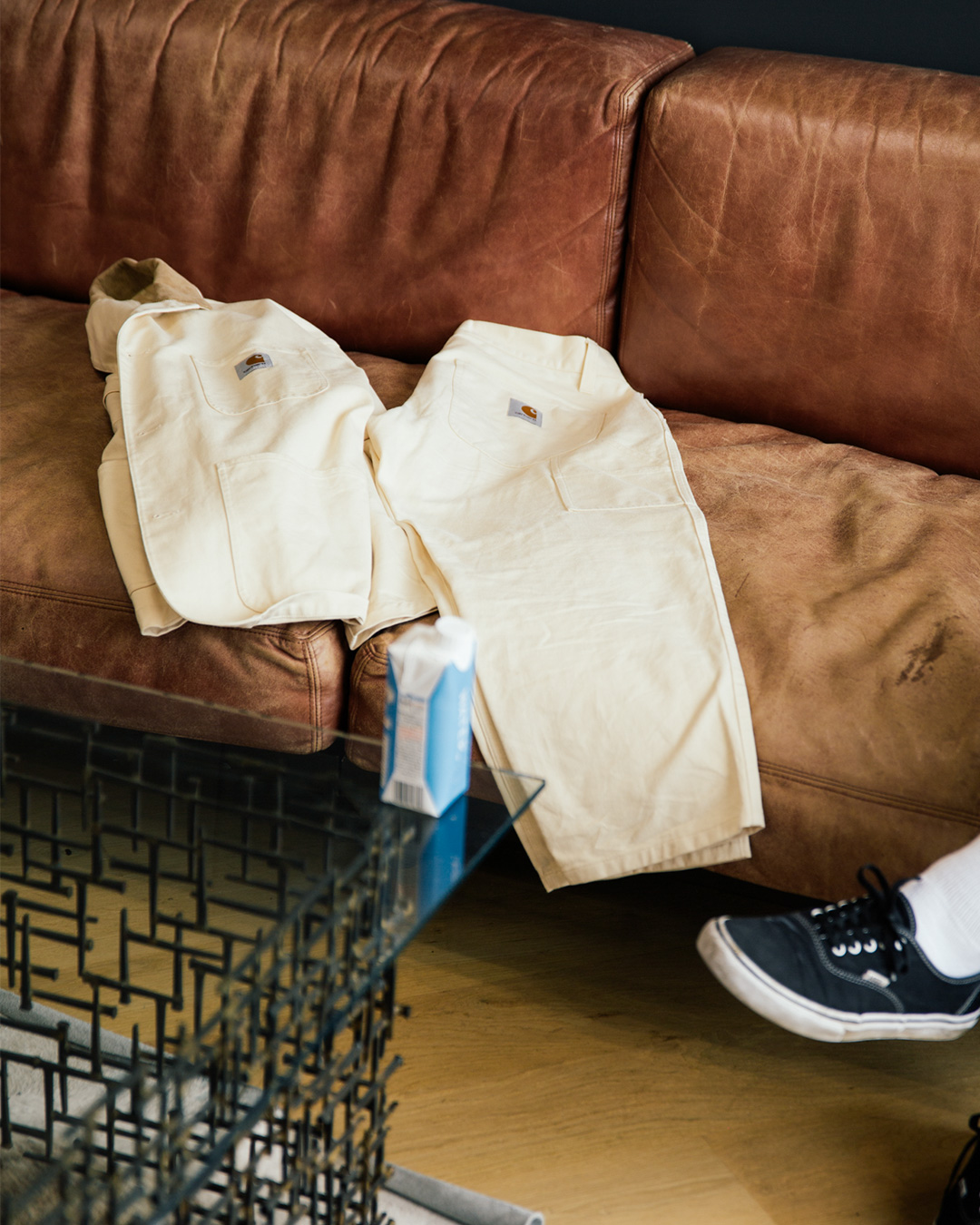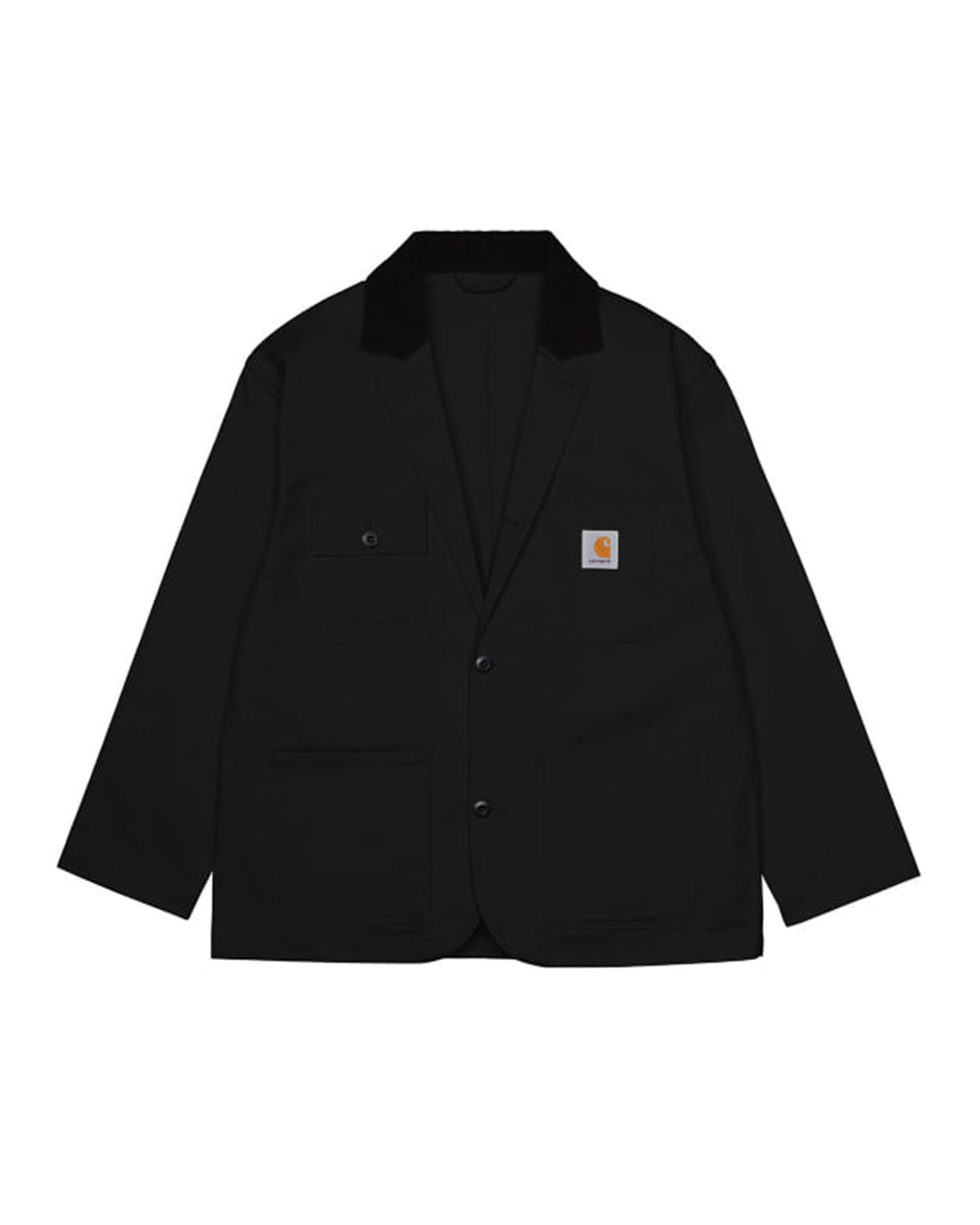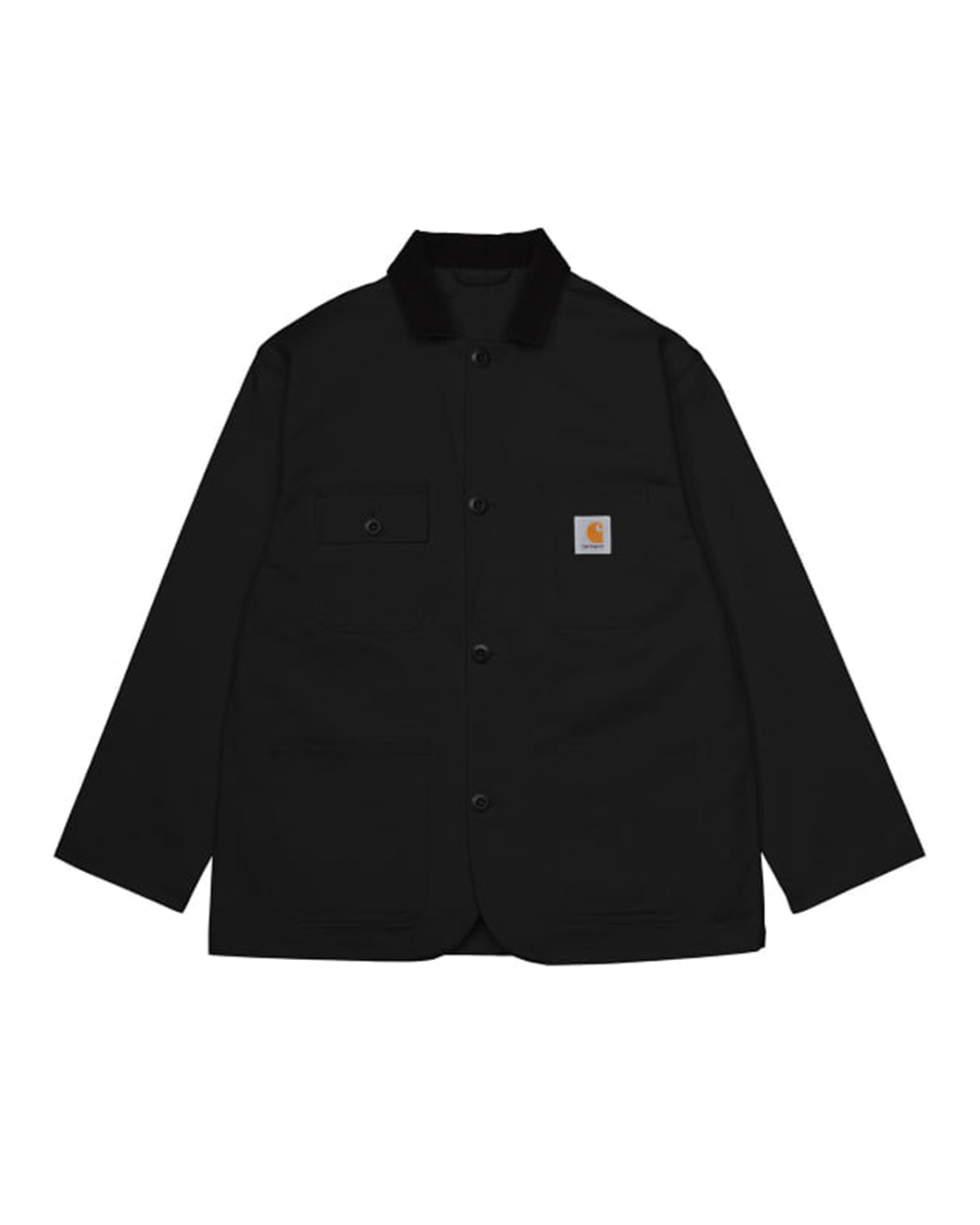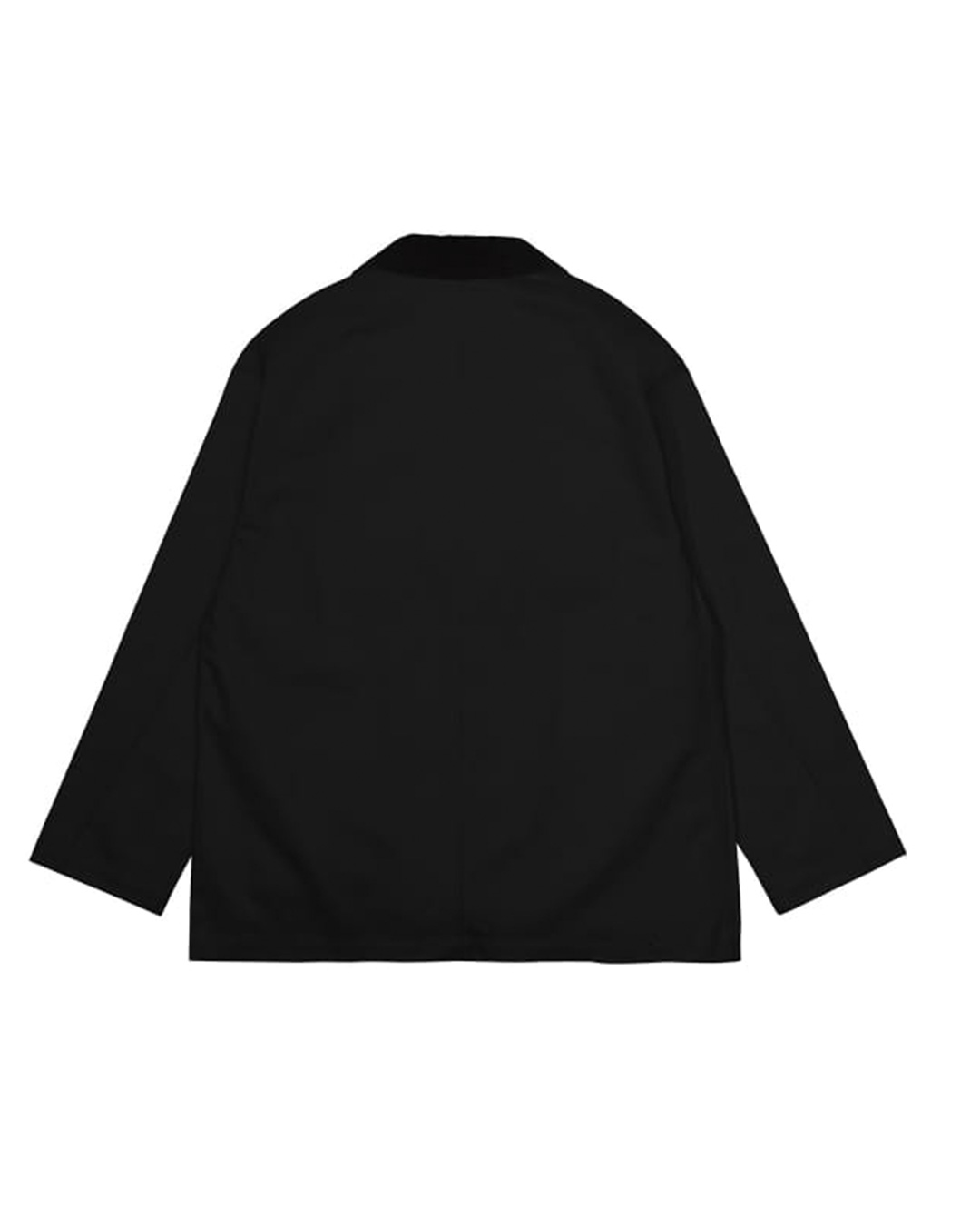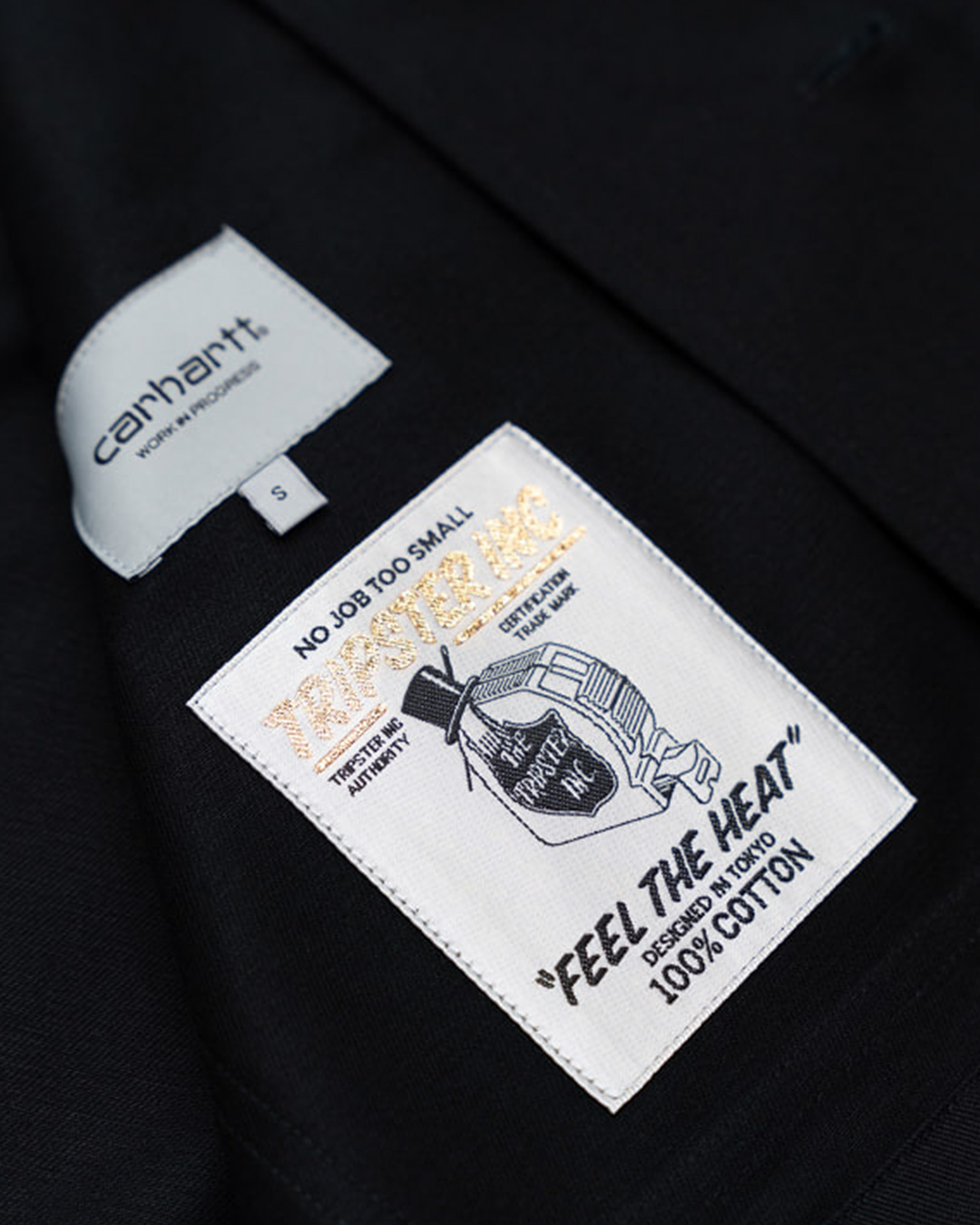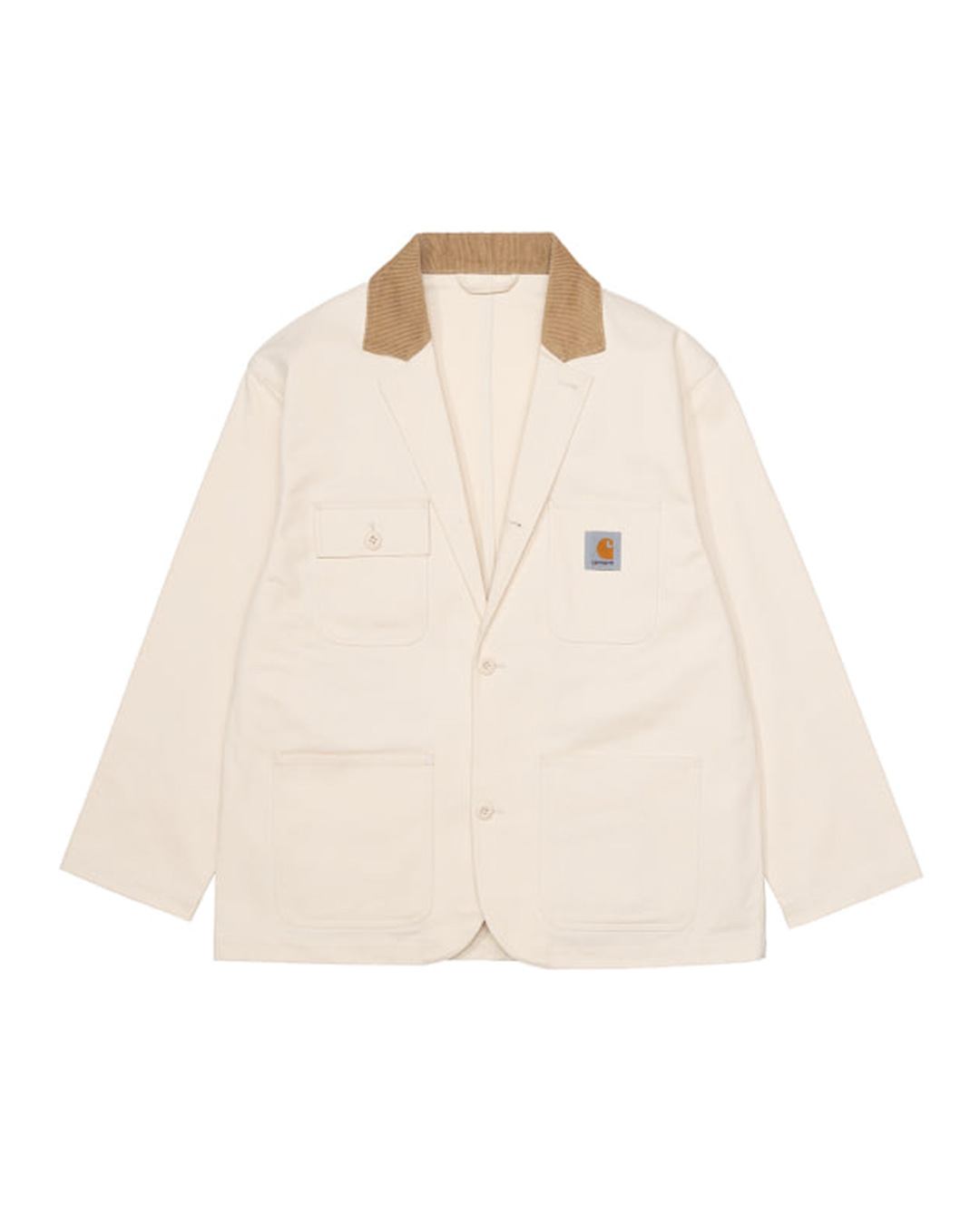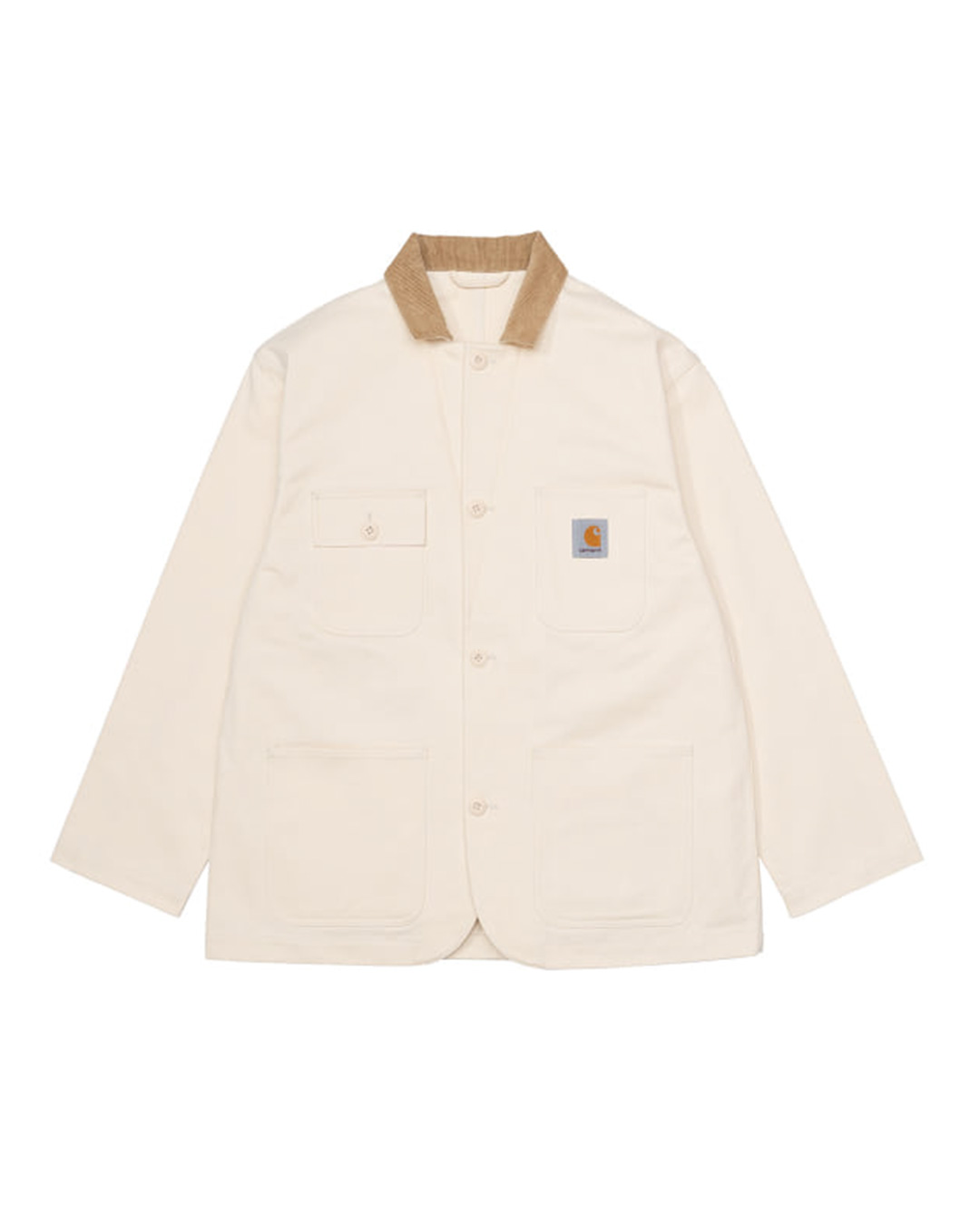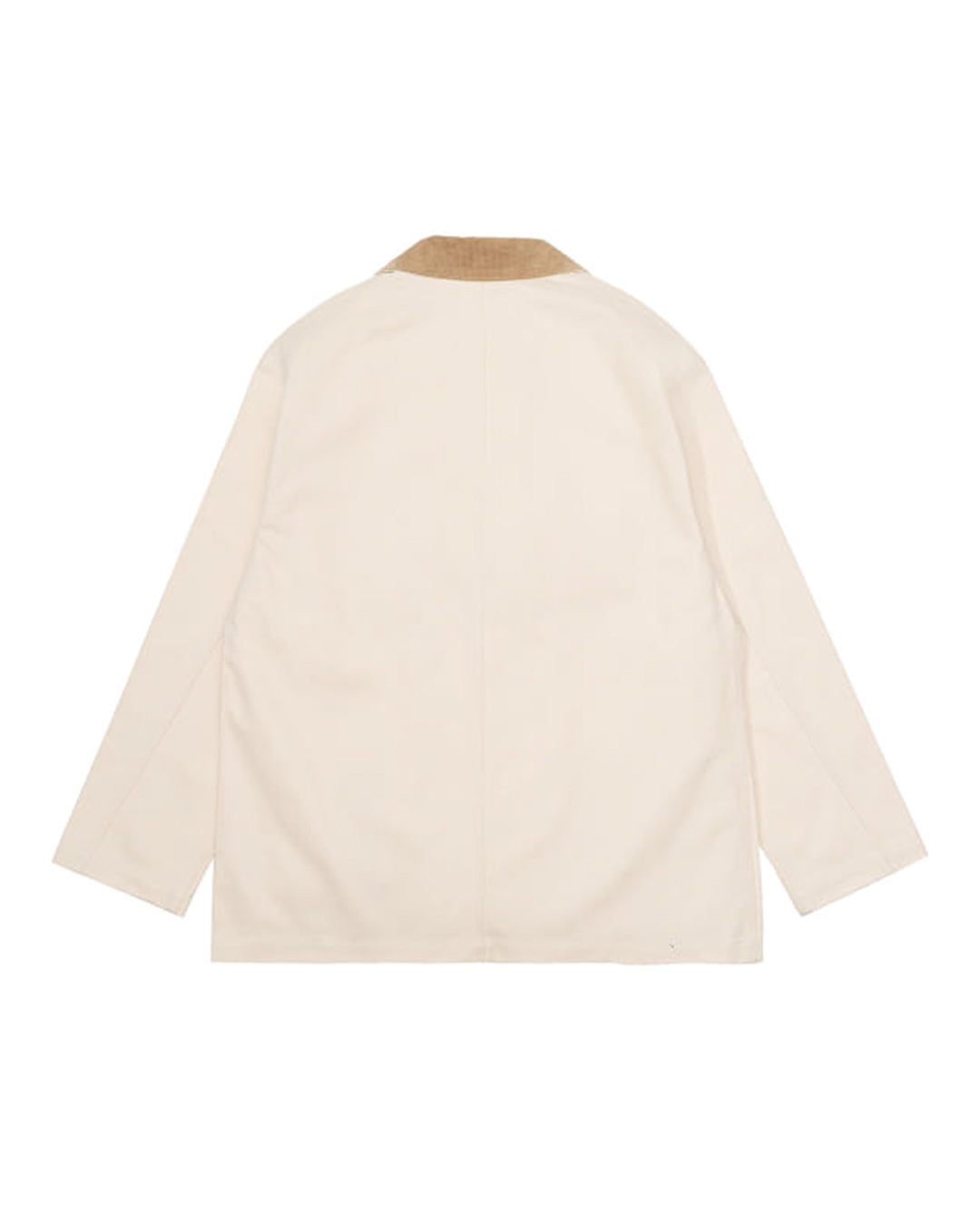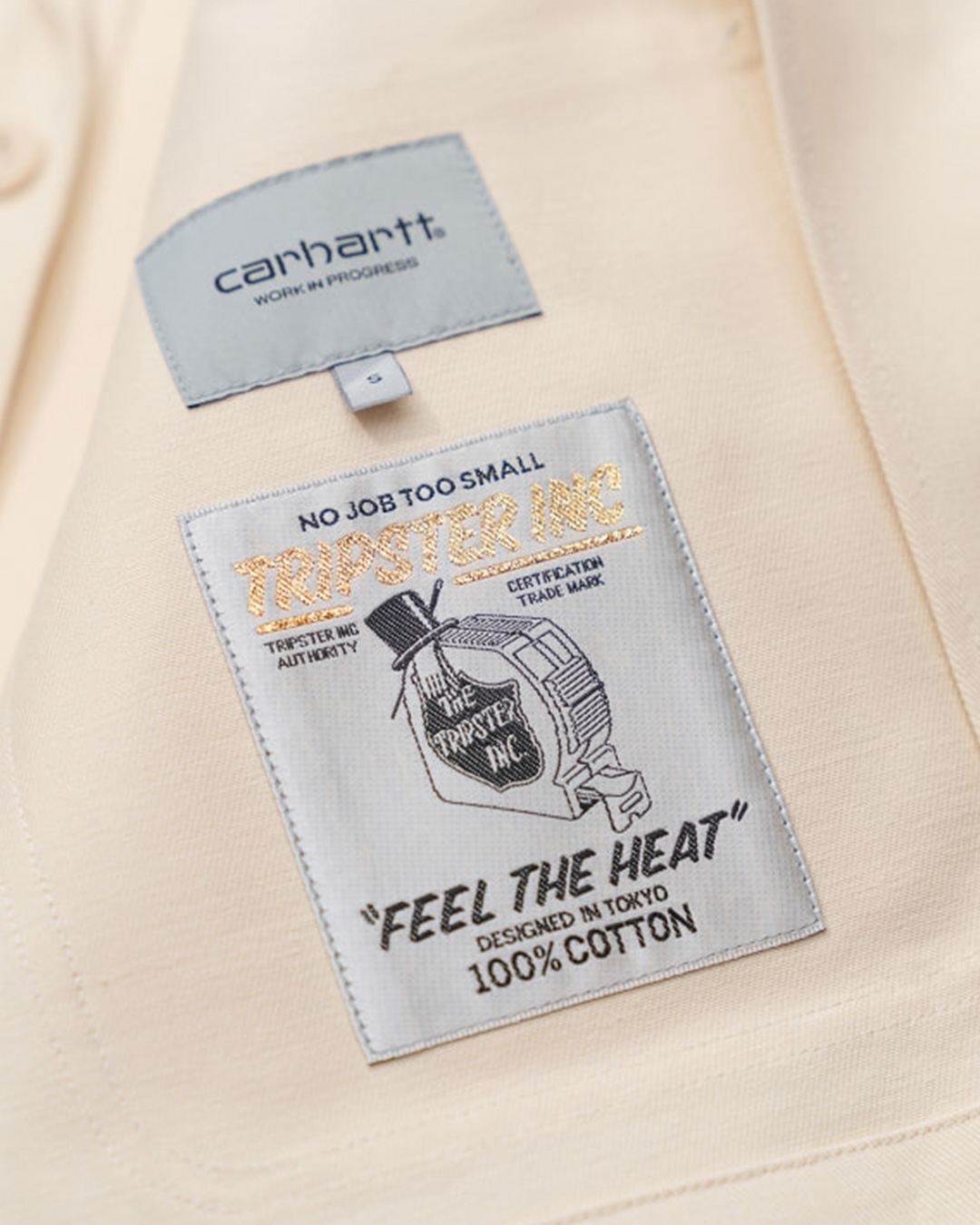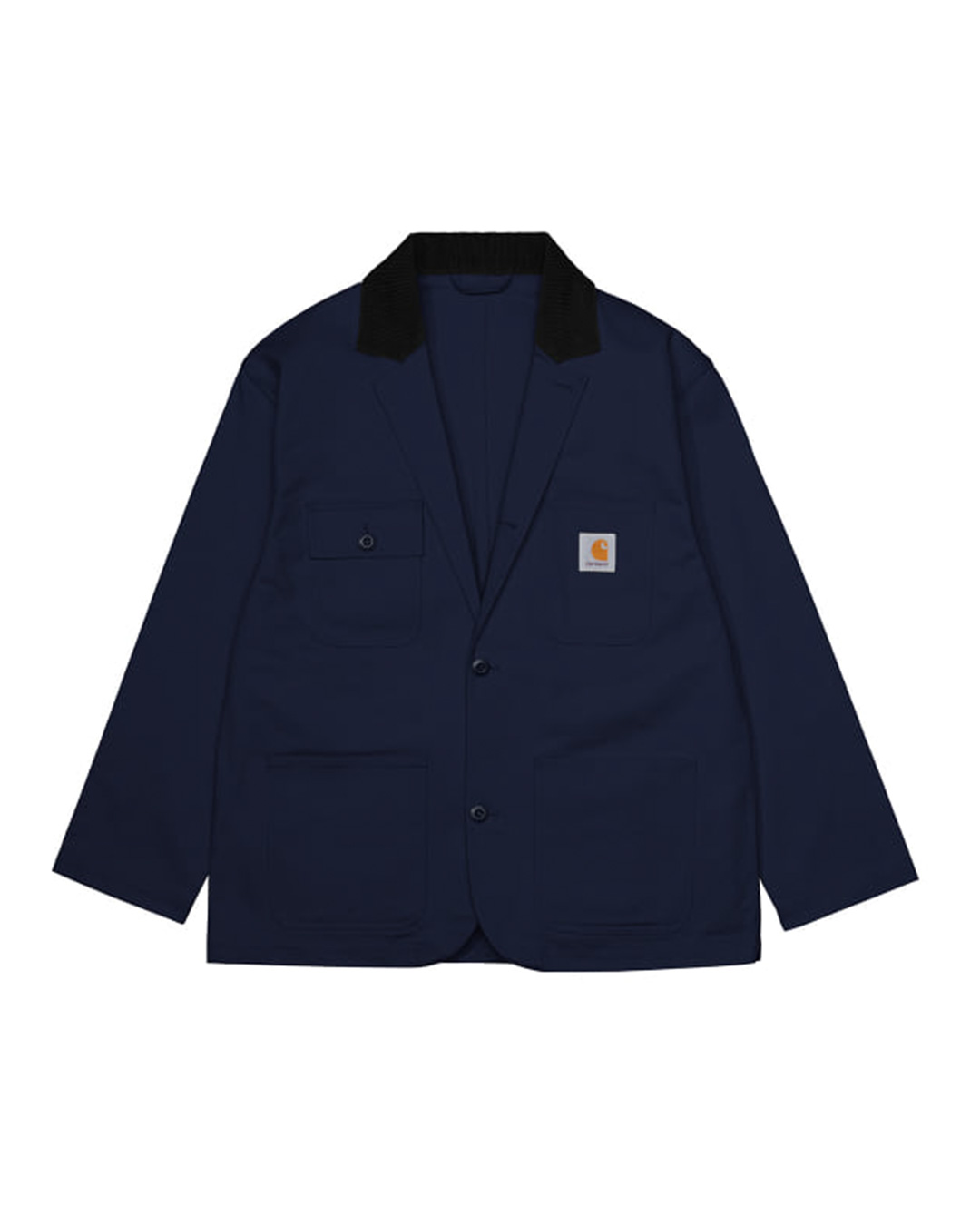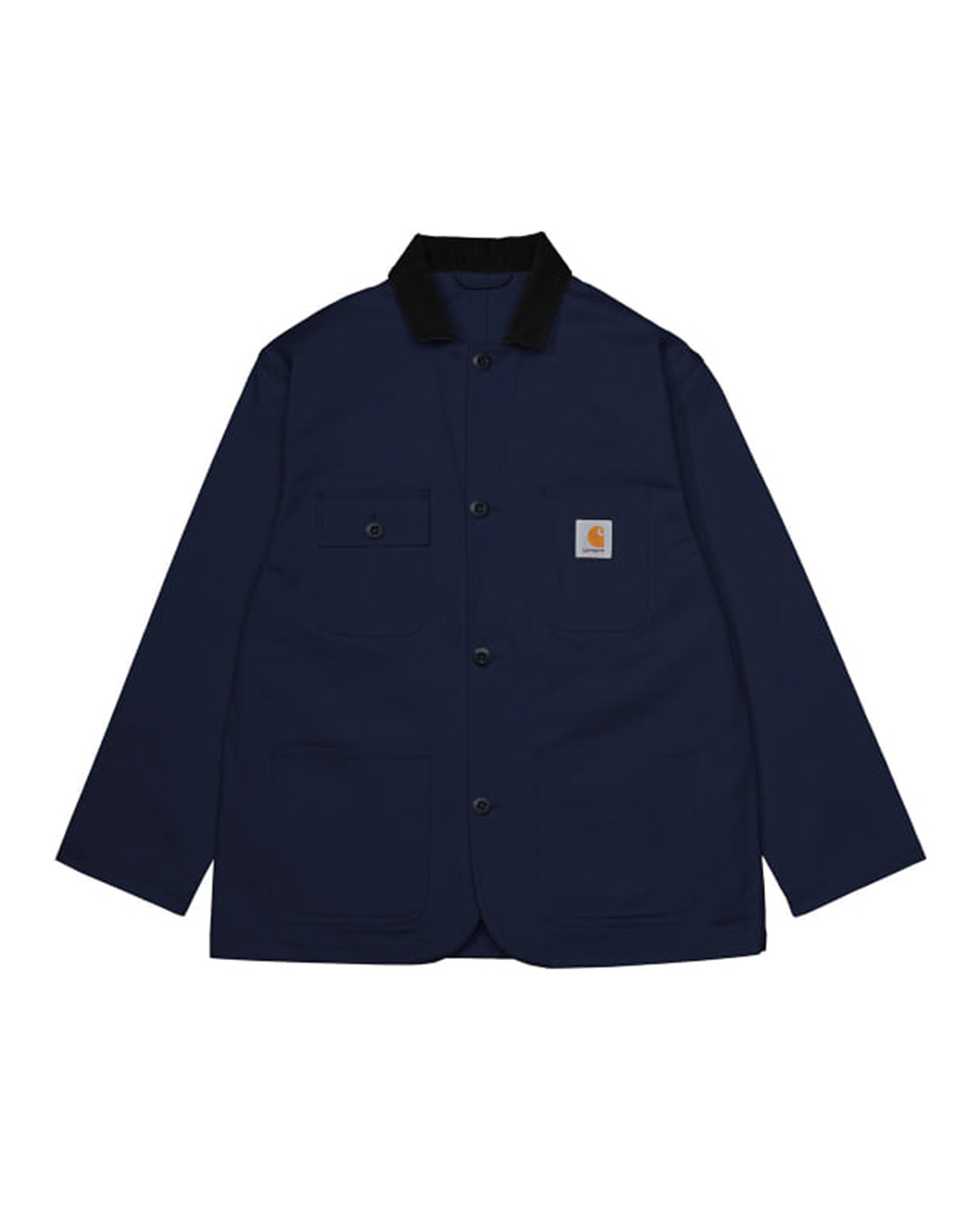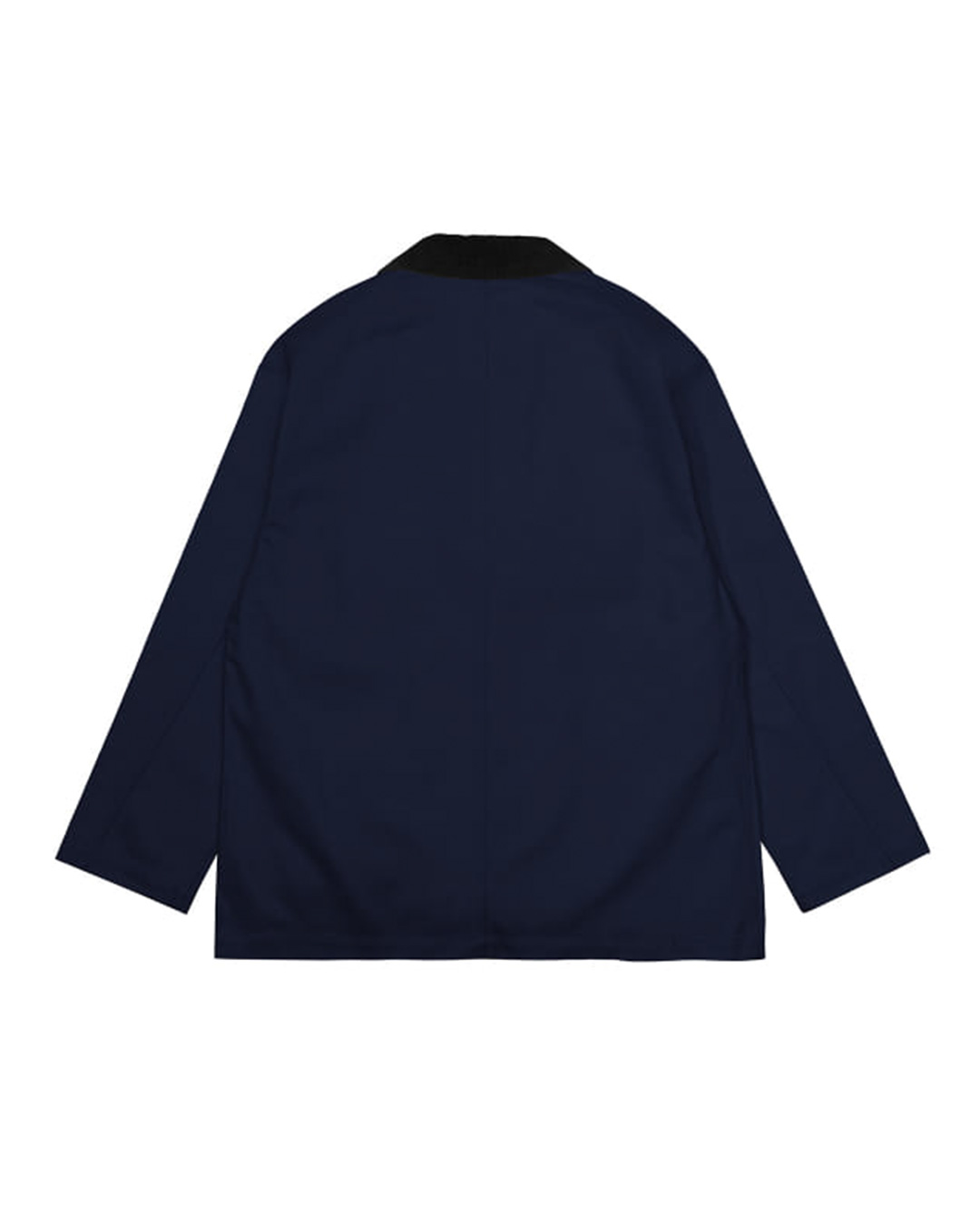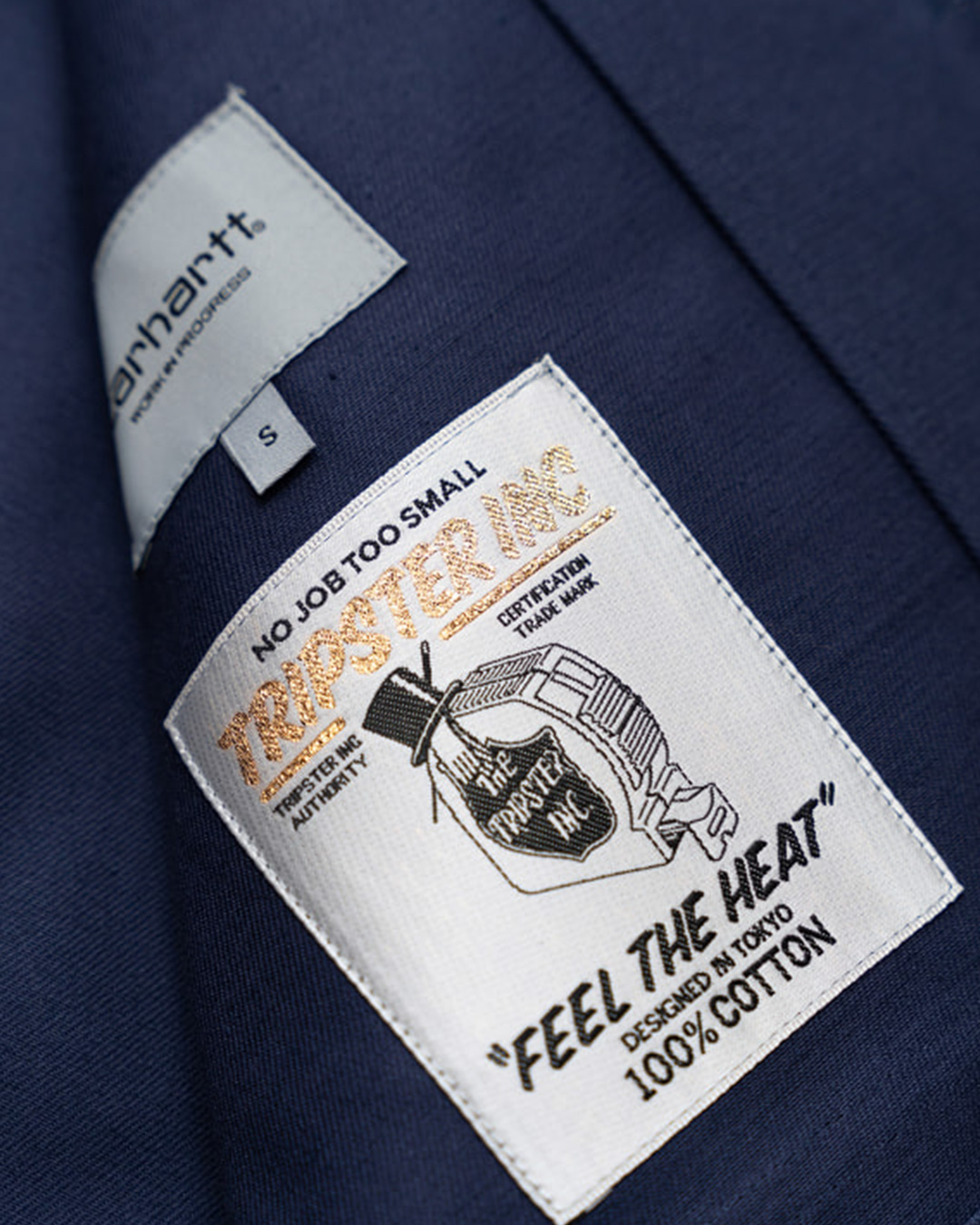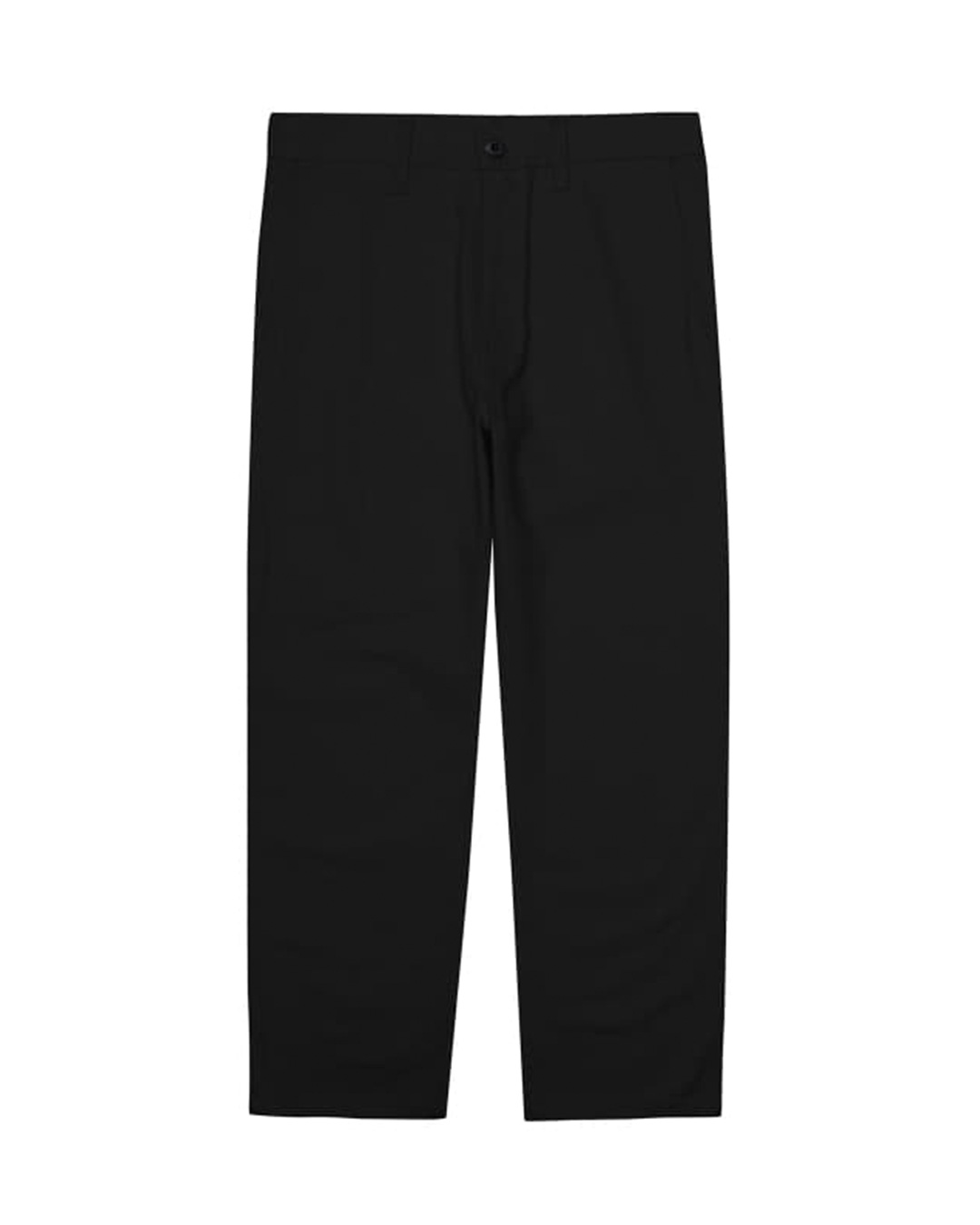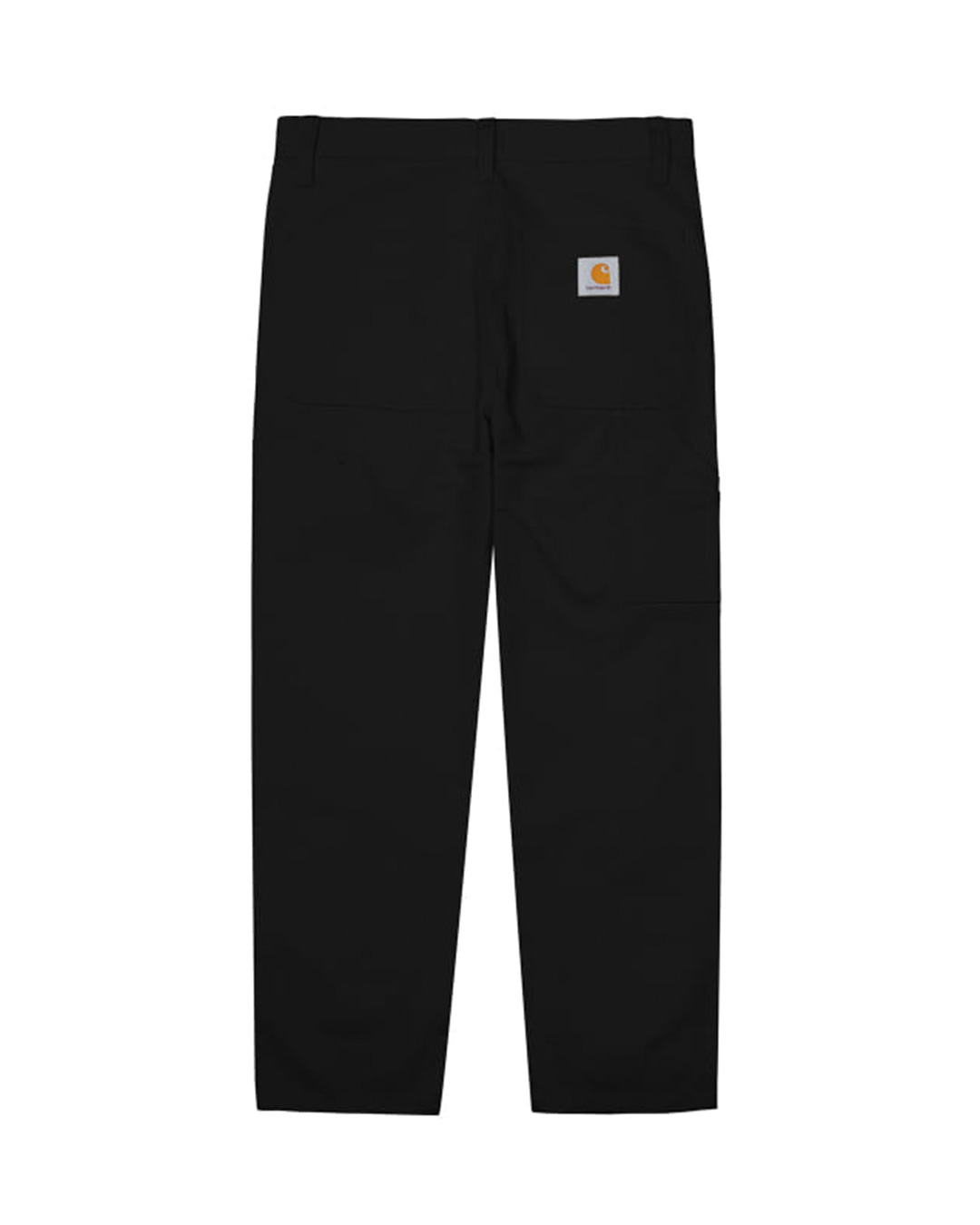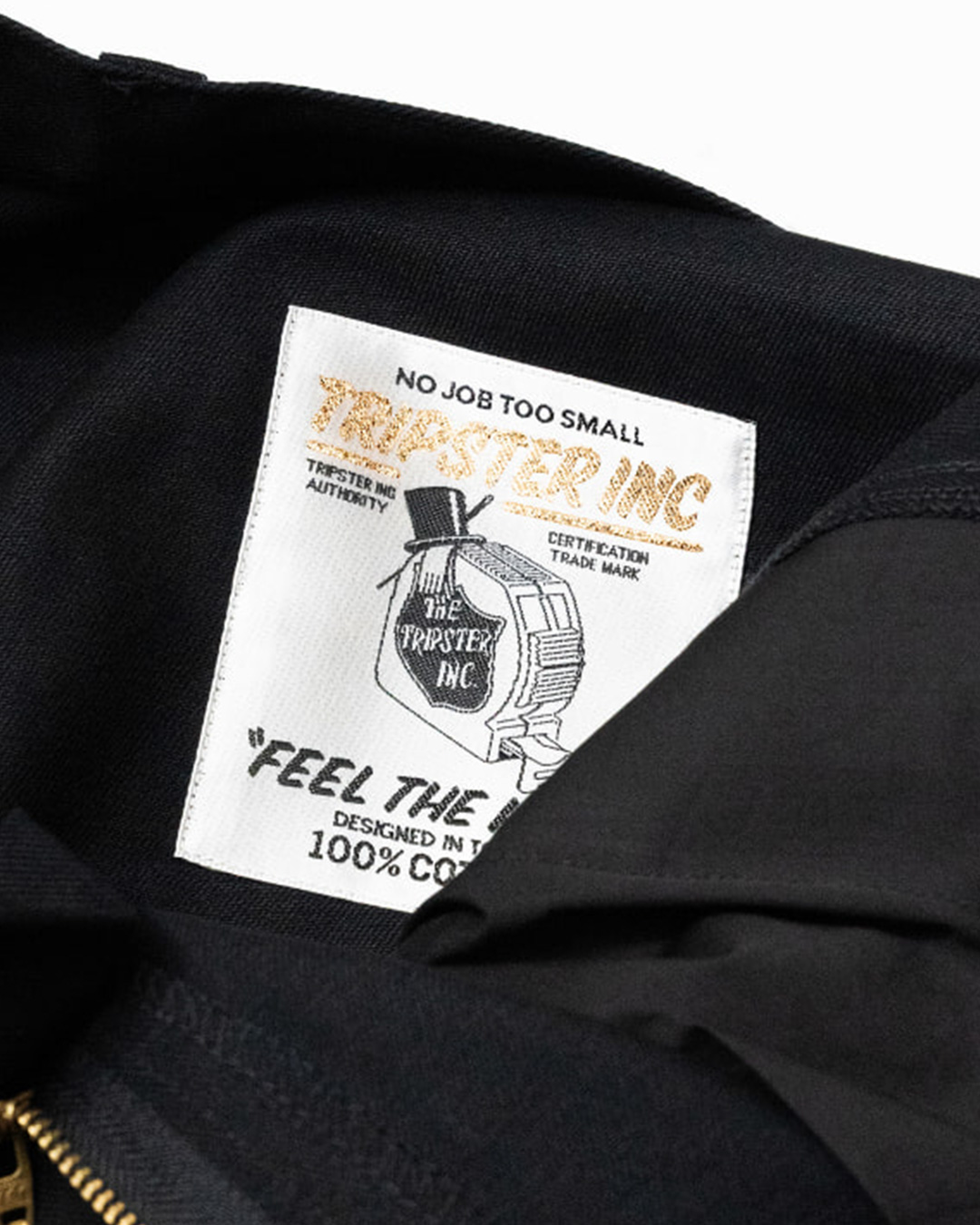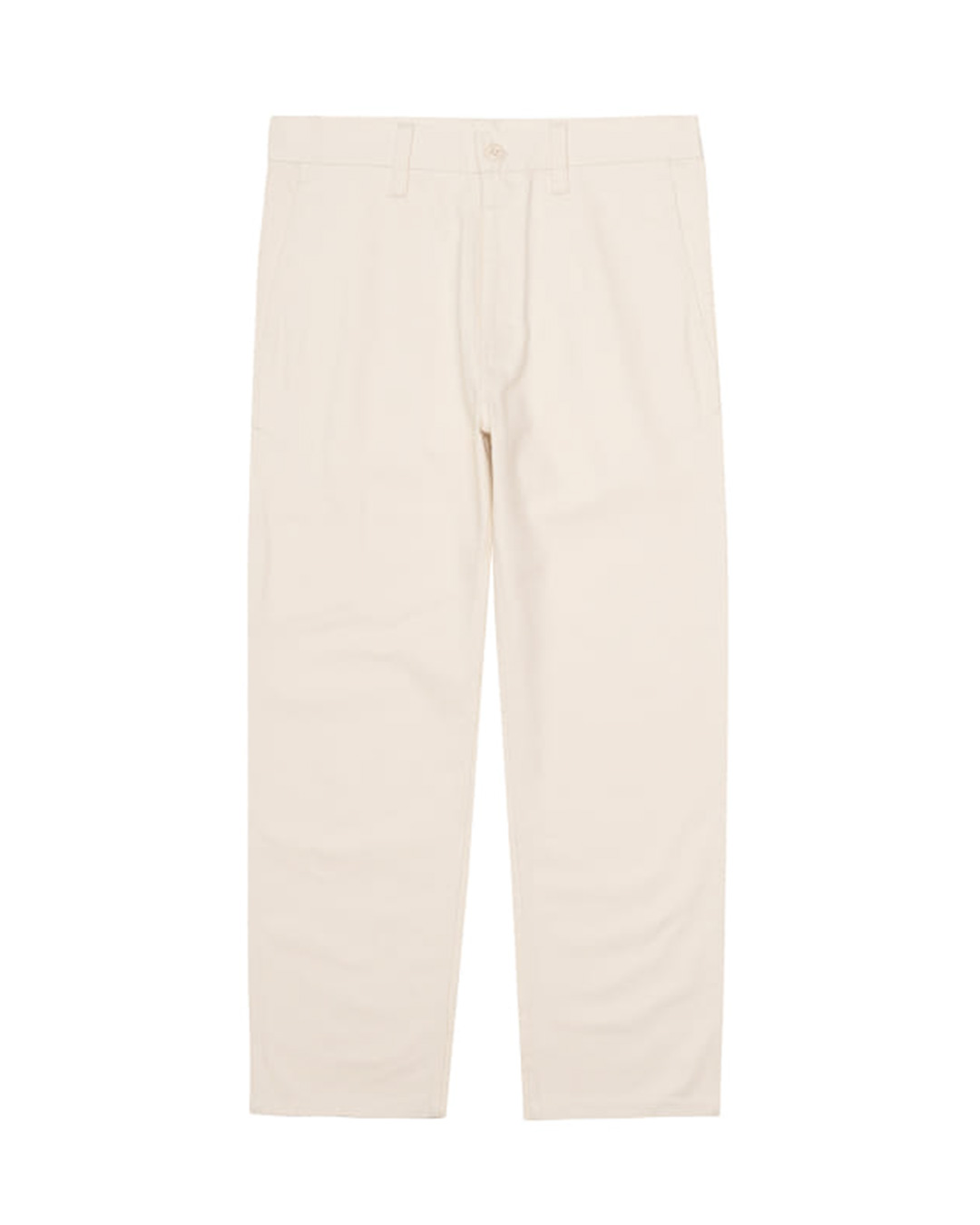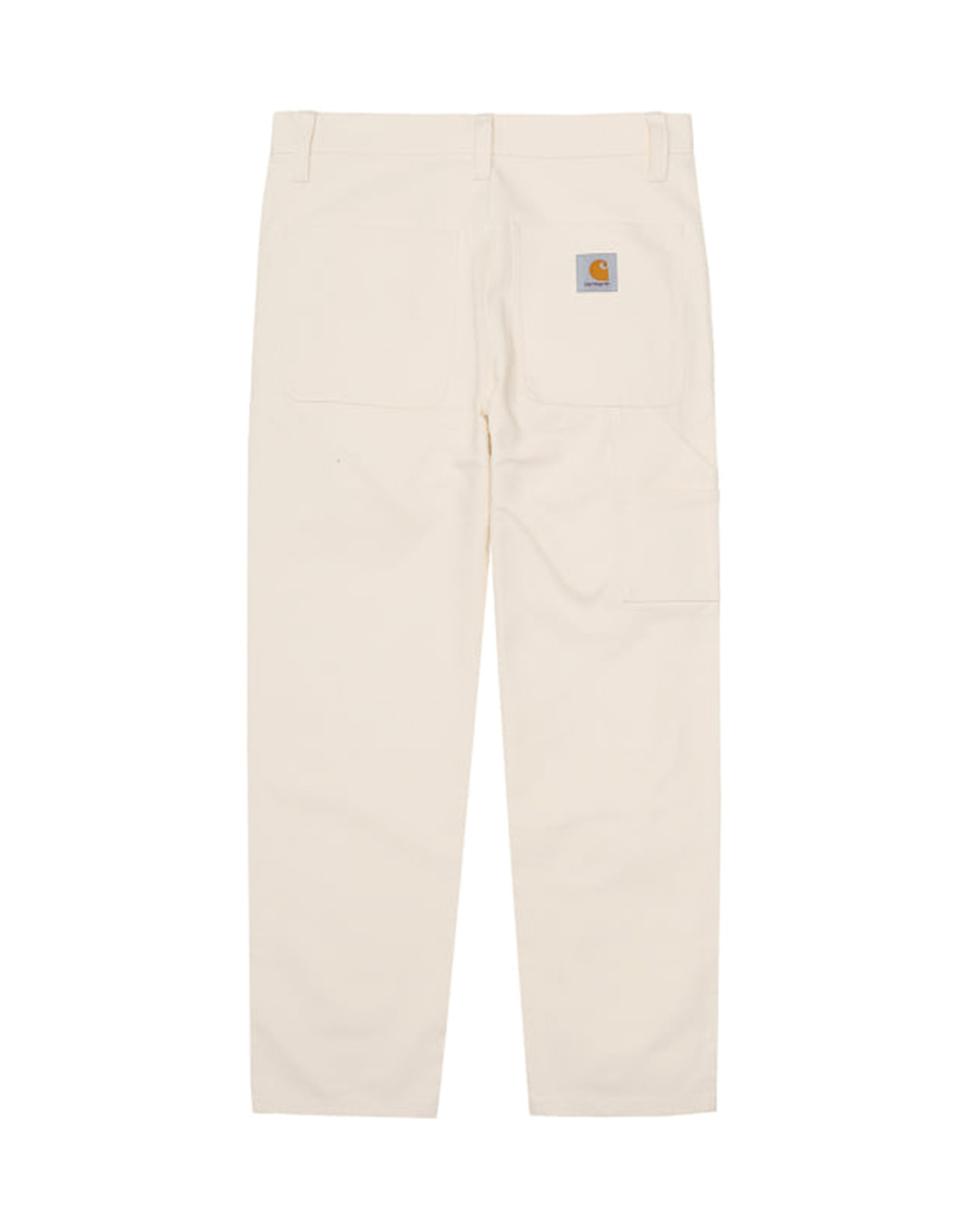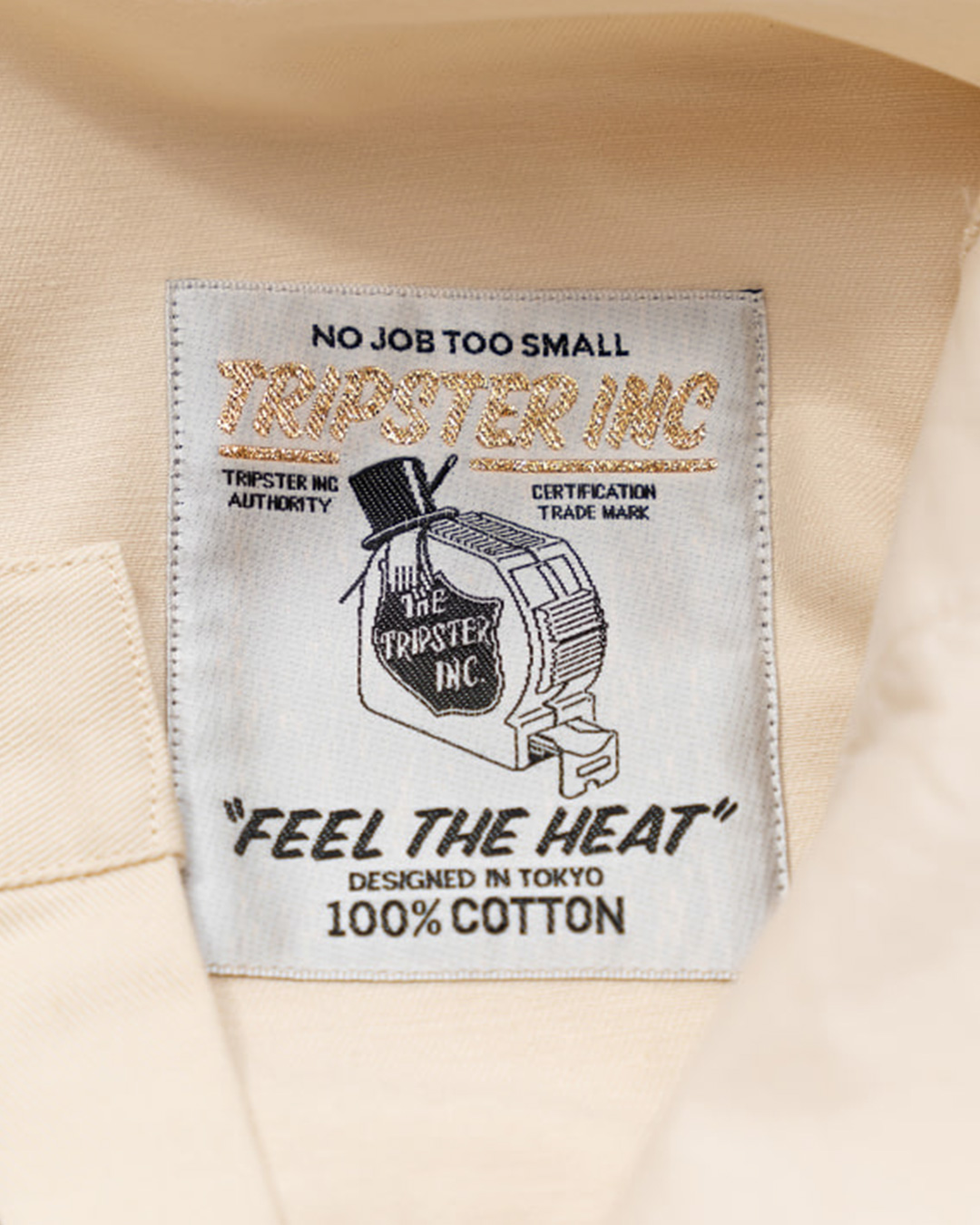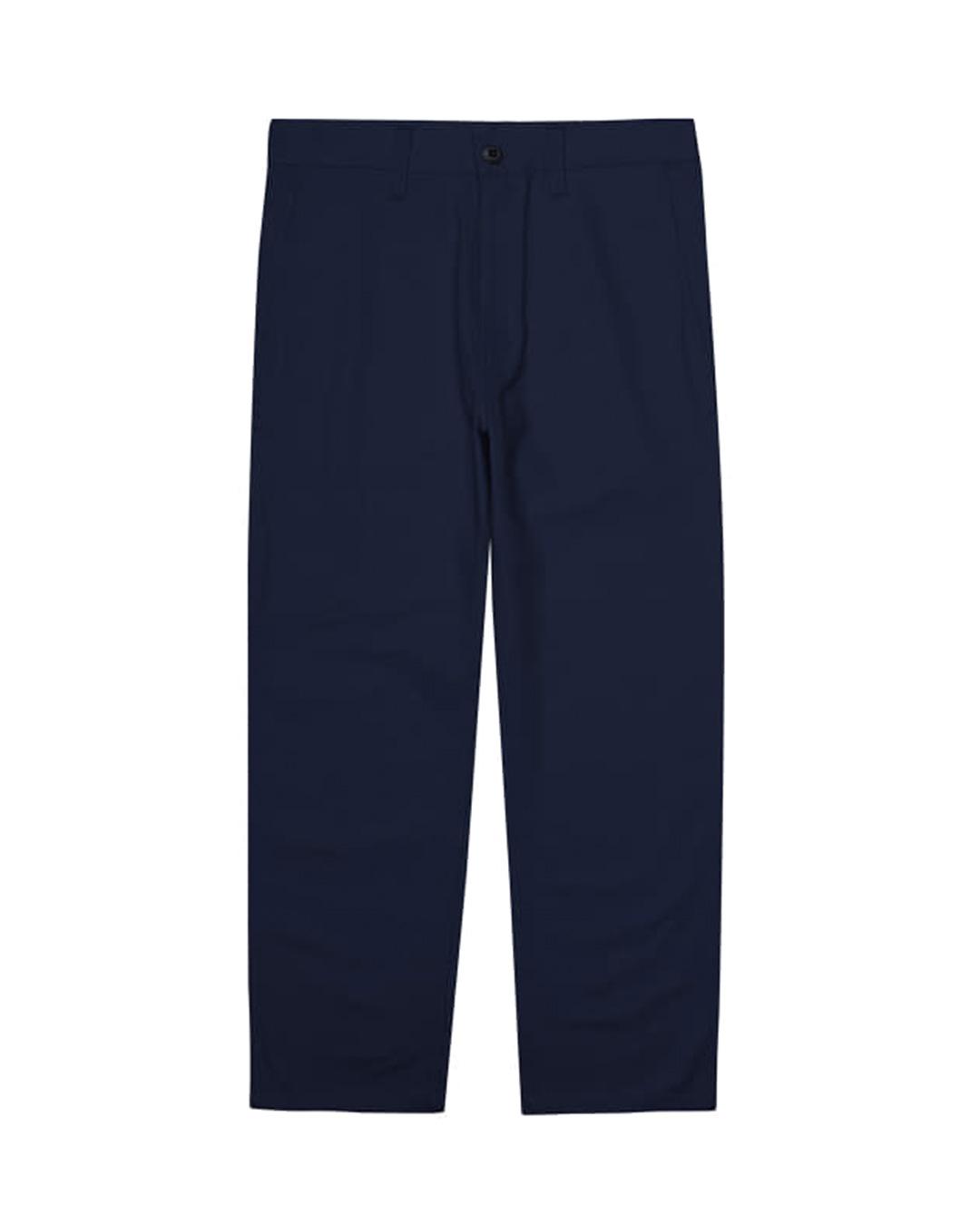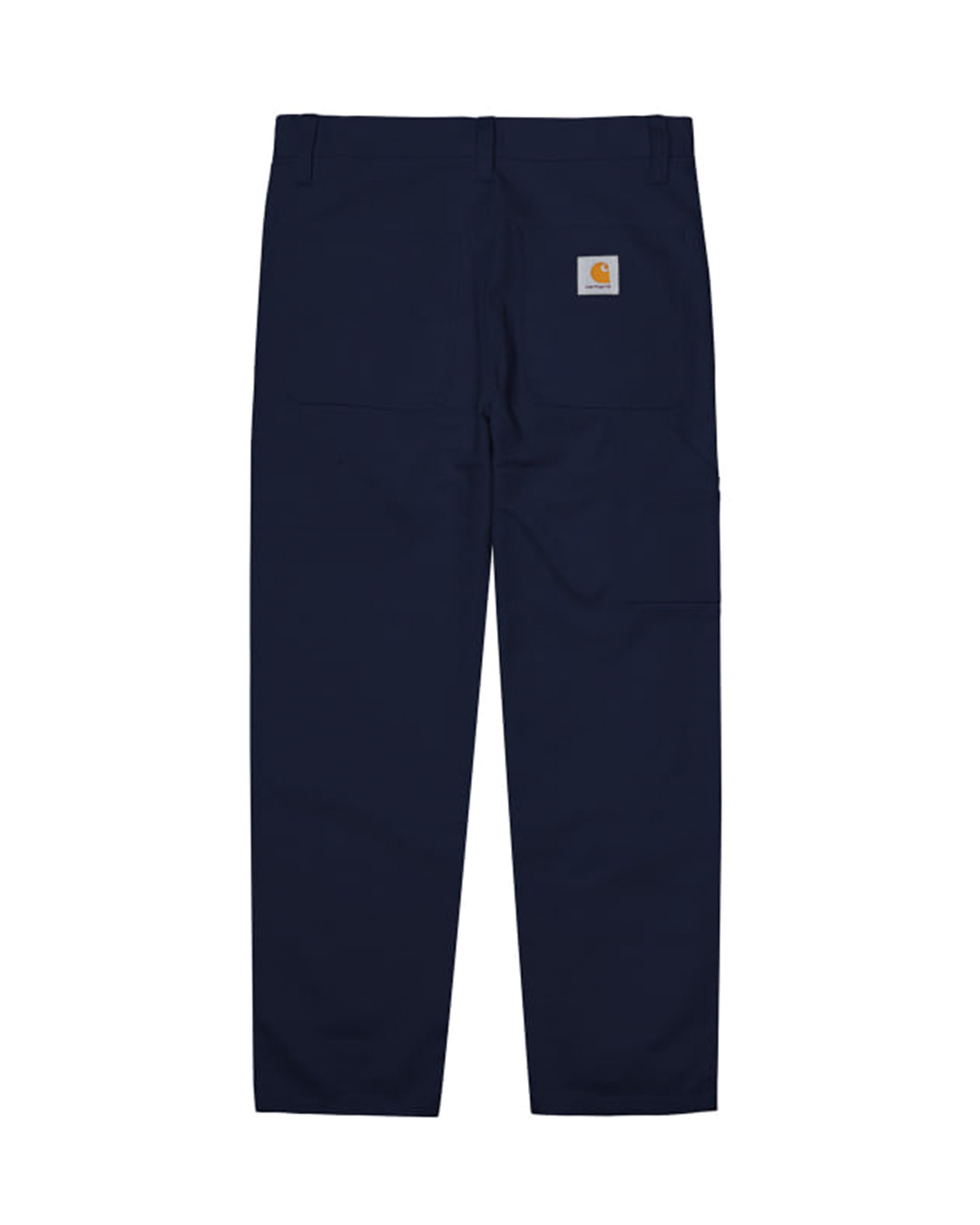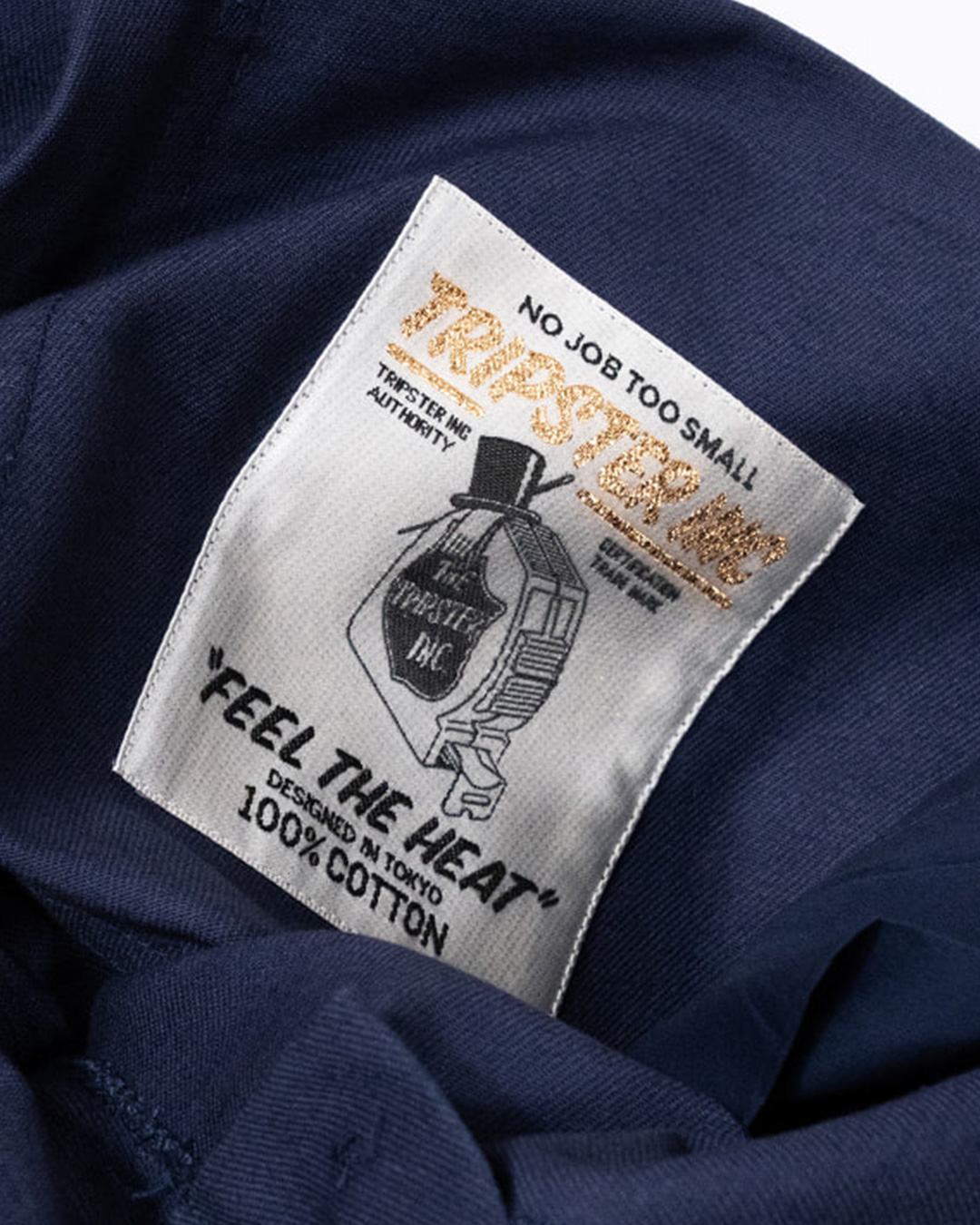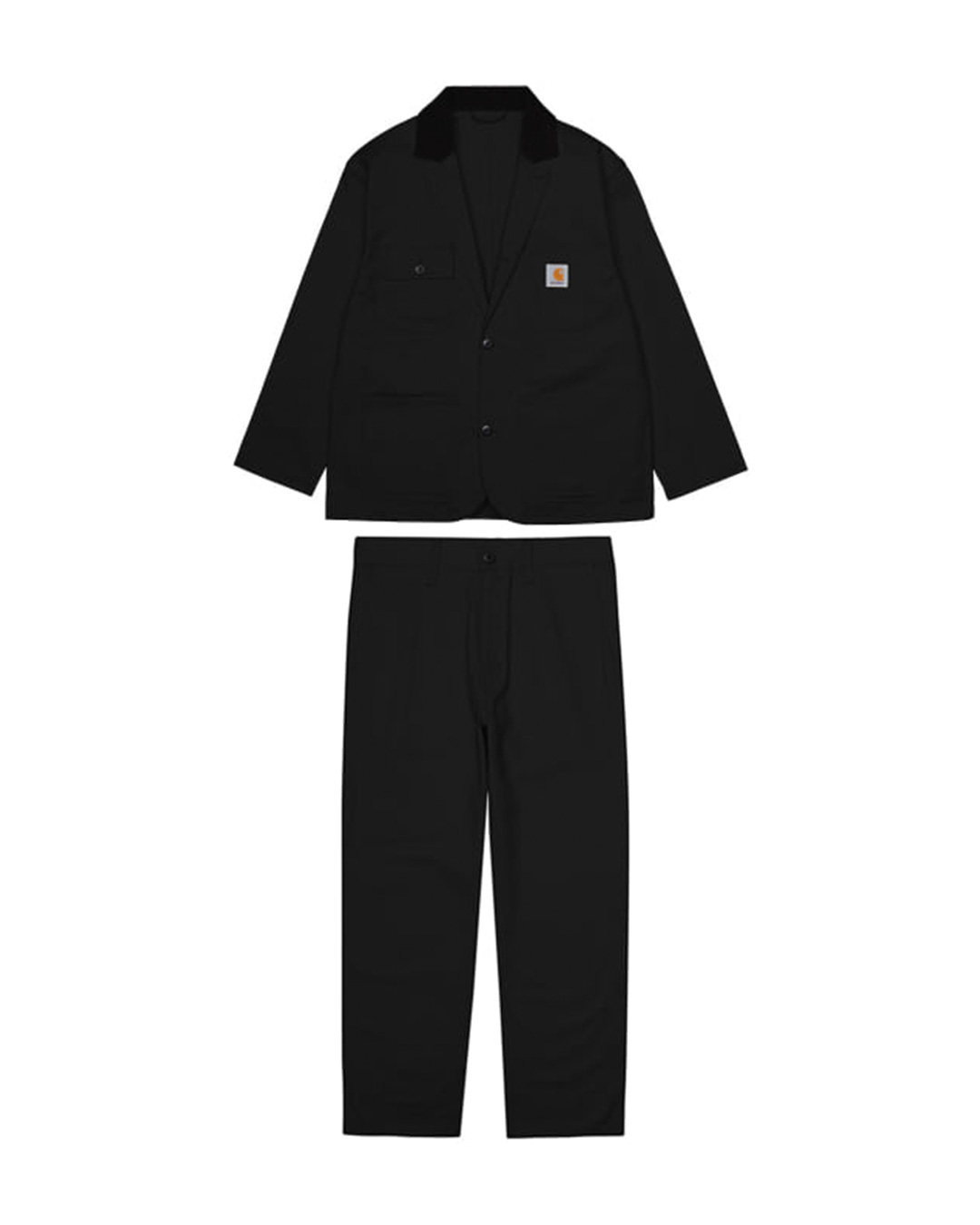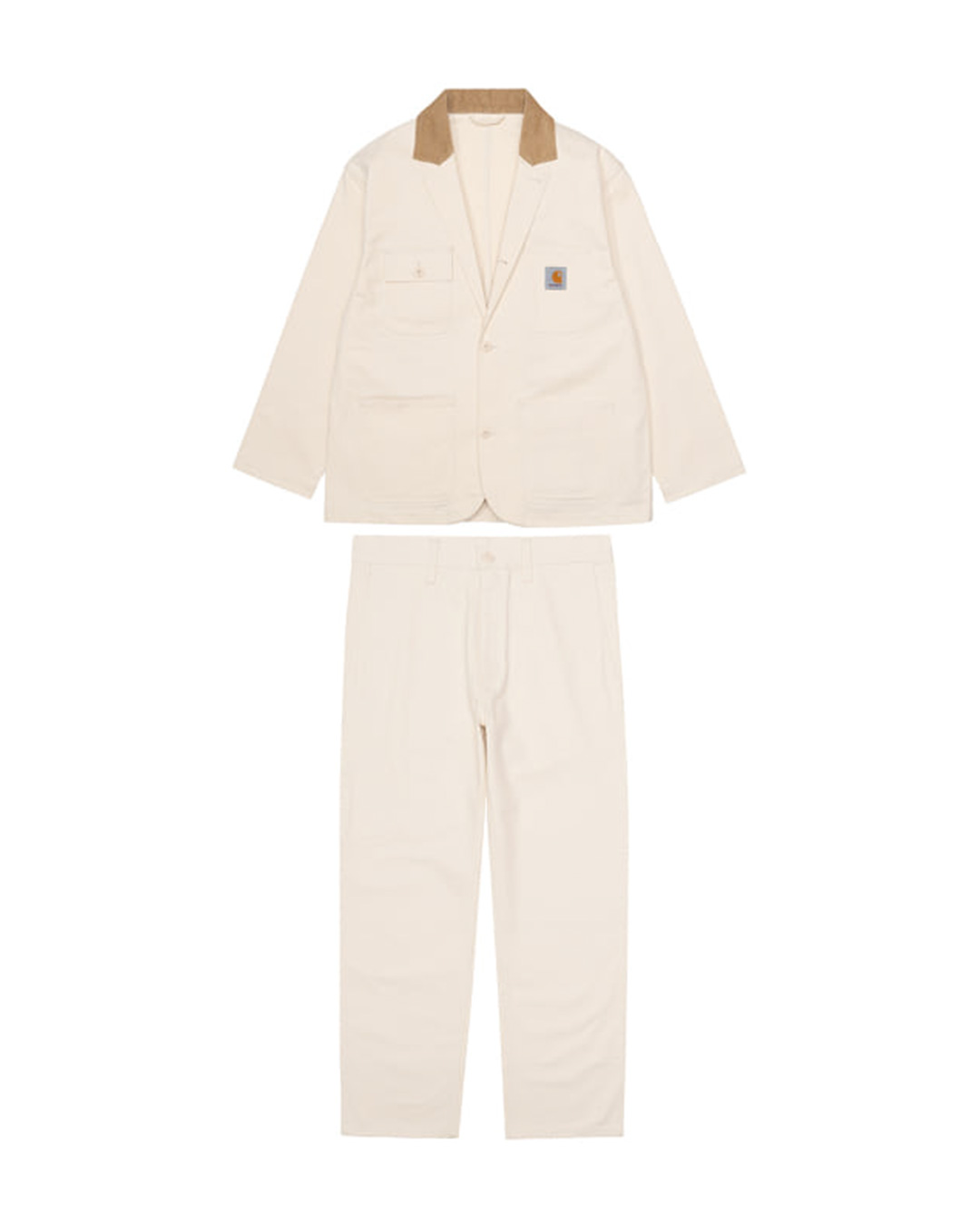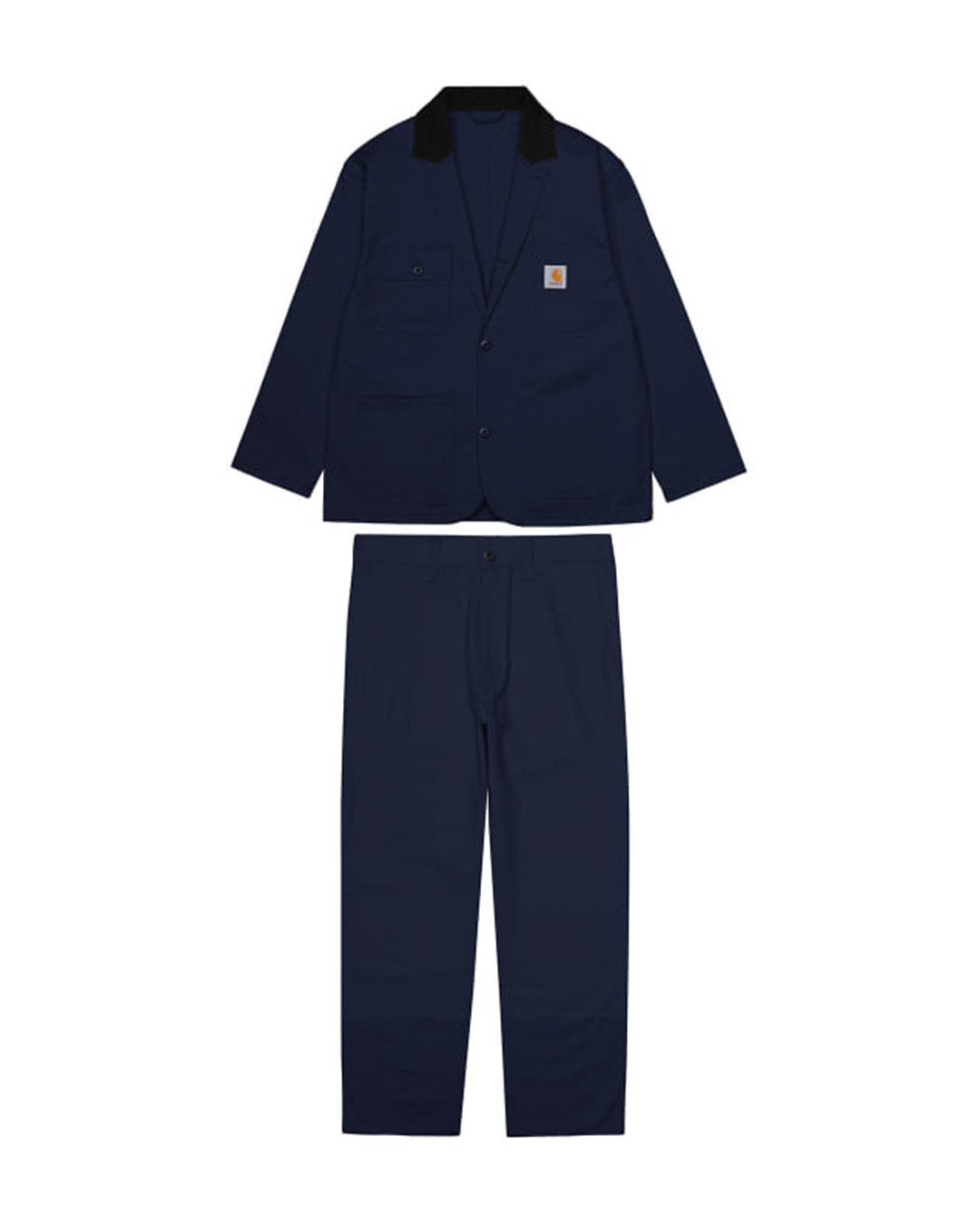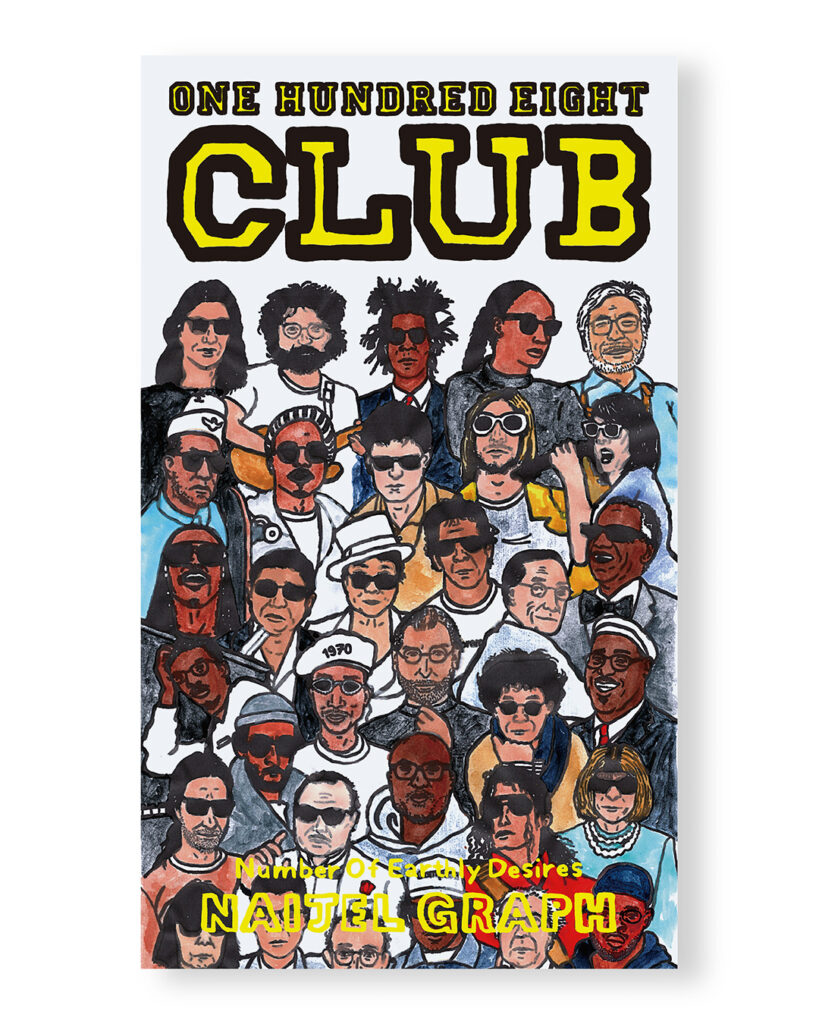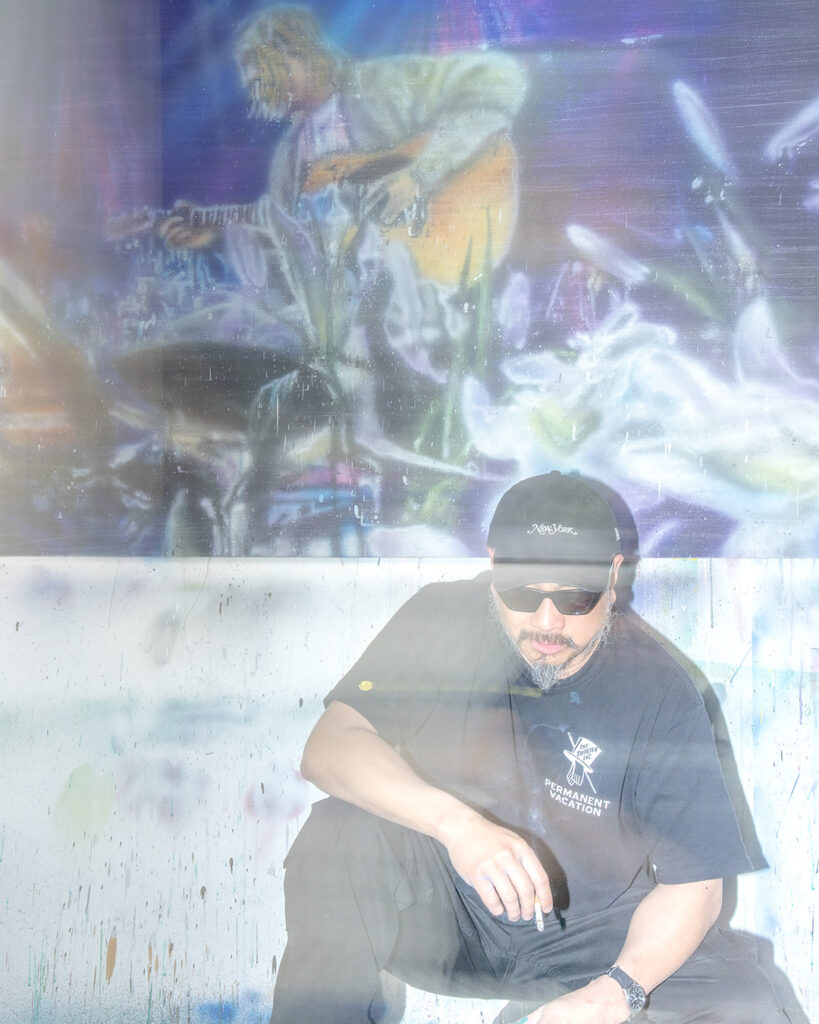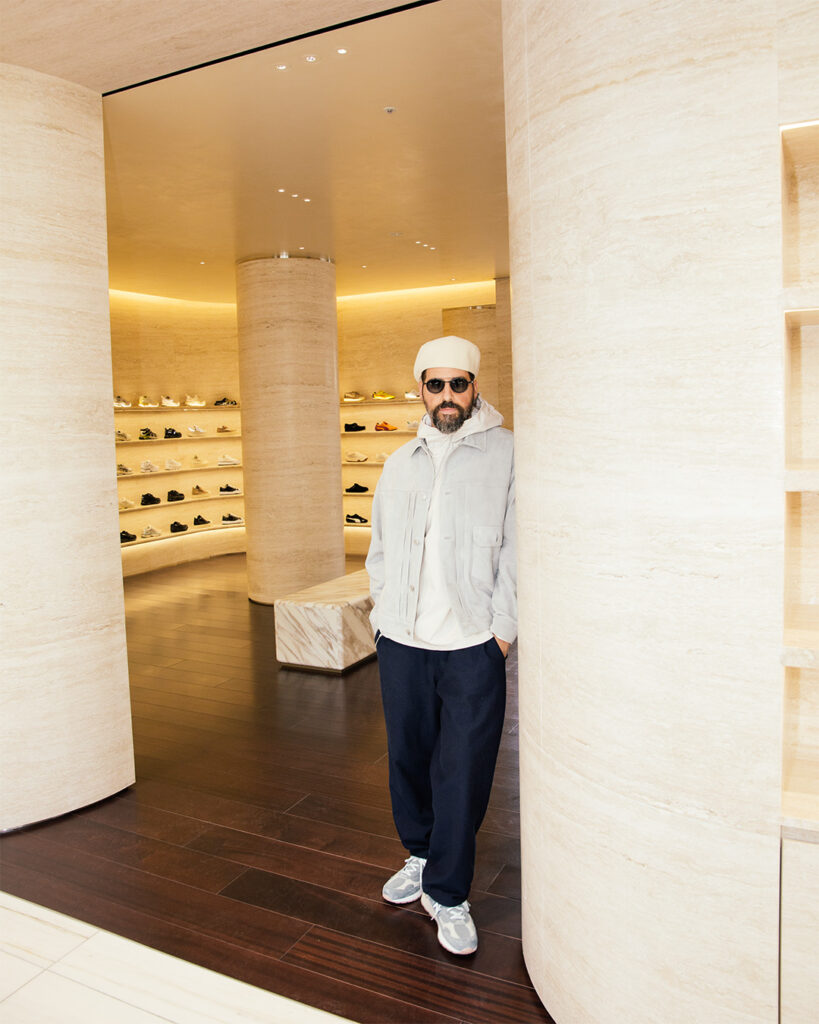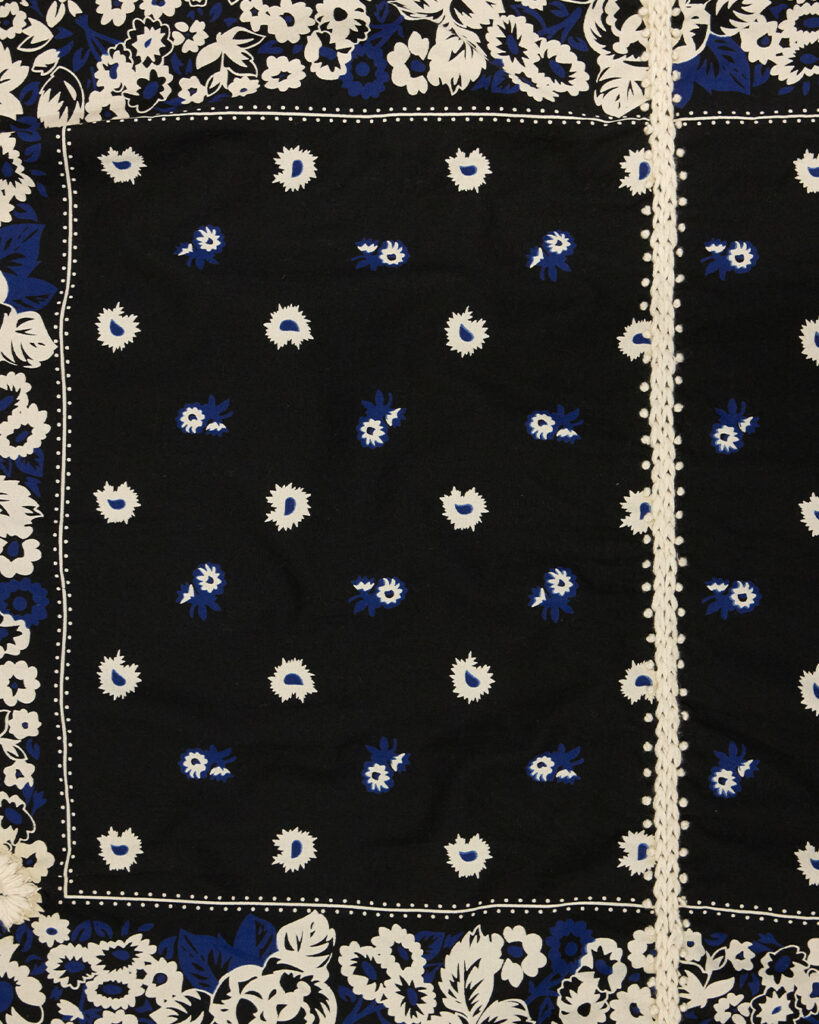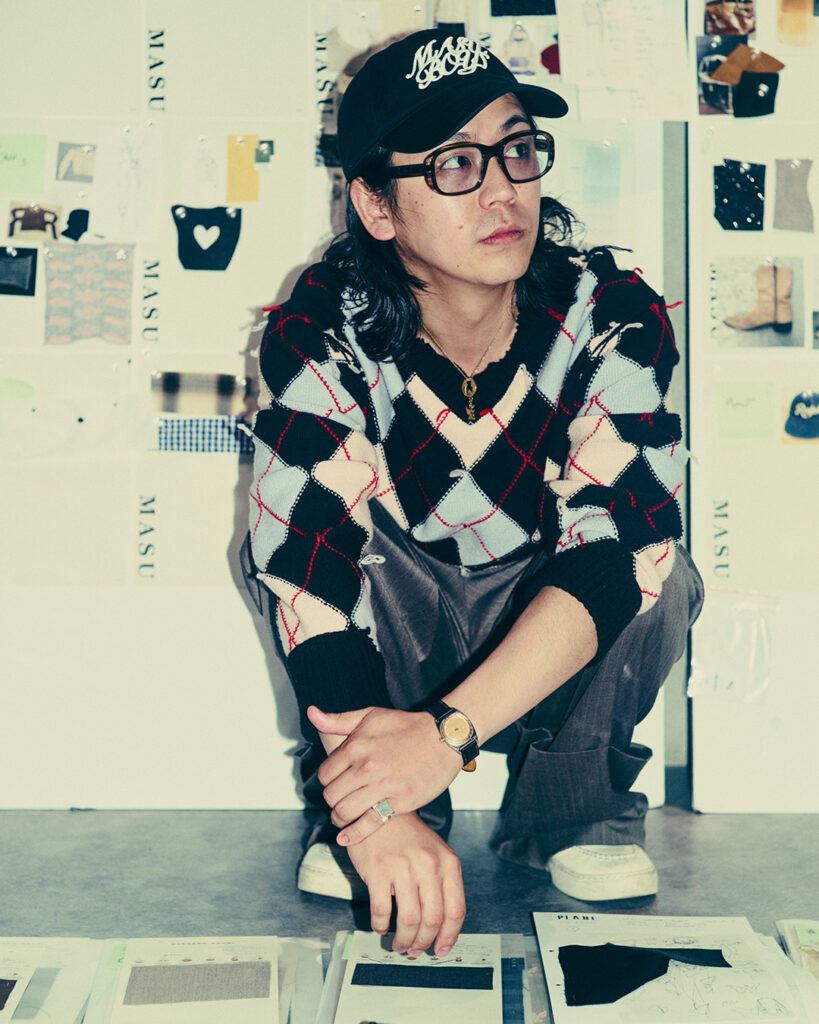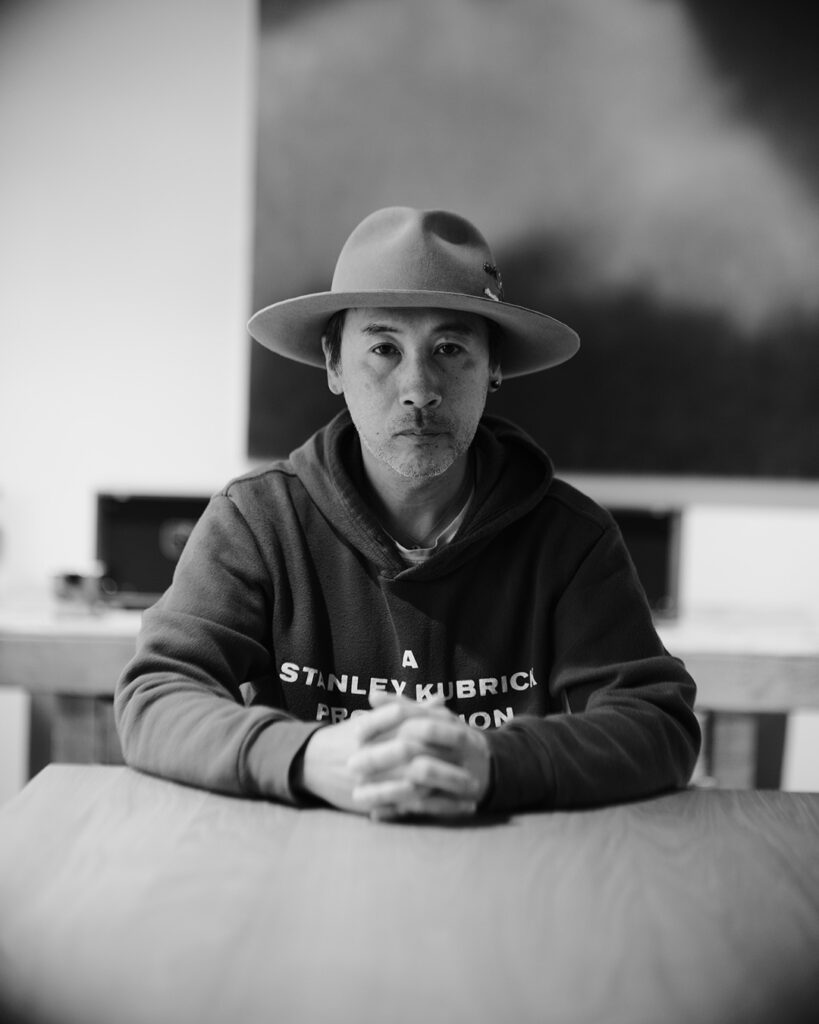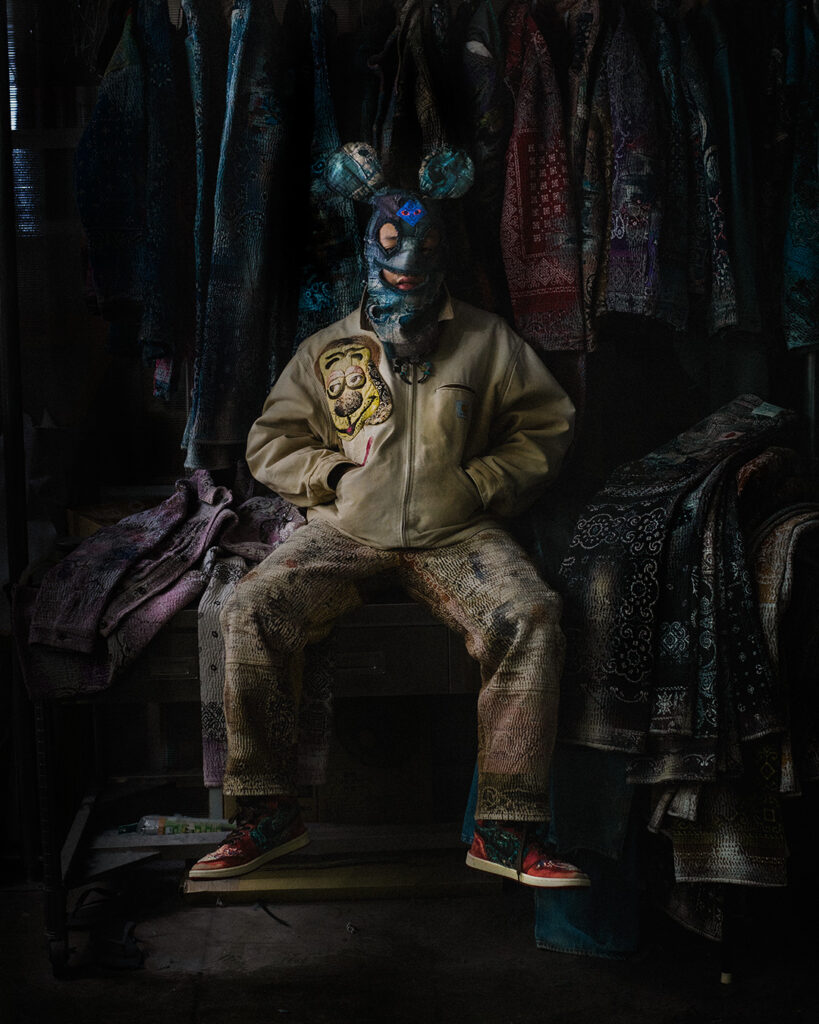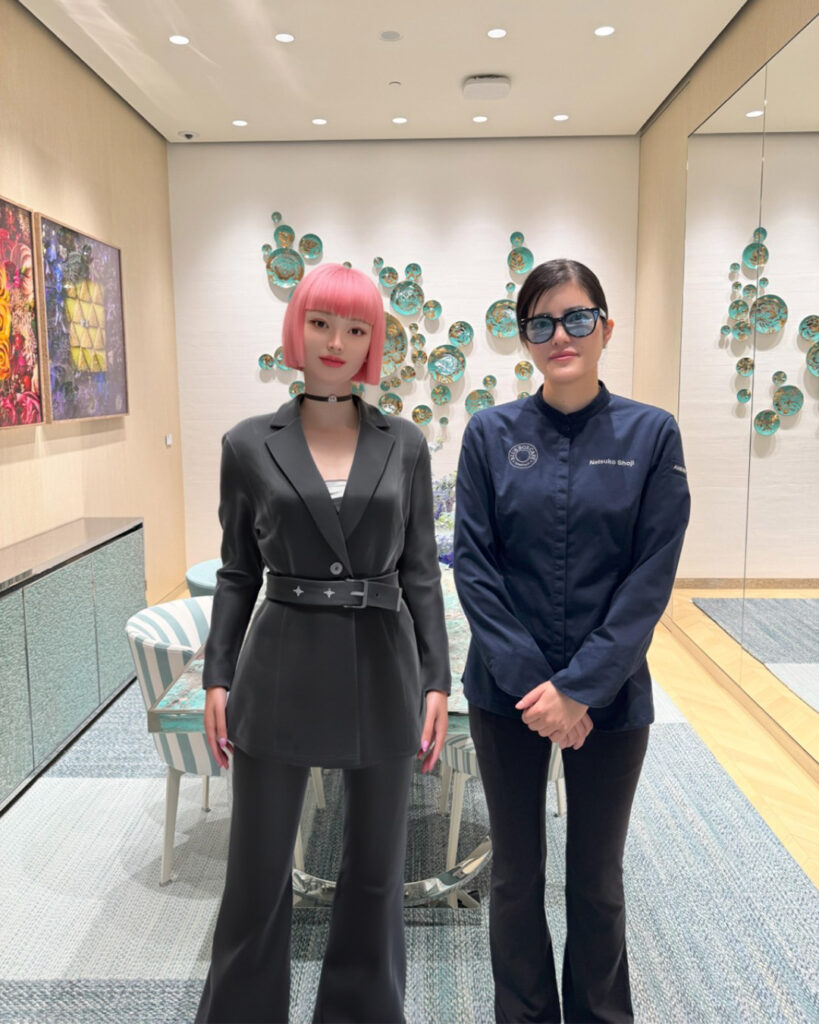You suddenly need a suit—but you have no idea what to buy. You almost never wear one, so spending a lot feels like overkill. But if you’re going to buy one, wouldn’t it be better if you could wear it casually, too? If that inner conflict sounds familiar, you’re not alone. For countless “lost boys of Japanese street culture,” salvation came in the form of Dickies suits reimagined by Tripster—the Tokyo-based design firm led by culture maven Kunichi Nomura.
A century-old American workwear label making suits? It was a curveball at first, but these days, it just makes sense. Since launching in 2018, the Dickies × Tripster project has been updated almost every year. By March 2025, the seventh iteration will be released, and every drop has drawn long lines outside Beams stores across Japan. The fans waiting in line vary: some missed the last release, others want a go-to suit for a major life moment, while some just want it in another color after falling in love with the comfort and versatility.
In a time when trend cycles spin faster than ever—sometimes wrapping in two years or less—this ongoing hit series stands out. Not sneakers, not tees, not denim: a suit. And let’s be honest—no other Dickies item in recent memory has had people getting in line quite like this. In this special interview, we speak with Kunichi Nomura, the mastermind behind what fans now affectionately call “Dickies Menswear,” and creative director Shinsuke Nakada, formerly of Beams, who brings the ideas to life.
I wanted to keep it at Dickies pricing. Also, if the durability of that poly-cotton blend is what makes Dickies great, but then you switch it out for some totally different fabric, what’s the point of doing it with Dickies in the first place?
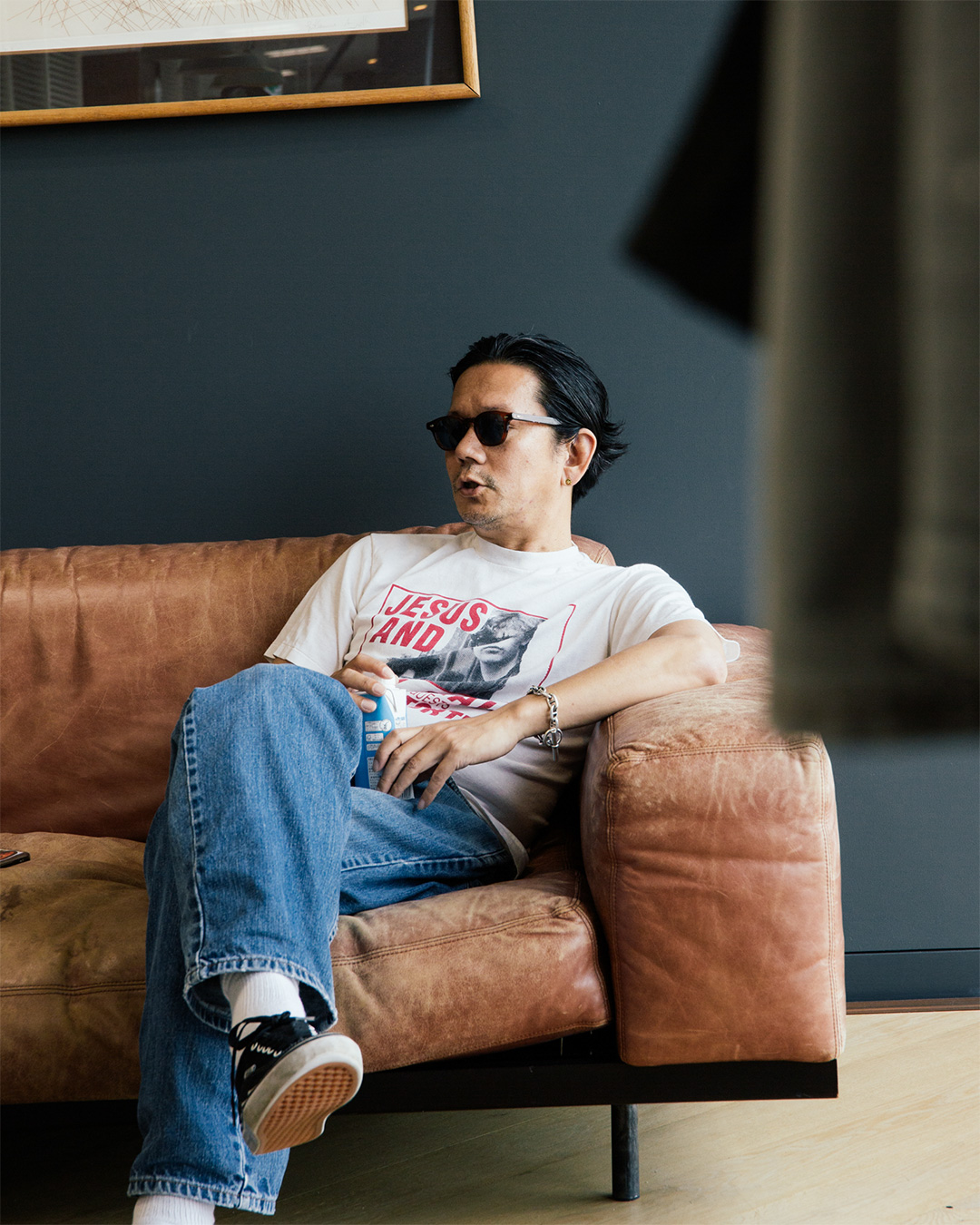
How did this project first come about?
S (Shinsuke Nakada): Around Christmas in 2017, Kunichi-san was looking for a jacket, so I gave him a Beams-exclusive Dickies set-up as a gift. He really liked it, and I remember him saying, “Let’s make one for younger people, too.”
K (Kunichi Nomura): That was around the time a friend of mine had passed away, and everyone at the company had to attend the funeral. But none of us owned a proper suit for formal occasions. One guy showed up in this oversized double-breasted morning suit and got mistaken for a funeral director. It just looked ridiculous—like the suit was wearing him. Some of our younger friends didn’t have suits either and said, “They’re too expensive.” So I looked up what a cheap one costs, and even then, it was still about 50,000 yen. I remembered when I was a college student, people needed a suit for the entrance ceremony and would buy something from United Arrows or Paul Smith—but even that was expensive for us back then. So I thought: we need something affordable, something my team could wear, and something young people could wear too.
Then I started thinking, “If we were to make a suit, what would that even look like?” Since we come from an interior design background, we were always on job sites wearing Dickies and Carhartt. A suit like that would feel the most like us. That’s when Nakada—who was still at Beams at the time—said, “If it’s Dickies, we might be able to make it happen.” I never imagined we’d get to make something with Dickies, so I was hyped. That was the beginning. What I absolutely wasn’t willing to compromise on were the price point and the fabric. When we wore Dickies, sure, it was kind of a fashion thing, but we were mostly drawn to how tough and affordable it was. I’d seen so many collaborations where a good, affordable piece suddenly doubled or tripled in price just because another brand’s name got slapped on it—and that always pissed me off. I wanted to keep it at Dickies pricing. Also, if the durability of that poly-cotton blend is what makes Dickies great, but then you switch it out for some totally different fabric, what’s the point of doing it with Dickies in the first place? So it had to be that signature Dickies fabric. I don’t mean to sound self-important, but those were really my only non-negotiables. I’m not a fashion designer, after all.
S: The most important condition from Kunichi was the price. He was adamant that it had to be affordable for younger people.
K: We started with TW (poly-wool), right? It’s wool, but inexpensive, and includes the signature polyester that’s so typical of Dickies. Some kids can’t even afford to buy a proper coat in winter, so we made the shoulders roomy enough to fit a hoodie or sweatshirt underneath—that was a must. And since a lot of people around us skate or ride bikes, we tapered the pants and made them a bit shorter so they wouldn’t catch on anything or get stepped on.
Getting the shoulder construction right was especially hard. Dickies isn’t a suit company, so adjusting the shoulders was incredibly tricky. I remember we had to make sample after sample.
S: Beams had made Dickies set-ups before, but to be honest, we didn’t really know how to sell them. When Kunichi brought this idea to me, we reworked it to really fit his concept—like incorporating a slightly boxy work-jacket silhouette. Getting the shoulder construction right was especially hard. Dickies isn’t a suit company, so adjusting the shoulders was incredibly tricky. I remember we had to make sample after sample.
K: Yeah, the factory wasn’t used to that kind of thing. They can make a proper work jacket without any problems, but when we asked for something that drapes nicely on the shoulders like a real suit, it just didn’t translate. We cut a lot of corners in places that didn’t matter—like skipping sleeve buttons or vents—but the key areas, we really focused on.
What was Dickies’ response at the time?
K: When we released the first one, they got in touch and said, “This is insane! They sold out immediately.” A lot of our friends couldn’t even get one. So we figured, “Alright, let’s do another round.” But we didn’t want to just repeat the same thing, so we decided to try a tweed version. We asked them to help source a low-cost tweed that had some polyester in it.
Just doing another suit set felt a little flat, so that time we added a matching flat cap and hand warmers. I remember tons of people around me actually wore the hand warmers—it looked great with rider jackets and other outerwear. The vibe that time was inspired by Basquiat. You know how he used to wear tweed jackets a lot? I thought it would be cool if we could channel a bit of that energy.
Usually, when I make a new one, I end up giving the old version away to someone. But that tweed version—I’ve still got it. The fabric weight, the way it drapes… it turned out really well.
The suit gets updated every season—how do you usually decide on the theme or direction?
S: The approach is kind of like Kunichi notices something while wearing it, and then we improve it from there. So we keep refining the design in line with that.
K: After the tweed version, we thought about how Japan keeps getting hotter, so we decided to go with a lightweight suit that could work for three seasons. The regular Dickies work shirt fabric felt a little too thin—wasn’t sure it would hold up—so we had them make a slightly thicker poly-cotton material. We wanted it to be unlined and something you could just throw on anywhere. Technically it was for spring, but if you wore Heattech underneath, you could wear it in winter too. So we were like, “Hey, this thing’s practically all-season!” I think we also made a baseball cap to go with it that time, right?
S: We did! Unfortunately, the release ended up overlapping with the pandemic. It was right during the first lockdown, and we had a really solid product, but couldn’t properly sell it. I remember it being super frustrating. Originally, the plan was to drop it right after the tweed version, back-to-back—but everything got delayed, and we didn’t release until May. We were really nervous it might miss the selling window entirely.
K: Yeah, that was when people couldn’t even come to the stores. Ever since we started making these Dickies suits, I’ve been getting tons of DMs—stuff like, “I want one to wear to my graduation.” I don’t usually read DMs, but when we’re about to launch something, I start checking, so I can catch any problems as they arise. This was around the time I started to feel pressure, like “Okay, I’ve really gotta make the next one good”. People would complain about how the suits were being sold, or say, “They’re being resold on the gray market for twice the price—what are you going to do about it?” I mean, I was just making the suits and putting them out there with good intentions, but somehow, I was getting royally told off for it, haha!
S: That was around the time when I was kind of scared to see Kunichi after each release. Like, “Oh no, we’ve got a ton of complaints…” We kept using that lightweight poly-cotton for two seasons and tried out a bunch of different colors.
K: Yeah, it was super wearable and inexpensive. I really came to appreciate the ease of an unlined suit. What did we do the following year?
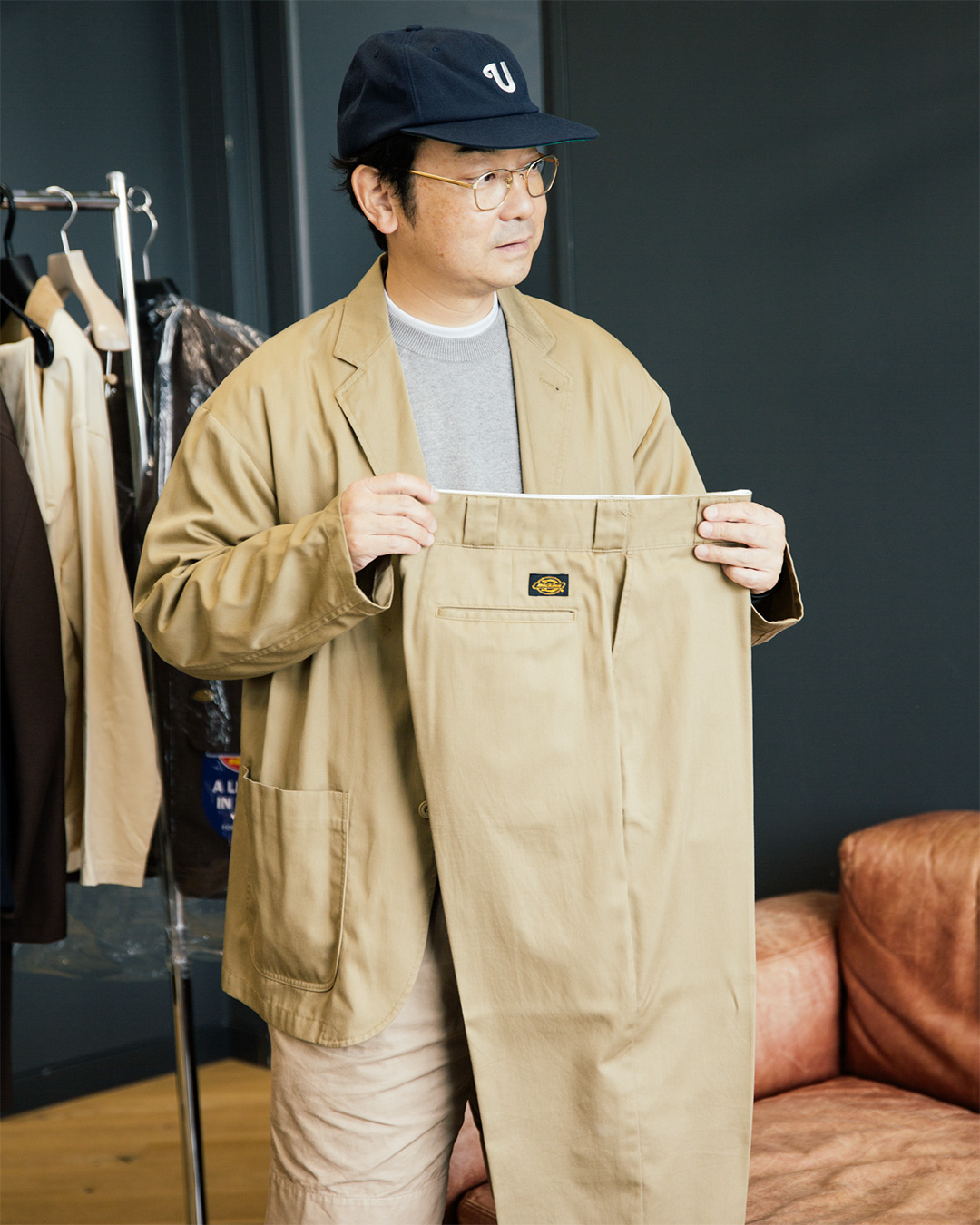
S: In 2023, we used a wool-polyester blend—also made to be wearable across three seasons. That year, we also introduced the removable jacket name tag for the first time. Speaking of tags, Dickies normally doesn’t allow any custom tag colors nowadays, but the only exception they’ve made is for Kunichi’s suits. The black-and-gold color combo was used a lot by American store brands in the late ’60s to ’70s.
K: Yeah, when they said we could change the tag color, I insisted on black and gold. If a suit has a brightly colored tag, it just doesn’t look like a proper suit anymore.
S: That color combo really became an icon. If we went with the standard colorway, it would suddenly look a bit too cute or pop.
K: Some people probably don’t want the tag visible on both the top and bottom pieces. Personally, I prefer it with nothing at all, so I thought making the tag removable was a good idea. In the early models, it was sewn in, but we switched to hand-stitched four-point fastening.
S: That year, we timed the release so it would be ready for graduation ceremonies and job orientation, and we even offered embroidered name tags for the suits.
K: Someone sent me a photo of a kid wearing it to their entrance ceremony— at the Ministry of Finance. It really moved me. Another guy said they were asked if it was a hand-me-down from their parents because of how oversized it looked, and he just said, “Yeah”.
S: The suit with “Nomura” embroidered on it was actually a farewell gift when I left Beams.
K: You make it sound like I died or something!
It seems like all the announcements go out through Kunichi-san’s Instagram, but could you tell us more about how you promote the line?
K: Once the samples are ready, I bring in T-shirts, shirts, or sneakers from home—whatever matches the colors—and I ask whoever’s around at the office that day to take pictures of me on my phone. That’s it. Beams reposts the photos, and just like that, they’ve sold every time.
S: The idea was to keep the price down by not spending money on PR.
K: Yeah, we didn’t spend a single yen on shoots or anything like that. I modeled for it myself simply so we don’t have to pay anyone to do it! We were really making an effort to keep the suits affordable… and then those damn resellers started getting involved. When we described the products, we’d keep it super simple. I figured the best way to show what the suit was about was just to show how I would wear it myself—paired with my own stuff. We kept doing that for a while, but then in 2022, VF Japan was launched, and a friend of mine became their marketing director.
This was still during the tail end of COVID, so they hadn’t been able to do much PR. VF Japan said they’d fund a campaign video and asked us to make one—but from my side, I was like, “I don’t want this to be sold on Dickies Japan’s online store.” I mean, we’re making this for Beams. If it gets sold elsewhere, their sales go down, and the whole point of keeping it affordable falls apart. So yeah, I pushed back pretty hard!
Anyway, that’s how we ended up making a video in 2023. We called it “Menswear by Dickies,” like a tongue-in-cheek nod to those classic suit store names in Japan. People think of Dickies as workwear, but we wanted to say, “No no, Dickies does ‘proper’ menswear too.” Old menswear commercials always had random blond women in them for some reason, or a luxury car rolling up—I remembered all that and just mashed it together. It’s supposed to look like it’s claiming to be “luxurious,” yet it’s obviously not, and that juxtaposition is what made it fun.
I was out drinking the night before the shoot, and ran into a friend who used to be a dancer. I asked her to be in it and she said yes right away. Even the catchphrase “Menswear by Dickies” was something we just came up with on the spot and had her shout it in the video.
Then, when we started planning the 2024 version, we reflected on something from the past runs. A lot of people really loved the lightweight poly-cotton suits, including folks at my office. Especially the pants—everyone wore them a ton because they were light and comfortable, even in summer. But since they had cotton in them, the color would fade in the wash. Someone showed up wearing a suit one day, and it had become completely two-tone! When they said, “Isn’t this kind of a cool, worn-in look?” I realized, wow, we really messed up here, haha.
I’d mostly worn the beige ones, and those were fine. But the other colors—especially black—faded badly. So we decided: it’s time to break up with cotton.
S: Well, just for the time being, anyway! We’re going to give cotton a break.
You can fold it up, take it on a trip, wear it every day, and if it gets dirty, you can literally wash it in the sink in your hotel room and wear it again the next day.
K: Young people don’t send their clothes to the cleaners. I don’t either. You wear a suit to a wedding, get totally wrecked at the after-party, and just keep wearing it like nothing happened. That’s why wool didn’t feel right—it wouldn’t survive that. So we asked them to find a fabric that was 100% polyester. The selling points were: washable, fade-resistant, and quick-drying.
To show that, we shot a scene for the video where I dumped water on myself, and by the time we’d spent 30 minutes adjusting camera angles and lighting, the surface of the suit had already dried. That was a happy accident. We also shot a scene where ketchup was spilled on a light blue suit, and I was thinking, “This had better be a one-time promo or we’re screwed.” But guess what? We just rubbed it with a wet wipe and it came right off! We didn’t even need a laundry scene. That was another welcome surprise. It’s been seven years now, but function-wise, last year’s model felt like the culmination. You can fold it up, take it on a trip, wear it every day, and if it gets dirty, you can literally wash it in the sink in your hotel room and wear it again the next day. It doesn’t wrinkle easily, it’s tough, and unless you fall off your skateboard and tear a hole in it, that black suit will hold up for a long time.
Now that we’ve seen what polyester can do, I’m thinking we should stick with it for 2025 too. But last year’s fabric leaned a little too techy—I mean, it looked polyester—so this time we’re asking for something with a bit more of a twill texture. Up to now, we’ve made small changes—adding or removing a chest pocket, tweaking the silhouette of the pants—but since we’re doing polyester for the second year in a row, I felt it was time for a change in cut that felt significant to me, even if most people wouldn’t notice. Specifically, we’re keeping the same body width but shortening the jacket length and narrowing the chest opening a bit for a more dressy look. We added pleats to the pants and widened the fit slightly. We also added a coin pocket which wasn’t there originally.
S: So just to recap the materials we’ve used: 2018 was wool-poly flannel, 2019 was wool-poly tweed, 2020 and 2021 were cotton-poly lightweight twill, 2023 was a 3-season wool-poly serge, 2024 was polyester, and 2025 will be polyester twill.
Are there any past models you’re particularly fond of?
K: Honestly, they all mean something to me. I’m not someone who wears suits very often, but I’ve worn these Dickies suits to my kid’s school entrance ceremonies, graduations, funerals, and weddings. And I feel like more and more people around me are doing the same.
I even wore one paired with Vans sneakers to the Vanity Fair Oscars after-party. That’s one of the most prestigious events in Hollywood—right up there with the Met Gala. Everyone was like, “Did you seriously show up in an oversized suit and a pair of Vans?” I was like, “What’s wrong with that?” But to be honest, internally, I was going “uh-oh”—my toes were kind of curling inside my shoes. I mean, everyone else was in tuxedos and leather shoes.
But then, when I was in the smoking area, some actors made some comments like, “These dress shoes are killing me. I’m totally wearing a suit with sneakers next year.” Comfort wins!
Steven Yeun—the actor from The Walking Dead—really wanted one too, so I gave him a suit. Later, he was selected by GQ as one of their best dressers or some such and he messaged me saying, “Kun, they saying I got style!” I was like, “Hell yeah!” There’ve been a lot of special moments like that.
I’m also good friends with James Murphy, the frontman of LCD Soundsystem. He loves suits and always wears a blazer—often from Comme des Garçons—over a T-shirt when he performs. He came to Japan to DJ for my birthday last year, so I gave him a suit as a thank-you. He’s pretty big, both tall and broad, so the oversized fit was actually just right on him. He was like, “This was made for me.” And since it’s 100% polyester, he can sweat through it during a show, wash it, and wear it again the next day. James said he wanted the suit in every color, so I went out and bought them at the shop for him. I think he wore them throughout the whole tour.
When footage of them playing at Glastonbury came out, he was wearing the suit—and you could see the gold tag peeking out here and there. It’s really gratifying to see your friends actually wearing something and loving it.
It’s also moving to see young people tagging the suits on social media when they wear them to their coming-of-age ceremonies or graduations. It feels like I got to be there for a meaningful moment in their lives. All I can say is: congratulations to all of you.
It was a team effort to bring Kunichi’s ideal into form, balancing price and quality while still nailing the essential details. I still remember how happy I was when we finished the final sample and he was genuinely pleased—it felt like we had earned his approval.
S: I’ll always have a special place in my heart for the first model or the tweed version that came after it. Even though we were a select shop, this project was one of the first opportunities for people to really see how seriously we approach making things.
It was a team effort to bring Kunichi’s ideal into form, balancing price and quality while still nailing the essential details. I still remember how happy I was when we finished the final sample and he was genuinely pleased—it felt like we had earned his approval.
As for the tweed, when you look at old American photo books, you’ll see miners and lumberjacks wearing it. So aside from its traditional use in tailoring, it also made sense as a workwear fabric. The story connected naturally, and I really liked that.
It was a refined material, but with polyester added for improved durability. I think it struck a really nice balance—true to the spirit of Dickies, without straying too far from what the brand is about. It landed right between workwear and menswear, and I think we managed to make something both fun and authentic.
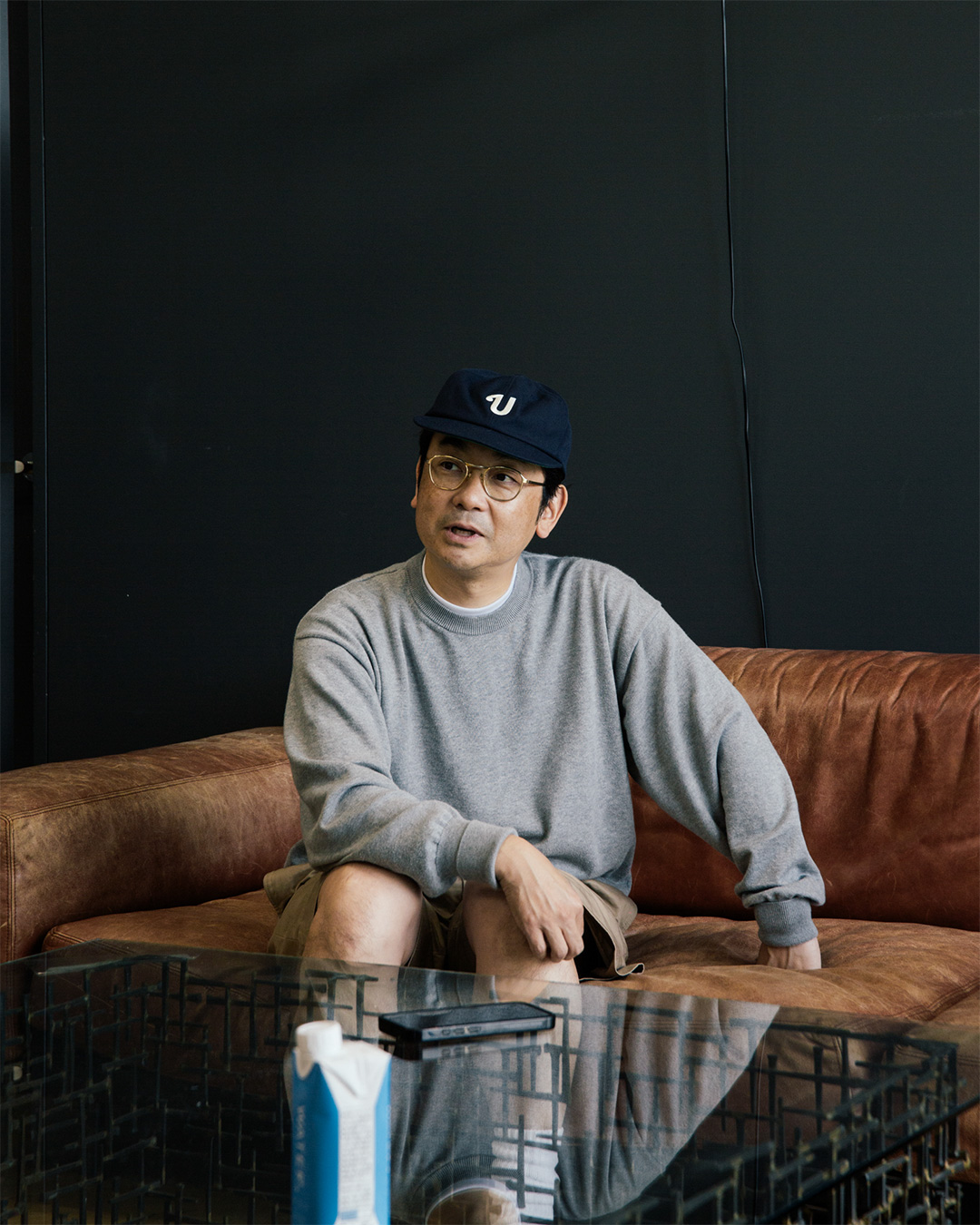
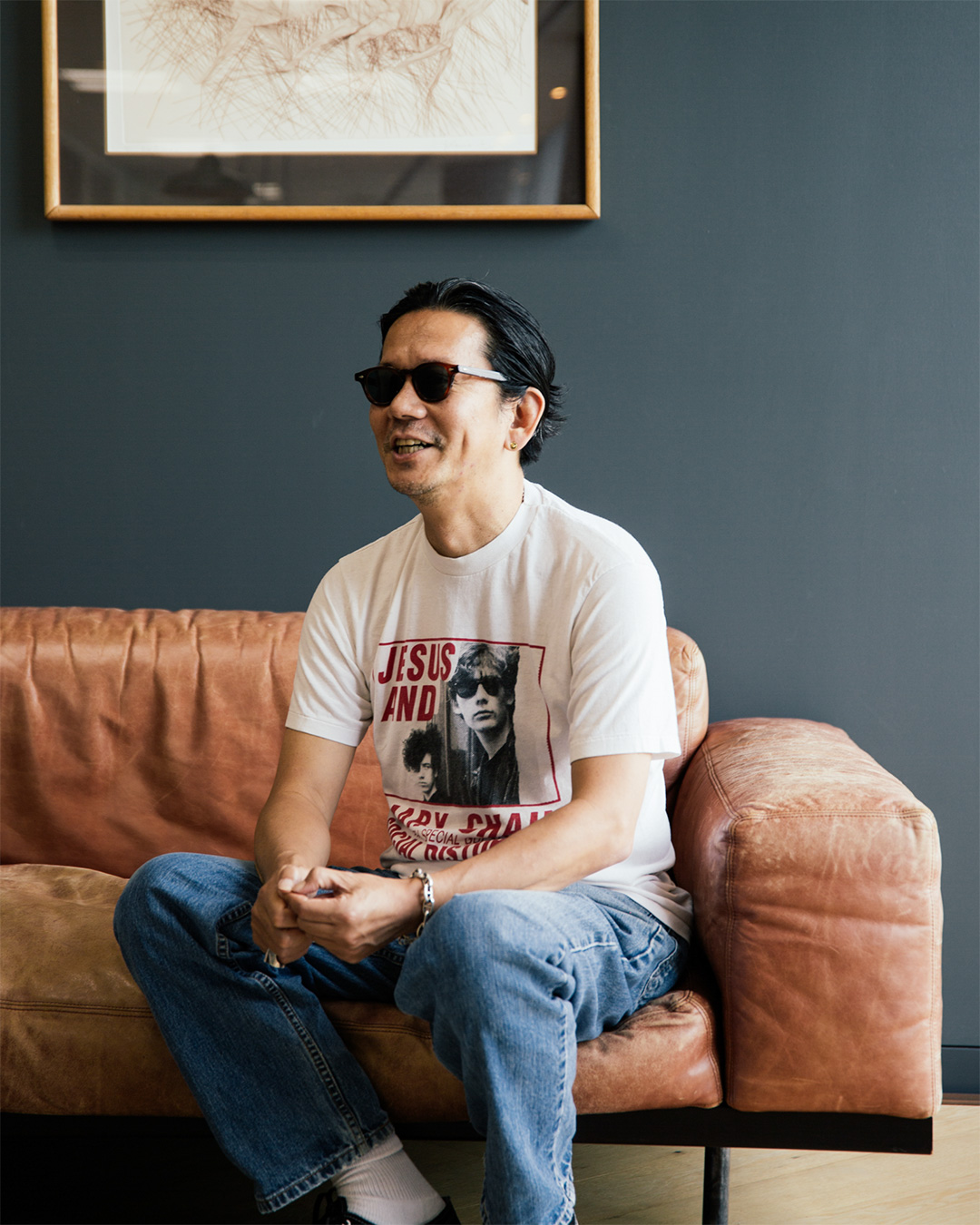
K: Oh yeah, speaking of which—we did cheat once and made a suit with Carhartt. That was a tough project though. We started talking during the pandemic, and the first samples were made by Carhartt Japan, but they didn’t quite work out. We had to redo them a few times, and when we finally had something we liked, the guys at Carhartt Japan sent it to HQ for approval.
They liked it so much they said, “Let’s sell this internationally.” But once it became an HQ project, production shifted to a different factory, so we had to make a whole new set of samples. Even though we’d sent them our samples and pattern specs, what came back was totally different. We had to redo everything again, and just when we were ready to go into production, the factory in Vietnam went into lockdown. On top of that, material costs started going up, so we had to raise the price. In the end, it took about two years before we could release it.
That was actually the first time someone gave us a budget and asked us to make a video. Up until then, I’d just been shooting everything on my iPhone, so I was like, “Whoa, we get a budget now?” Looking back though, I gotta say it wasn’t exactly a lot!
The theme I had in mind was “Work & Date”. During the day, you’d wear it like a work jacket and carpenter pants on site, and then in the evening, you’d open up the lapels, throw on a nice shirt, and head straight to a date. Everyone in the video was paid in product. For the shoot, they brought things they actually use at work during the day, and for the night scenes, the married guys played out scenarios like apologizing to their wives with gifts, haha.
Surprisingly, the video got a great response overseas, and a few other brands asked me to do something similar. But if you don’t really understand the product, it just ends up looking like you’re messing around. Like yeah, we poured water over people in the Dickies video, and it might seem silly, but it still clearly communicates the features of the product.
We only put out one model per year under the same item number. I mean, doesn’t that technically make us one of the top suit sellers in Japan right now?
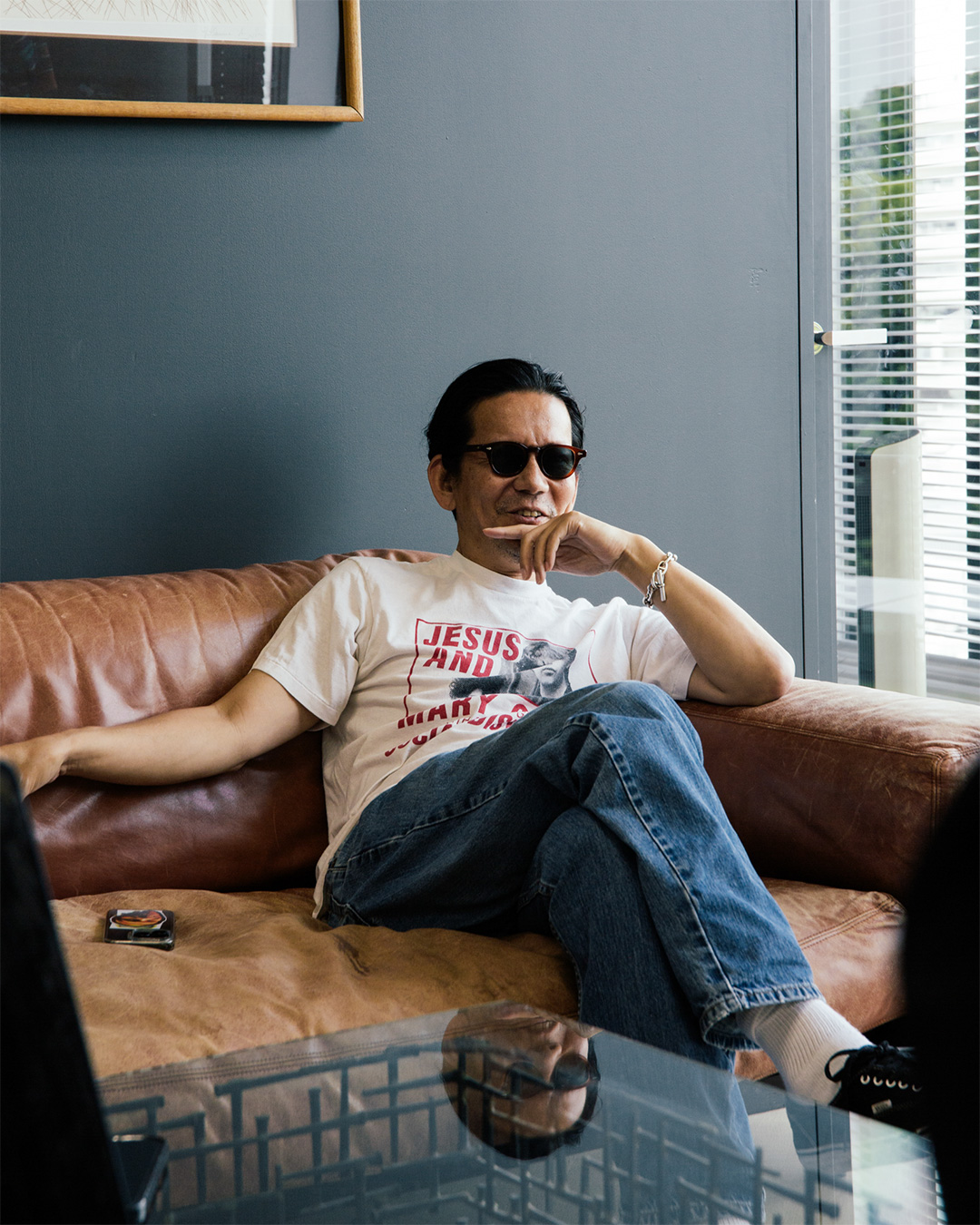
Looking back, would you say the suits have gradually become more in line with traditional suits over the years?
K: Yeah, I think so. That’s partly because more and more people are wearing them in formal settings. So, we made sure the suits were appropriate for formal occasions—but at the same time, it’s totally fine to wear them in a more casual, workwear kind of context too.
S: We started to realize that end users were really wearing them as proper suits, and that pushed us to lean more in that direction with the design.
K: Like I said earlier, I started checking DMs around launch time—just to make sure there weren’t any issues with quality or anything. And by doing that, I’ve been able to get a better sense of how people are actually wearing them and what they’re using them for.
The reason we shortened the jacket length this time is because we realized that pulling off a longer cut can be kind of challenging. Some people weren’t styling it in the best way, and that’s when I thought maybe we should help make that easier by adjusting it on our end.
That kind of thing matters. It makes me happy to know that we’re creating something people wear on meaningful occasions. Also, like in that Carhartt video I mentioned—there’s something cool about dressing up a little differently for once, taking someone you’re into out for a nice meal and sweet-talking to them and all that. I want younger guys to feel like, “Yeah, this suit is just right for that.” At this price point, it’s attainable.
S: It’s already the seventh year, but people wearing the suits for things like entrance ceremonies or graduations are a new group every time. So we can’t stop now! If we did, Kunichi’s DMs would probably blow up…
K: You think so? Even though we’ve got different SKUs and color variations, we only put out one model per year under the same item number. I mean, doesn’t that technically make us one of the top suit sellers in Japan right now?
S: I don’t know about the total yearly numbers, but in terms of volume sold per single drop, I’d say we might have a good case for being number one in Japan.
K: And that’s coming from people who don’t even usually wear suits! Maybe that’s why people put extra effort into how they wear them. A suit is something you rarely wear, but when you need it, you really need it. Having made them myself, I’ve come to realize just how essential suits actually are.
S: When you make stuff continuously, you often have to invent reasons for why someone should buy it. But this is one of the rare projects where the purpose is real, it truly resonates with people, and it actually leads to sales. It feels like a mission, in the best way.
We’re already looking forward to the next installment.
K: We’re currently in the process of sourcing materials.
S: We’re desperately searching for a fabric that feels like the return of something special—it’s been a while! And next time, there’s going to be a brand-new item added to the lineup. We’re reviewing various reference images that Kunichi shared with us, discussing how to balance the sizing and how we can update the design to make it feel fresh and relevant today. With his unique touches added in, I think we’ll be able to offer something really exciting. I’m genuinely looking forward to this project too.
KUNICHI NOMURA @kunichi_nomura
SHINSUKE NAKADA @nakadashinsuke




